
Andrei Karlov
Andrei Gennadyevich Karlov was a Russian diplomat who served as the Russian ambassador to Turkey and earlier as the Russian ambassador to North Korea.
Andrei Karlov (pictured), Russia's ambassador to Turkey, was assassinated at an art gallery in Ankara.

Andrei Gennadyevich Karlov was a Russian diplomat who served as the Russian ambassador to Turkey and earlier as the Russian ambassador to North Korea.
Andrei Karlov, the Russian Ambassador to Turkey, was assassinated by Mevlüt Mert Altıntaş, an off-duty Turkish police officer, at an art exhibition in Ankara, Turkey on the evening of 19 December 2016. The assassination took place after several days of protests in Turkey over Russian involvement in the Syrian Civil War and the battle over Aleppo.

Ankara, historically known as Ancyra and Angora, is the capital of Turkey. Located in the central part of Anatolia, the city has a population of 5.1 million in its urban center and over 5.7 million in Ankara Province, making it Turkey's second-largest city after Istanbul.
Russian ambassador to Turkey Andrei Karlov is assassinated while at an art exhibition in Ankara. The assassin, Mevlüt Mert Altıntaş, is shot and killed by a Turkish guard.

Andrei Gennadyevich Karlov was a Russian diplomat who served as the Russian ambassador to Turkey and earlier as the Russian ambassador to North Korea.
Andrei Karlov, the Russian Ambassador to Turkey, was assassinated by Mevlüt Mert Altıntaş, an off-duty Turkish police officer, at an art exhibition in Ankara, Turkey on the evening of 19 December 2016. The assassination took place after several days of protests in Turkey over Russian involvement in the Syrian Civil War and the battle over Aleppo.

Ankara, historically known as Ancyra and Angora, is the capital of Turkey. Located in the central part of Anatolia, the city has a population of 5.1 million in its urban center and over 5.7 million in Ankara Province, making it Turkey's second-largest city after Istanbul.
A vehicular attack in Berlin, Germany, kills and injures multiple people at a Christmas market.
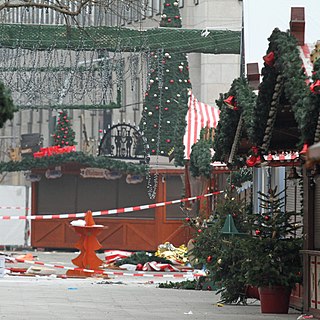
On 19 December 2016, a truck was deliberately driven into the Christmas market next to the Kaiser Wilhelm Memorial Church at Breitscheidplatz in Berlin, leaving 12 people dead and 56 others injured. One of the victims was the truck's original driver, Łukasz Urban, who was found shot dead in the passenger seat. The truck was eventually stopped by its automatic brakes. The perpetrator was Anis Amri, an unsuccessful asylum seeker. Four days after the attack, he was killed in a shootout with police near Milan in Italy. An initial suspect was arrested and later released due to lack of evidence. Nearly five years after the attack, a man who was critically injured during the attack died from complications related to his wounds, becoming the 13th victim.

A Christmas market, also known as Christkindlmarkt, Christkindlesmarkt, Christkindlmarket, Christkindlimarkt, and Weihnachtsmarkt, is a street market associated with the celebration of Christmas during the four weeks of Advent. These markets originated in Germany, but are now held in many countries. Christmas markets date to the Late Middle Ages in the German-speaking part of Europe and in many parts of the former Holy Roman Empire that included many eastern regions of France. They became a popular Advent custom during the Reformation era.
The European Space Agency's Gaia space observatory was launched, with the goal of constructing the largest and most precise star catalogue ever made.

The European Space Agency is an intergovernmental organisation of 22 member states dedicated to the exploration of space. Established in 1975 and headquartered in Paris, ESA has a worldwide staff of about 2,200 in 2018 and an annual budget of about €7.2 billion in 2022.

Gaia is a space observatory of the European Space Agency (ESA), launched in 2013 and expected to operate until 2025. The spacecraft is designed for astrometry: measuring the positions, distances and motions of stars with unprecedented precision. The mission aims to construct by far the largest and most precise 3D space catalog ever made, totalling approximately 1 billion astronomical objects, mainly stars, but also planets, comets, asteroids and quasars, among others.

A star catalogue is an astronomical catalogue that lists stars. In astronomy, many stars are referred to simply by catalogue numbers. There are a great many different star catalogues which have been produced for different purposes over the years, and this article covers only some of the more frequently quoted ones. Star catalogues were compiled by many different ancient people, including the Babylonians, Greeks, Chinese, Persians, and Arabs. They were sometimes accompanied by a star chart for illustration. Most modern catalogues are available in electronic format and can be freely downloaded from space agencies' data centres. The largest is being compiled from the spacecraft Gaia and thus far has over a billion stars.
Spacecraft Gaia is launched by European Space Agency.

Gaia is a space observatory of the European Space Agency (ESA), launched in 2013 and expected to operate until 2025. The spacecraft is designed for astrometry: measuring the positions, distances and motions of stars with unprecedented precision. The mission aims to construct by far the largest and most precise 3D space catalog ever made, totalling approximately 1 billion astronomical objects, mainly stars, but also planets, comets, asteroids and quasars, among others.

The European Space Agency is an intergovernmental organisation of 22 member states dedicated to the exploration of space. Established in 1975 and headquartered in Paris, ESA has a worldwide staff of about 2,200 in 2018 and an annual budget of about €7.2 billion in 2022.
Park Geun-hye is elected the first female president of South Korea.

Park Geun-hye is a South Korean politician who served as the 11th president of South Korea from 2013 to 2017, until she was impeached and convicted on related corruption charges.

Presidential elections were held in South Korea on 19 December 2012. They were the sixth presidential elections since democratization and the establishment of the Sixth Republic, and were held under a first-past-the-post system, in which there was a single round of voting and the candidate receiving the highest number of votes was elected. Under the South Korean constitution, a president is restricted to a single five-year term in office. The term of the then incumbent president Lee Myung-bak ended on 24 February 2013. According to the Korea Times, 30.7 million people voted with turnout at 75.8%. Park Geun-hye of the Saenuri party was elected the first female South Korean president with 51.6% of the vote opposed to 48.0% for her opponent Moon Jae-in. Park's share of the vote was the highest won by any candidate since the beginning of free and fair direct elections in 1987 and the first such election in which any candidate won a majority.

The president of the Republic of Korea, also known as the president of South Korea, is the head of state and head of government of the Republic of Korea. The president leads the State Council, and is the chief of the executive branch of the national government as well as the commander-in-chief of the Republic of Korea Armed Forces.
A record high barometric pressure of 1,085.6 hectopascals (32.06 inHg) is recorded at Tosontsengel, Khövsgöl, Mongolia.
Atmospheric pressure, also known as barometric pressure, is the pressure within the atmosphere of Earth. The standard atmosphere is a unit of pressure defined as 101,325 Pa (1,013.25 hPa), which is equivalent to 1013.25 millibars, 760 mm Hg, 29.9212 inches Hg, or 14.696 psi. The atm unit is roughly equivalent to the mean sea-level atmospheric pressure on Earth; that is, the Earth's atmospheric pressure at sea level is approximately 1 atm.

The pascal is the unit of pressure in the International System of Units (SI), and is also used to quantify internal pressure, stress, Young's modulus, and ultimate tensile strength. The unit, named after Blaise Pascal, is defined as one newton per square metre and is equivalent to 10 barye (Ba) in the CGS system. The unit of measurement called standard atmosphere (atm) is defined as 101,325 Pa.
Inch of mercury is a non-SI unit of measurement for pressure. It is used for barometric pressure in weather reports, refrigeration and aviation in the United States.
Tosontsengel is a sum of Khövsgöl aimag. The area is 2,050 km2, of which 1,800 km2 are pasture and 11 km2 are farmland. In 2000, Tosontsengel had a population of 4,161 people, including some Khotgoid. The sum center, officially named Tsengel, is located 64 km east-southeast of Mörön and 607 km from Ulaanbaatar.

Mongolia is a landlocked country in East Asia, bordered by Russia to the north and China to the south. It covers an area of 1,564,116 square kilometres, with a population of just 3.3 million, making it the world's most sparsely populated sovereign nation. Mongolia is the world's largest landlocked country that does not border a closed sea, and much of its area is covered by grassy steppe, with mountains to the north and west and the Gobi Desert to the south. Ulaanbaatar, the capital and largest city, is home to roughly half of the country's population.
Argentine economic crisis: December riots: Riots erupt in Buenos Aires, Argentina.

The Argentine Great Depression was an economic depression in Argentina, which began in the third quarter of 1998 and lasted until the second quarter of 2002. It followed the fifteen years stagnation and a brief period of free-market reforms.
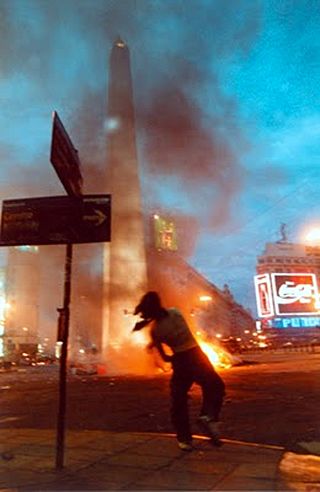
The December 2001 crisis, sometimes known as the Argentinazo, was a period of civil unrest and rioting in Argentina, which took place during December 2001, with the most violent incidents taking place on 19 and 20 December in the capital, Buenos Aires, Rosario and other large cities around the country. It was preceded by a popular revolt against the Argentine government, rallying behind the motto "All of them must go!", which caused the resignation of then-president Fernando de la Rúa, giving way to a period of political instability during which five government officials performed the duties of the Argentinian presidency. This period of instability occurred during the larger period of crisis known as the Argentine great depression, an economic, political, and social crisis that lasted from 1998 until 2002.

Buenos Aires, officially the Autonomous City of Buenos Aires, is the capital and primate city of Argentina. The city is located on the western shore of the Río de la Plata, on South America's southeastern coast. "Buenos Aires" can be translated as "fair winds" or "good airs", but the former was the meaning intended by the founders in the 16th century, by the use of the original name "Real de Nuestra Señora Santa María del Buen Ayre", named after the Madonna of Bonaria in Sardinia, Italy. Buenos Aires is classified as an alpha global city, according to the Globalization and World Cities Research Network (GaWC) 2020 ranking.

Argentina, officially the Argentine Republic, is a country in the southern half of South America. Argentina covers an area of 2,780,400 km2 (1,073,500 sq mi), making it the second-largest country in South America after Brazil, the fourth-largest country in the Americas, and the eighth-largest country in the world. It shares the bulk of the Southern Cone with Chile to the west, and is also bordered by Bolivia and Paraguay to the north, Brazil to the northeast, Uruguay and the South Atlantic Ocean to the east, and the Drake Passage to the south. Argentina is a federal state subdivided into twenty-three provinces, and one autonomous city, which is the federal capital and largest city of the nation, Buenos Aires. The provinces and the capital have their own constitutions, but exist under a federal system. Argentina claims sovereignty over the Falkland Islands, South Georgia and the South Sandwich Islands, and a part of Antarctica.
The Leninist Guerrilla Units wing of the Communist Labour Party of Turkey/Leninist attack a Nationalist Movement Party office in Istanbul, Turkey, killing one person and injuring three.
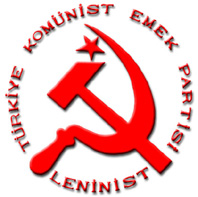
The Communist Labour Party of Turkey/Leninist is an illegal communist party in Turkey. TKEP/L was founded on September 1, 1990, following a split in the Communist Labour Party of Turkey (TKEP).
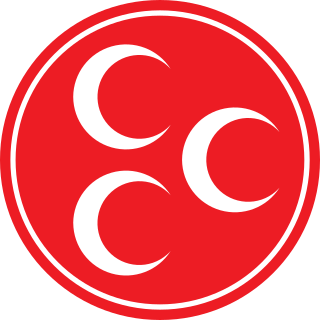
The Nationalist Movement Party is a Turkish far-right and ultranationalist political party. The group is often described as neo-fascist, and has been linked to some violent paramilitaries and organized crime groups. The party is represented by 48 MPs in the Turkish Parliament which support the AKP government. Its leader is Devlet Bahçeli.

Istanbul, formerly known as Constantinople, is the largest city in Turkey, serving as the country's economic, cultural and historic hub. The city straddles the Bosporus strait, lying in both Europe and Asia, and has a population of over 15 million residents, comprising 19% of the population of Turkey. Istanbul is the most populous European city, and the world's 15th-largest city.

Turkey, officially the Republic of Türkiye, is a transcontinental country located mainly on the Anatolian Peninsula in Western Asia, with a small portion on the Balkan Peninsula in Southeast Europe. It shares borders with the Black Sea to the north; Georgia to the northeast; Armenia, Azerbaijan, and Iran to the east; Iraq to the southeast; Syria and the Mediterranean Sea to the south; the Aegean Sea to the west; and Greece and Bulgaria to the northwest. Cyprus is located off the south coast. Turks form the vast majority of the nation's population and Kurds are the largest minority. Ankara is Turkey's capital, while Istanbul is its largest city and financial centre.
President Bill Clinton is impeached by the United States House of Representatives, becoming the second President of the United States to be impeached.

William Jefferson Clinton is an American politician who served as the 42nd president of the United States from 1993 to 2001. He previously served as governor of Arkansas from 1979 to 1981 and again from 1983 to 1992, and as attorney general of Arkansas from 1977 to 1979. A member of the Democratic Party, Clinton became known as a New Democrat, as many of his policies reflected a centrist "Third Way" political philosophy. He is the husband of Hillary Clinton, who was a senator from New York from 2001 to 2009, secretary of state from 2009 to 2013 and the Democratic nominee for president in the 2016 presidential election.

Bill Clinton, the 42nd president of the United States, was impeached by the United States House of Representatives of the 105th United States Congress on December 19, 1998, for "high crimes and misdemeanors". The House adopted two articles of impeachment against Clinton, with the specific charges against Clinton being lying under oath and obstruction of justice. Two other articles had been considered but were rejected by the House vote.

The United States House of Representatives, often referred to as the House of Representatives, the U.S. House, or simply the House, is the lower chamber of the United States Congress, with the Senate being the upper chamber. Together they comprise the national bicameral legislature of the United States.

Impeachment is the process by which a legislative body or other legally constituted tribunal initiates charges against a public official for misconduct. It may be understood as a unique process involving both political and legal elements.
SilkAir Flight 185 crashed into the Musi River in Indonesia, killing 104 people.

SilkAir Flight 185 was a scheduled international passenger flight operated by a Boeing 737-300 from Soekarno–Hatta International Airport in Jakarta, Indonesia to Changi Airport in Singapore that crashed into the Musi River near Palembang, Sumatra, on 19 December 1997, killing all 97 passengers and seven crew on board.

The Musi River is a river in Southern Sumatra, Indonesia. It flows from south-west to north-east, from the Barisan Mountains range that form the backbone of Sumatra, in Kepahiang Regency, Bengkulu Province, to the Bangka Strait that forms an extension of the South China Sea. It is about 750 kilometers long, and drains most of South Sumatra province. After flowing through Palembang, the provincial capital, it joins with several other rivers, including the Banyuasin River, to form a delta near the town of Sungsang. The river, dredged to a depth of about 6.5 meters, is navigable by large ships as far as Palembang, which is the site of major port facilities used primarily for the export of petroleum, rubber and palm oil.
Titanic, the third-highest-grossing film of all time, with a worldwide total of more than US$1.8 billion, was released in the United States.
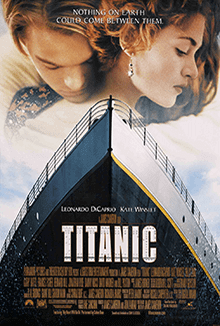
Titanic is a 1997 American epic romance and disaster film directed, written, produced, and co-edited by James Cameron. Incorporating both historical and fictionalized aspects, it is based on accounts of the sinking of the RMS Titanic and stars Leonardo DiCaprio and Kate Winslet as members of different social classes who fall in love aboard the ship during its ill-fated maiden voyage. Also starring are Billy Zane, Kathy Bates, Frances Fisher, Gloria Stuart, Bernard Hill, Jonathan Hyde, Victor Garber, and Bill Paxton.
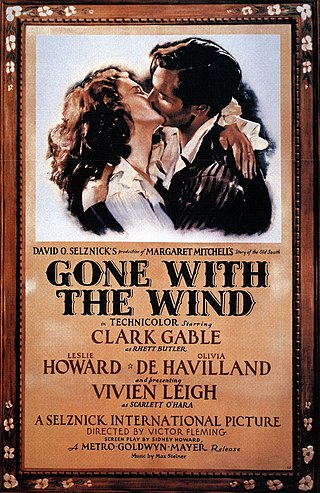
Films generate income from several revenue streams, including theatrical exhibition, home video, television broadcast rights, and merchandising. However, theatrical box-office earnings are the primary metric for trade publications in assessing the success of a film, mostly because of the availability of the data compared to sales figures for home video and broadcast rights, but also because of historical practice. Included on the list are charts of the top box-office earners, a chart of high-grossing films by calendar year, a timeline showing the transition of the highest-grossing film record, and a chart of the highest-grossing film franchises and series. All charts are ranked by international theatrical box-office performance where possible, excluding income derived from home video, broadcasting rights, and merchandise.
SilkAir Flight 185 crashes into the Musi River, near Palembang in Indonesia, killing 104.

SilkAir Flight 185 was a scheduled international passenger flight operated by a Boeing 737-300 from Soekarno–Hatta International Airport in Jakarta, Indonesia to Changi Airport in Singapore that crashed into the Musi River near Palembang, Sumatra, on 19 December 1997, killing all 97 passengers and seven crew on board.

The Musi River is a river in Southern Sumatra, Indonesia. It flows from south-west to north-east, from the Barisan Mountains range that form the backbone of Sumatra, in Kepahiang Regency, Bengkulu Province, to the Bangka Strait that forms an extension of the South China Sea. It is about 750 kilometers long, and drains most of South Sumatra province. After flowing through Palembang, the provincial capital, it joins with several other rivers, including the Banyuasin River, to form a delta near the town of Sungsang. The river, dredged to a depth of about 6.5 meters, is navigable by large ships as far as Palembang, which is the site of major port facilities used primarily for the export of petroleum, rubber and palm oil.

Palembang is the capital city of the Indonesian province of South Sumatra. The city proper covers 400.61 square kilometres on both banks of the Musi River on the eastern lowland of southern Sumatra. It had a population of 1,668,848 at the 2020 Census. Palembang is the second most populous city in Sumatra, after Medan, and the ninth most populous city in Indonesia.

Indonesia, officially the Republic of Indonesia, is a country in Southeast Asia and Oceania between the Indian and Pacific oceans. It consists of over 17,000 islands, including Sumatra, Java, Sulawesi, and parts of Borneo and New Guinea. Indonesia is the world's largest archipelagic state and the 14th-largest country by area, at 1,904,569 square kilometres. With over 275 million people, Indonesia is the world's fourth-most populous country and the most populous Muslim-majority country. Java, the world's most populous island, is home to more than half of the country's population.
The United States Government restores federal recognition to the Nottawaseppi Huron Band of Potawatomi Native American tribe.

The Nottawaseppi Huron Band of Potawatomi (NHBP) is a federally-recognized tribe of Potawatomi in the United States. The tribe achieved federal recognition on December 19, 1995, and currently has approximately 1500 members.
Joe Cole, American roadie and author, is killed in an armed robbery
Joseph Dennis Cole was an American actor, writer and roadie for Black Flag and Rollins Band, who was shot and killed in an armed robbery on December 19, 1991.
Mikhail Gorbachev, leader of the Soviet Union, releases Andrei Sakharov and his wife from exile in Gorky.

Mikhail Sergeyevich Gorbachev was a Soviet politician who served as the 8th and final leader of the Soviet Union from 1985 to the country's dissolution in 1991. He served as General Secretary of the Communist Party of the Soviet Union from 1985 and additionally as head of state beginning in 1988, as Chairman of the Presidium of the Supreme Soviet from 1988 to 1989, Chairman of the Supreme Soviet from 1989 to 1990 and the only President of the Soviet Union from 1990 to 1991. Ideologically, Gorbachev initially adhered to Marxism–Leninism but moved towards social democracy by the early 1990s.

The Soviet Union, officially the Union of Soviet Socialist Republics (USSR), was a transcontinental country that spanned much of Eurasia from 1922 to 1991. A flagship communist state, it was nominally a federal union of fifteen national republics; in practice, both its government and its economy were highly centralized until its final years. It was a one-party state governed by the Communist Party of the Soviet Union, with the city of Moscow serving as its capital as well as that of its largest and most populous republic: the Russian SFSR. Other major cities included Leningrad, Kiev, Minsk, Tashkent, Alma-Ata, and Novosibirsk. It was the largest country in the world, covering over 22,402,200 square kilometres (8,649,500 sq mi) and spanning eleven time zones.

Andrei Dmitrievich Sakharov was a Soviet nuclear physicist, dissident, nobel laureate and activist for nuclear disarmament, peace, and human rights.

Exile is primarily penal expulsion from one's native country, and secondarily expatriation or prolonged absence from one's homeland under either the compulsion of circumstance or the rigors of some high purpose. Usually persons and peoples suffer exile, but sometimes social entities like institutions are forced from their homeland.
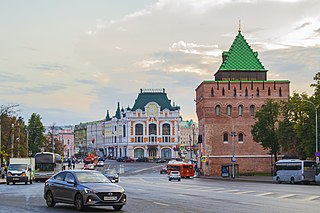
Nizhny Novgorod, colloquially shortened to Nizhny, from the 13th to the 17th century Novgorod of the Lower Land, formerly known as Gorky, is the administrative centre of Nizhny Novgorod Oblast and the Volga Federal District. The city is located at the confluence of the Oka and the Volga rivers in Central Russia, with a population of over 1.2 million residents, up to roughly 1.7 million residents in the urban agglomeration. Nizhny Novgorod is the sixth-largest city in Russia, the second-most populous city on the Volga, as well as the Volga Federal District. It is an important economic, transportation, scientific, educational and cultural center in Russia and the vast Volga-Vyatka economic region, and is the main center of river tourism in Russia. In the historic part of the city there are many universities, theaters, museums and churches.
Aeroflot Flight 101/435 was hijacked by the co-pilot and landed in a rice field in China, where he was apprehended.

Aeroflot Flight 101/435 was a Soviet domestic passenger flight that was hijacked by its co-pilot, Shamil Alimuradov, on 19 December 1985, en route from Takhtamygda to Chita. Armed with a hatchet, Alimuradov demanded that captain Vyacheslav Abramyan divert the Antonov An-24 aircraft to China. Soviet officials authorized the crew to land in China, and gave Abramyan the radio frequency of Qiqihar Airport, but Alimuradov demanded that Abramayan fly to Hailar instead. The aircraft ran out of fuel, and landed in a rice field. Alimuradov was apprehended by the Chinese, and the passengers were allowed to travel to Hailar and Harbin. On 21 December, the crew and all 46 passengers returned safely to the Soviet Union.
China and the United Kingdom signed the Sino-British Joint Declaration, agreeing to the transfer of sovereignty of Hong Kong to China on 1 July 1997.
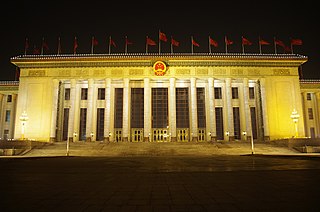
The Sino-British Joint Declaration is a treaty between the governments of the United Kingdom and China signed in 1984 setting the conditions in which Hong Kong was transferred to Chinese control and for the governance of the territory after 1 July 1997.

Sovereignty of Hong Kong was transferred from the United Kingdom to the People's Republic of China (PRC) at midnight on 1 July 1997. This event ended 156 years of British rule in the former colony. Hong Kong was established as a special administrative region of China (SAR) for 50 years, maintaining its own economic and governing systems from those of mainland China during this time, although influence from the central government in Beijing increased after the passing of the Hong Kong national security law in 2020.
The Sino-British Joint Declaration, stating that China would resume the exercise of sovereignty over Hong Kong and the United Kingdom would restore Hong Kong to China with effect from July 1, 1997, is signed in Beijing by Deng Xiaoping and Margaret Thatcher.

The Sino-British Joint Declaration is a treaty between the governments of the United Kingdom and China signed in 1984 setting the conditions in which Hong Kong was transferred to Chinese control and for the governance of the territory after 1 July 1997.

Deng Xiaoping was a Chinese revolutionary leader, military commander and statesman who served as the paramount leader of the People's Republic of China (PRC) from December 1978 to November 1989. After CCP chairman Mao Zedong's death in 1976, Deng gradually rose to supreme power and led China through a series of far-reaching market-economy reforms earning him the reputation as the "Architect of Modern China". He contributed to China becoming the world's second largest economy by GDP nominal in 2010.

Margaret Hilda Thatcher, Baroness Thatcher , was Prime Minister of the United Kingdom from 1979 to 1990 and Leader of the Conservative Party from 1975 to 1990. She was the first female British prime minister and the longest-serving British prime minister of the 20th century. As prime minister, she implemented economic policies that became known as Thatcherism. A Soviet journalist dubbed her the "Iron Lady", a nickname that became associated with her uncompromising politics and leadership style.
The Jules Rimet Trophy, awarded to the winner of the FIFA World Cup, was stolen from the offices of the Brazilian Football Confederation.

The World Cup is a solid gold trophy that is awarded to the winners of the FIFA World Cup association football tournament. Since the advent of the World Cup in 1930, two trophies have been used: the Jules Rimet Trophy from 1930 to 1970, before the FIFA World Cup Trophy from 1974 to the present day. It is one of the most expensive trophies in sporting history, valued at $20 million.

The FIFA World Cup, often simply called the World Cup, is an international association football competition contested by the senior men's national teams of the members of the Fédération Internationale de Football Association, the sport's global governing body. The tournament has been held every four years since the inaugural tournament in 1930, except in 1942 and 1946 when it was not held because of the Second World War. The reigning champions are France, who won their second title at the 2018 tournament in Russia.

The Brazilian Football Confederation is the governing body of football in Brazil. It was founded on Monday, 8 June 1914, as Federação Brasileira de Sports, and renamed Confederação Brasileira de Desportos in 1916. The football confederation, as known today, separated from other sports associations on 24 September 1979. Between 1914 and 1979 it was the governing body, or at least the international reference, for other olympic sports, such as tennis, athletics, handball, swimming and waterpolo. It currently has the most wins on FIFA world cups, with a total of five.
The original FIFA World Cup trophy, the Jules Rimet Trophy, is stolen from the headquarters of the Brazilian Football Confederation in Rio de Janeiro, Brazil.

The FIFA World Cup, often simply called the World Cup, is an international association football competition contested by the senior men's national teams of the members of the Fédération Internationale de Football Association, the sport's global governing body. The tournament has been held every four years since the inaugural tournament in 1930, except in 1942 and 1946 when it was not held because of the Second World War. The reigning champions are France, who won their second title at the 2018 tournament in Russia.

The World Cup is a solid gold trophy that is awarded to the winners of the FIFA World Cup association football tournament. Since the advent of the World Cup in 1930, two trophies have been used: the Jules Rimet Trophy from 1930 to 1970, before the FIFA World Cup Trophy from 1974 to the present day. It is one of the most expensive trophies in sporting history, valued at $20 million.

The Brazilian Football Confederation is the governing body of football in Brazil. It was founded on Monday, 8 June 1914, as Federação Brasileira de Sports, and renamed Confederação Brasileira de Desportos in 1916. The football confederation, as known today, separated from other sports associations on 24 September 1979. Between 1914 and 1979 it was the governing body, or at least the international reference, for other olympic sports, such as tennis, athletics, handball, swimming and waterpolo. It currently has the most wins on FIFA world cups, with a total of five.

Rio de Janeiro, or simply Rio, is the capital of the state of the same name, Brazil's third-most populous state, and the second-most populous city in Brazil, after São Paulo. Listed by the GaWC as a beta global city, Rio de Janeiro is the sixth-most populous city in the Americas. Part of the city has been designated as a World Heritage Site, named "Rio de Janeiro: Carioca Landscapes between the Mountain and the Sea", on 1 July 2012 as a Cultural Landscape.
Sixteen lives are lost when the Penlee lifeboat goes to the aid of the stricken coaster Union Star in heavy seas.

The Penlee lifeboat disaster occurred on 19 December 1981 off the coast of Cornwall, England. The Royal National Lifeboat Institution (RNLI) lifeboat Solomon Browne, based at the Penlee Lifeboat Station near Mousehole, went to the aid of the vessel Union Star after its engines failed in heavy seas. After the lifeboat had rescued four people, both vessels were lost with all hands; sixteen people died, including eight volunteer lifeboatmen.
The Ms 5.8 Bob–Tangol earthquake strikes Kerman Province in Iran, destroying villages and killing 665 people.
The 1977 Bob–Tangol earthquake struck the Kerman province of Iran on December 19 at 23:34 GMT. The earthquake destroyed homes and left thousands homeless. A maximum Modified Mercalli intensity of VII was evaluated based on damage. Between 584 and 665 people perished while a further 500–1,000 were injured. Casualties from the earthquake was considered moderate due to the sparsely populated area it affected. The earthquake measured Mw 5.9 and struck at a depth of 22.7 km (14.1 mi). It had a strike-slip focal mechanism, which was unusual as the source structure was a thrust fault. It was part of a sequence of strong earthquakes along the 400 km (250 mi) Kuh Banan Fault. Preceded by foreshocks the month before, many residents became wary of a larger earthquake and took refuge outside their homes, contributing to the moderate death toll. However, there were none immediately before the mainshock so many were still in their homes when it struck. Aftershocks were felt for several months, some causing additional damage.
Nelson Rockefeller is sworn in as Vice President of the United States under President Gerald Ford under the provisions of the 25th Amendment to the United States Constitution.
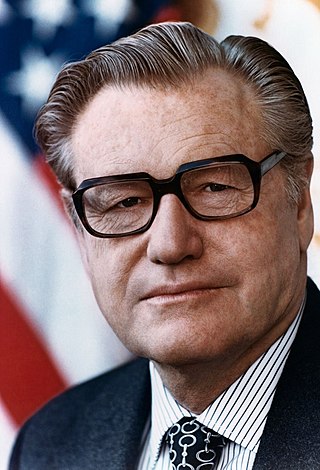
Nelson Aldrich Rockefeller, sometimes referred to by his nickname Rocky, was an American businessman and politician who served as the 41st vice president of the United States from 1974 to 1977. A member of the Republican Party and wealthy Rockefeller family, he previously served as the 49th governor of New York from 1959 to 1973. He also served as assistant secretary of State for American Republic Affairs for Presidents Franklin D. Roosevelt and Harry S. Truman (1944–1945) as well as under secretary of Health, Education and Welfare (HEW) under Dwight D. Eisenhower from 1953 to 1954. In 1980, HEW split into 2 cabinet level agencies: Health & Human Services (HHS) & Department of Education. A grandson of Standard Oil founder John D. Rockefeller, he was a noted art collector and served as administrator of Rockefeller Center in Manhattan, New York City.

The vice president of the United States (VPOTUS) is the second-highest officer in the executive branch of the U.S. federal government, after the president of the United States, and ranks first in the presidential line of succession. The vice president is also an officer in the legislative branch, as the president of the Senate. In this capacity, the vice president is empowered to preside over Senate deliberations at any time, but may not vote except to cast a tie-breaking vote. The vice president is indirectly elected together with the president to a four-year term of office by the people of the United States through the Electoral College.

Gerald Rudolph Ford Jr. was an American politician who served as the 38th president of the United States from 1974 to 1977. He was the only president never to have been elected to the office of president or vice president. He previously served as the leader of the Republican Party in the House of Representatives, and was appointed to be the 40th vice president in 1973. When President Richard Nixon resigned in 1974, Ford succeeded to the presidency, but was defeated for election to a full term in 1976.

The Twenty-fifth Amendment to the United States Constitution deals with presidential succession and disability.
Apollo program: The last crewed lunar flight, Apollo 17, carrying Eugene Cernan, Ronald Evans, and Harrison Schmitt, returns to Earth.

The Apollo program, also known as Project Apollo, was the third United States human spaceflight program carried out by the National Aeronautics and Space Administration (NASA), which succeeded in preparing and landing the first humans on the Moon from 1968 to 1972. It was first conceived in 1960 during President Dwight D. Eisenhower's administration as a three-person spacecraft to follow the one-person Project Mercury, which put the first Americans in space. Apollo was later dedicated to President John F. Kennedy's national goal for the 1960s of "landing a man on the Moon and returning him safely to the Earth" in an address to Congress on May 25, 1961. It was the third US human spaceflight program to fly, preceded by the two-person Project Gemini conceived in 1961 to extend spaceflight capability in support of Apollo.

Apollo 17 was the final mission of NASA's Apollo program, the most recent time humans have set foot on the Moon or traveled beyond low Earth orbit. Commander Gene Cernan and Lunar Module Pilot Harrison Schmitt walked on the Moon, while Command Module Pilot Ronald Evans orbited above. Schmitt was the only professional geologist to land on the Moon, selected in place of Joe Engle with NASA under pressure to send a scientist to the Moon. The mission's heavy emphasis on science meant the inclusion of a number of new experiments, including a biological experiment containing five mice carried in the command module.

Eugene Andrew Cernan was an American astronaut, naval aviator, electrical engineer, aeronautical engineer, and fighter pilot. During the Apollo 17 mission, Cernan became the eleventh human being to walk on the Moon. As he re-entered the Apollo Lunar Module after Harrison Schmitt on their third and final lunar excursion, he remains as of 2022, famously: "The last man on the Moon".

Ronald Ellwin Evans Jr. was an American electrical engineer, aeronautical engineer, officer and aviator in the United States Navy, and NASA astronaut. As Command Module Pilot on Apollo 17 he was one of the 24 astronauts to have flown to the Moon, and one of 12 people to have flown to the Moon without landing on it.
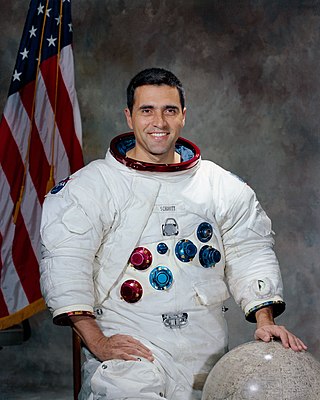
Harrison Hagan "Jack" Schmitt is an American geologist, retired NASA astronaut, university professor, former U.S. senator from New Mexico, and the most recent living person—and only person without a background in military aviation—to have walked on the Moon.

Earth is the third planet from the Sun and the only astronomical object known to harbor life. While large volumes of water can be found throughout the Solar System, only Earth sustains liquid surface water. About 71% of Earth's surface is made up of the ocean, dwarfing Earth's polar ice, lakes, and rivers. The remaining 29% of Earth's surface is land, consisting of continents and islands. Earth's surface layer is formed of several slowly moving tectonic plates, interacting to produce mountain ranges, volcanoes, and earthquakes. Earth's liquid outer core generates the magnetic field that shapes the magnetosphere of the Earth, deflecting destructive solar winds.
Harold Holt, the Prime Minister of Australia, is officially presumed dead.

Harold Edward Holt was an Australian politician who served as the 17th prime minister of Australia from 1966 until his presumed death in 1967. He held office as leader of the Liberal Party.

The prime minister of Australia is the head of government of the Commonwealth of Australia. The prime minister heads the executive branch of the federal government of Australia and is also accountable to federal parliament under the principles of responsible government. The current prime minister is Anthony Albanese of the Australian Labor Party, who became prime minister on 23 May 2022.
A presumption of death occurs when a person is thought to be dead by a group of people despite the absence of direct proof of the person's death, such as the finding of remains attributable to that person. Such a presumption is typically made by an individual when a person has been missing for an extended period and in the absence of any evidence that person is still alive – or after a much shorter period, but where the circumstances surrounding a person's disappearance overwhelmingly support the belief that the person is dead.
The ruling junta of South Vietnam, led by Nguyễn Khánh, initiated a coup, dissolving the High National Council, a civilian advisory body.

South Vietnam, officially the Republic of Vietnam, was a country in Southeast Asia that existed from 1955 to 1975, the period when the southern portion of Vietnam was a member of the Western Bloc during part of the Cold War after the 1954 division of Vietnam. It first received international recognition in 1949 as the State of Vietnam within the French Union, with its capital at Saigon, before becoming a republic in 1955. South Vietnam was bordered by North Vietnam to the north, Laos to the northwest, Cambodia to the southwest, and Thailand across the Gulf of Thailand to the southwest. Its sovereignty was recognized by the United States and 87 other nations, though it failed to gain admission into the United Nations as a result of a Soviet veto in 1957. It was succeeded by the Republic of South Vietnam in 1975.

Nguyễn Khánh was a South Vietnamese military officer and Army of the Republic of Vietnam general who served in various capacities as head of state and prime minister of South Vietnam while at the head of a military junta from January 1964 until February 1965. He was involved in or against many coup attempts, failed and successful, from 1960 until his defeat and exile from South Vietnam in 1965. Khánh lived out his later years with his family in exile in the United States. He died in 2013 in San Jose, California, at age 85.

The December 1964 South Vietnamese coup took place before dawn on December 19, 1964, when the ruling military junta of South Vietnam led by General Nguyễn Khánh dissolved the High National Council (HNC) and arrested some of its members. The HNC was an unelected legislative-style civilian advisory body they had created at the request of the United States—South Vietnam's main sponsor—to give a veneer of civilian rule. The dissolution dismayed the Americans, particularly the ambassador, Maxwell D. Taylor, who engaged in an angry war of words with various generals including Khánh and threatened aid cuts. They were unable to do anything about the fait accompli that had been handed to them, because they strongly desired to win the Vietnam War and needed to support the Army of the Republic of Vietnam. Instead, Taylor's searing verbal attacks were counterproductive as they galvanized the Vietnamese officers around the embattled Khánh. At the time, Khánh's leadership was under threat from his fellow generals, as well as Taylor, who had fallen out with him and was seeking his removal.
The High National Council was a civilian legislative assembly convened by the Military Revolutionary Council (MRC) led by the three generals Dương Văn Minh, Nguyễn Khánh and Trần Thiện Khiêm, under US pressure, after the First Republic led by Ngô Đình Diệm was overthrown by the military junta. Its ultimate objective was to prepare the constitution of the Second Republic of Vietnam. The Council consisted of 16 well-respected citizens: Nguyễn Xuân Chữ, Tôn Thất Hanh, Nguyễn Văn Huyền, Ngô Gia Hy, Nguyễn Đình Luyện, Nguyễn Văn Lực, Trần Đình Nam, Hồ Văn Nhựt, Trần Văn Quế, Lê Khắc Quyến, Phan Khắc Sửu, Lương Trọng Tường, Hồ Đắc Thắng, Lê Văn Thu, Mai Thọ Truyền and Trần Văn Văn.
India annexes Daman and Diu, part of Portuguese India.

The Annexation of Goa was the process in which the Republic of India annexed Estado da Índia, the then Portuguese Indian territories of Goa, Daman and Diu, starting with the armed action carried out by the Indian Armed Forces in December 1961. In India, this action is referred to as the "Liberation of Goa". In Portugal, it is referred to as the "Invasion of Goa". Jawaharlal Nehru had hoped that the popular movement in Goa and the pressure of world public opinion would force the Portuguese Goan authorities to grant it independence but since it did not have any effect, he decided to take it by force.
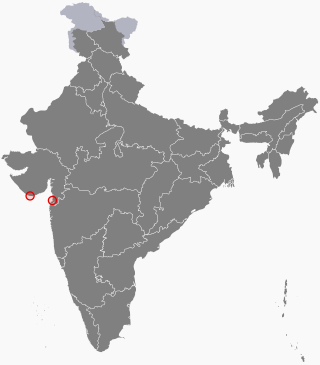
Daman and Diu was a former union territory in northwestern India. With an area of 112 km2 (43 sq mi), it was the smallest administrative subdivision of India on the mainland. The territory comprised two districts, Damaon and Dio island, geographically separated by the Gulf of Khambat. The state of Gujarat and the Arabian Sea bordered the territory. A Portuguese colony since the 1500s, the territories were taken by India with the Annexation of Goa in 1961. Daman and Diu were administered as part of the union territory of Goa, Daman and Diu between 1961 and 1987, after the Goa Opinion Poll they became a separate union territory. In 2019, legislation was passed to merge the union territory of Daman and Diu with its neighbouring union territory, Dadra and Nagar Haveli, to form the new union territory of Dadra and Nagar Haveli and Daman and Diu with effect from 26 January 2020.

The State of India, also referred as the Portuguese State of India or simply Portuguese India, was a state of the Portuguese Empire founded six years after the discovery of a sea route to the Indian subcontinent by Vasco da Gama, a subject of the Kingdom of Portugal. The capital of Portuguese India served as the governing centre of a string of military forts and trade posts scattered all over the Indian Ocean.
British physician and suspected serial killer John Bodkin Adams was arrested in connection with the death of Edith Alice Morrell.
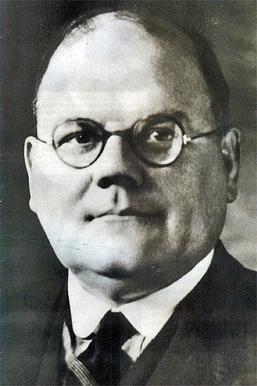
John Bodkin Adams was an Irish-born British general practitioner, convicted fraudster, and suspected serial killer. Between 1946 and 1956, 163 of his patients died while in comas, which was deemed to be worthy of investigation. In addition, 132 out of 310 patients had left Adams money or items in their wills.
Edith Alice Morrell was a resident of Eastbourne and patient of Dr John Bodkin Adams. Although Adams was acquitted in 1957 of her murder, the question of Adams' role in Mrs Morrell's death excited considerable interest at the time and continues to do so. This is partly because of negative pre-trial publicity which remains in the public record, partly because of the several dramatic incidents in the trial and partly as Adams declined to give evidence in his own defence. The trial featured in headlines around the world and was described at the time as "one of the greatest murder trials of all time" and "murder trial of the century". It was also described by the trial judge as unique because "the act of murder" had "to be proved by expert evidence." The trial also established the legal doctrine of double effect, where a doctor giving treatment with the aim of relieving pain may, as an unintentional result, shorten life.
Irish-born physician John Bodkin Adams is arrested in connection with the suspicious deaths of more than 160 patients. Eventually he is convicted only of minor charges.

John Bodkin Adams was an Irish-born British general practitioner, convicted fraudster, and suspected serial killer. Between 1946 and 1956, 163 of his patients died while in comas, which was deemed to be worthy of investigation. In addition, 132 out of 310 patients had left Adams money or items in their wills.
Start of the First Indochina War.

The First Indochina War began in French Indochina from 19 December 1946 to 20 July 1954 between France and Việt Minh, and their respective allies. Việt Minh was led by Võ Nguyên Giáp and Hồ Chí Minh. Most of the fighting took place in Tonkin in Northern Vietnam, although the conflict engulfed the entire country and also extended into the neighboring French Indochina protectorates of Laos and Cambodia.
John Amery, British Fascist, is executed at the age of 33 by the British Government for treason.

John Amery was a British fascist and Nazi collaborator during World War II. He was the originator of the British Free Corps, a volunteer Waffen-SS unit composed of former British and Dominion prisoners-of-war.

Fascism is a far-right, authoritarian, ultra-nationalist political ideology and movement, characterized by a dictatorial leader, centralized autocracy, militarism, forcible suppression of opposition, belief in a natural social hierarchy, subordination of individual interests for the perceived good of the nation and race, and strong regimentation of society and the economy.
World War II: Adolf Hitler appoints himself as head of the Oberkommando des Heeres.

World War II or the Second World War, often abbreviated as WWII or WW2, was a world war that lasted from 1939 to 1945. It involved the vast majority of the world's countries—including all of the great powers—forming two opposing military alliances: the Allies and the Axis powers. World War II was a total war that directly involved more than 100 million personnel from more than 30 countries.

Adolf Hitler was an Austrian-born German politician who was dictator of Germany from 1933 until his death in 1945. He rose to power as the leader of the Nazi Party, becoming the chancellor in 1933 and then taking the title of Führer und Reichskanzler in 1934. During his dictatorship, he initiated World War II in Europe by invading Poland on 1 September 1939. He was closely involved in military operations throughout the war and was central to the perpetration of the Holocaust: the genocide of about six million Jews and millions of other victims.
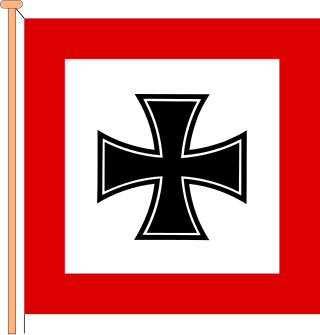
The Oberkommando des Heeres was the high command of the Army of Nazi Germany. It was founded in 1935 as part of Adolf Hitler's rearmament of Germany. OKH was de facto the most important unit within the German war planning until the defeat at Moscow in December 1941.
World War II: Limpet mines placed by Italian divers heavily damage HMS Valiant and HMS Queen Elizabeth in Alexandria harbour.
A limpet mine is a type of naval mine attached to a target by magnets. It is so named because of its superficial similarity to the shape of the limpet, a type of sea snail that clings tightly to rocks or other hard surfaces.

The Italian Navy is the navy of the Italian Republic. It is one of the four branches of Italian Armed Forces and was formed in 1946 from what remained of the Regia Marina after World War II. As of August 2014, the Italian Navy had a strength of 30,923 active personnel, with approximately 184 vessels in service, including minor auxiliary vessels. It is considered a multiregional and a blue-water navy.

HMS Valiant was one of five Queen Elizabeth-class battleships built for the Royal Navy during the early 1910s. She participated in the Battle of Jutland during the First World War as part of the Grand Fleet. Other than that battle, and the inconclusive Action of 19 August, her service during the war generally consisted of routine patrols and training in the North Sea. She saw further action during the Second World War in the Mediterranean and Far East.

HMS Queen Elizabeth was the lead ship of her class of five dreadnought battleships built for the Royal Navy in the early 1910s, and was often used as a flagship. She served in the First World War as part of the Grand Fleet, and participated in the inconclusive action of 19 August 1916. Her service during the war generally consisted of routine patrols and training in the North Sea. She and the other super-dreadnought battleships were the first of their type to be powered by oil instead of coal. Queen Elizabeth later served in several theatres during the Second World War, and was ultimately scrapped in 1948.
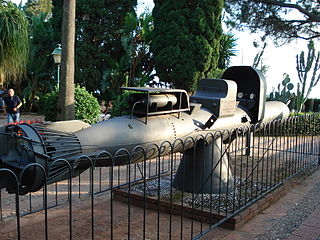
The Raid on Alexandria was carried out on 19 December 1941 by Italian Navy divers of the Decima Flottiglia MAS, who attacked and disabled two Royal Navy battleships in the harbour of Alexandria, Egypt, using manned torpedoes.
Risto Ryti, the Prime Minister of Finland, is elected President of the Republic of Finland in a presidential election, which is exceptionally held by the 1937 electoral college.
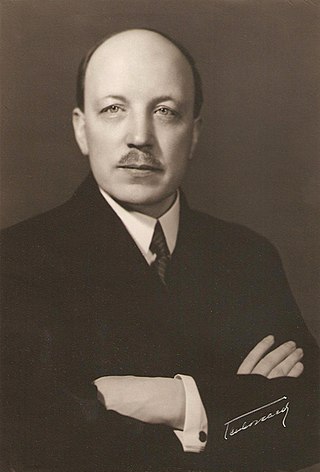
Risto Heikki Ryti served as the fifth president of Finland from 1940 to 1944. Ryti started his career as a politician in the field of economics and as a political background figure during the interwar period. He made a wide range of international contacts in the world of banking and within the framework of the League of Nations. Ryti served (1939–1940) as prime minister during the Winter War of 1939–1940 and the Interim Peace of 1940–1941. Later he became president during the Continuation War of 1941–1944. After the war, Ryti was the main defendant in the Finnish war-responsibility trials (1945–1946), which resulted in his conviction for crimes against peace.

The prime minister of Finland is the leader of the Finnish Government. The prime minister and their cabinet exercise executive authority in the state. The prime minister is formally ranked third in the protocol after the president of Finland and the speaker of the Parliament. Finland's first prime minister, Pehr Evind Svinhufvud, was appointed on 27 November 1917, just a few days before the country declared independence from Russia.

The president of the Republic of Finland is the head of state of Finland. Under the Constitution of Finland, executive power is vested in the Finnish Government and the president, with the latter possessing only residual powers. The president is directly elected by universal suffrage for a term of six years. Since 1994, no president may be elected for more than two consecutive terms. The president must be a natural-born Finnish citizen. The presidential office was established in the Constitution Act of 1919. The incumbent president is Sauli Niinistö. He was elected for the first time in 2012 and was re-elected in 2018.

Early and indirect presidential elections were held in Finland in 1940 after President Kyösti Kallio resigned on 27 November following a stroke on 27 August. The 1937 electoral college was recalled and elected Prime Minister Risto Ryti, who received 288 of the 300 votes. Most other Finnish politicians considered Ryti a principled, unselfish, intelligent and patriotic man, who could lead Finland effectively enough during World War II. His leadership qualities had been tested already during the Winter War. Also the outgoing President Kallio considered him the best available presidential candidate. In early December 1940, the Soviet Foreign Minister, Vyacheslav Molotov, interfered with the Finnish presidential elections by claiming to the Finnish Ambassador to the Soviet Union, Juho Kusti Paasikivi, that if potential presidential candidates such as Marshal Carl Gustaf Emil Mannerheim, former President Pehr Evind Svinhufvud, or former Prime Minister Toivo Mikael Kivimäki were elected President, the Soviet government would consider Finland unwilling to fulfill its peace treaty with the Soviet Union. Due to the lingering threat of another war and the Karelian refugees' dispersal throughout Finland, regular presidential elections were cancelled, and instead the 1937 presidential electors were summoned to elect the President. Under these tense political circumstances, Ryti had no problem winning these exceptional presidential elections by a landslide. The same day, former president Kallio died.
Two-stage presidential elections were held in Finland in 1937. On 15 and 16 January the public elected presidential electors to an electoral college. They in turn elected the President. Whilst Kaarlo Juho Ståhlberg was one vote short of winning on the first ballot, the result was a victory for Kyösti Kallio, who won on the second ballot. The turnout for the popular vote was 57.8%.
BBC World Service begins broadcasting as the BBC Empire Service.

The BBC World Service is an international broadcaster owned and operated by the BBC, with funding from the British Government through the Foreign Secretary's office. It is the world's largest external broadcaster in terms of reception area, language selection and audience reach. It broadcasts radio news, speech and discussions in more than 40 languages to many parts of the world on analogue and digital shortwave platforms, internet streaming, podcasting, satellite, DAB, FM and MW relays. In 2015, the World Service reached an average of 210 million people a week. In November 2016, the BBC announced that it would start broadcasting in additional languages including Amharic and Igbo, in its biggest expansion since the 1940s.
The Indian National Congress promulgates the Purna Swaraj (the Declaration of the Independence of India).

The Indian National Congress (INC), colloquially the Congress Party but often simply the Congress, is a political party in India with widespread roots. Founded in 1885, it was the first modern nationalist movement to emerge in the British Empire in Asia and Africa. From the late 19th century, and especially after 1920, under the leadership of Mahatma Gandhi, the Congress became the principal leader of the Indian independence movement. The Congress led India to independence from the United Kingdom, and significantly influenced other anti-colonial nationalist movements in the British Empire.
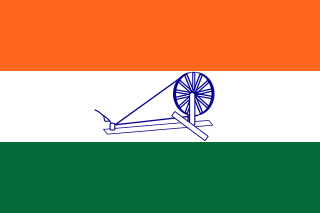
The declaration of Purna Swaraj was made because the youth of India and many leaders of INC were not satisfied with the Dominion Status. The word Purna Swaraj was derived from Sanskrit पूर्ण (Pūrṇa) 'Complete', and स्वराज 'Self-rule or Sovereignty', or Declaration of the Independence of India, it was promulgated by the Indian National Congress on 26 January 1930, resolving the Congress and Indian nationalists to fight for Purna Swaraj, or complete self-rule independent of the British Empire
Three Indian revolutionaries, Ram Prasad Bismil, Roshan Singh and Ashfaqulla Khan, are executed by the British Raj for participation in the Kakori conspiracy.

Ram Prasad Bismil was an Indian poet, writer, revolutionary and an Indian freedom fighter who participated in the Mainpuri Conspiracy of 1918, and the Kakori Conspiracy of 1925, and fought against British Raj. He also had a good command over Urdu and the Hindi languages and was an accomplished poet, composing in these languages using the pen names Ram, Agyat and Bismil, the latter through which he became famously known by. He was also a multilingual translator and his Hindi poem "Manipuri ki Pratigya" became very famous. Bismil was hanged on 19 December 1927 by the British for his revolutionary activities. He was associated with Arya Samaj where he got inspiration from Satyarth Prakash, a book written by Swami Dayanand Saraswati. He also had a confidential connection with Lala Har Dayal through his guru Swami Somdev, a preacher of Arya Samaj. Bismil was one of the founding members of the revolutionary organization Hindustan Republican Association. Bhagat Singh praised him as a great poet-writer of Urdu and Hindi, who had also translated the books Catherine from English and Bolshevikon Ki Kartoot from Bengali.

Thakur Roshan Singh was an Indian revolutionary, born in the village of Nabada in Shahjahanpur district, Uttar Pradesh in A kshatriya Rajput family, who was sentenced in the Bareilly shooting case during the Non Cooperation Movement of 1921–22. After release from Bareilly Central Jail, he joined the Hindustan Republican Association in 1924. Although he had not taken part in the Kakori conspiracy of August 1925, he was arrested and tried in January 1926 by the then British Government, for a murder carried out during the Bamrauli dacoity in December 1924. He was sentenced to death, along with Ram Prasad Bismil, Ashfaqulla Khan and Rajendra Lahiri. He was executed at Malaka/Naini Jail in the Allahabad district. It is well documented that after his death, his family had to face social and economic hardship, including problems finding a matrimonial match for his daughters.

Ashfaqulla Khan was an Indian independence activist in the Indian independence movement and co-founder of the Hindustan Republican Association.

The British Raj was the rule of the British Crown on the Indian subcontinent; it is also called Crown rule in India, or Direct rule in India, and lasted from 1858 to 1947. The region under British control was commonly called India in contemporaneous usage and included areas directly administered by the United Kingdom, which were collectively called British India, and areas ruled by indigenous rulers, but under British paramountcy, called the princely states. The region was sometimes called the Indian Empire, though not officially.

The Kakori Train robbery was a train robbery that took place at Kakori, a village near Lucknow, on 9 August 1925, during the Indian Independence Movement against the British Raj. It was organised by Hindustan Republican Association (HRA).
The last Rolls-Royce Silver Ghost is sold in London, England.

The Rolls-Royce Silver Ghost name refers both to a car model and one specific car from that series.
German serial killer Fritz Haarmann is sentenced to death for a series of murders.

Friedrich Heinrich Karl "Fritz" Haarmann was a German serial killer, known as the Butcher of Hanover, the Vampire of Hanover and the Wolf Man, who committed the sexual assault, murder, mutilation and dismemberment of at least twenty-four young men and boys between 1918 and 1924 in the city of Hanover.
King Constantine I is restored as King of the Hellenes after the death of his son Alexander of Greece and a plebiscite.

Constantine I was King of Greece from 18 March 1913 to 11 June 1917 and from 19 December 1920 to 27 September 1922. He was commander-in-chief of the Hellenic Army during the unsuccessful Greco-Turkish War of 1897 and led the Greek forces during the successful Balkan Wars of 1912–1913, in which Greece expanded to include Thessaloniki, doubling in area and population. He succeeded to the throne of Greece on 18 March 1913, following his father's assassination.
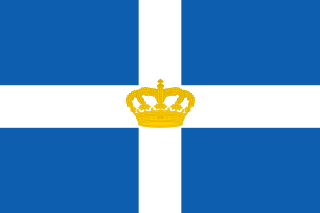
The Kingdom of Greece was established in 1832 and was the successor state to the First Hellenic Republic. It was internationally recognised by the Treaty of Constantinople, where Greece also secured its full independence from the Ottoman Empire after nearly four centuries.

Alexander was King of Greece from 11 June 1917 until his death three years later, at the age of 27, from the effects of a monkey bite.

A referendum is a direct vote by the electorate on a proposal, law, or political issue. This is in contrast to an issue being voted on by a representative. This may result in the adoption of a new policy or specific law, or the referendum may be only advisory. In some countries, it is synonymous with or commonly known by other names including plebiscite, votation, popular consultation, ballot question, ballot measure, or proposition.
William Van Schaick, captain of the steamship General Slocum which caught fire and killed over one thousand people, is pardoned by U.S. President William Howard Taft after .mw-parser-output .frac{white-space:nowrap}.mw-parser-output .frac .num,.mw-parser-output .frac .den{font-size:80%;line-height:0;vertical-align:super}.mw-parser-output .frac .den{vertical-align:sub}.mw-parser-output .sr-only{border:0;clip:rect(0,0,0,0);height:1px;margin:-1px;overflow:hidden;padding:0;position:absolute;width:1px}3+1⁄2 years in Sing Sing prison.

A steamboat is a boat that is propelled primarily by steam power, typically driving propellers or paddlewheels. Steamboats sometimes use the prefix designation SS, S.S. or S/S or PS ; however, these designations are most often used for steamships.

The PS General Slocum was a sidewheel passenger steamboat built in Brooklyn, New York, in 1891. During her service history, she was involved in a number of mishaps, including multiple groundings and collisions.
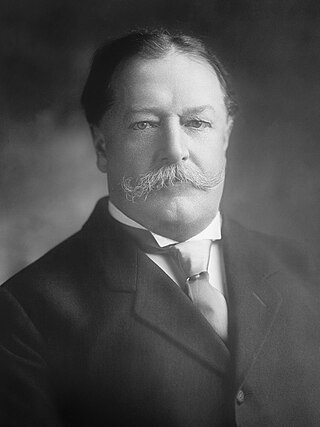
William Howard Taft was the 27th president of the United States (1909–1913) and the tenth chief justice of the United States (1921–1930), the only person to have held both offices. Taft was elected president in 1908, the chosen successor of Theodore Roosevelt, but was defeated for reelection in 1912 by Woodrow Wilson after Roosevelt split the Republican vote by running as a third-party candidate. In 1921, President Warren G. Harding appointed Taft to be chief justice, a position he held until a month before his death.

Sing Sing Correctional Facility, formerly Ossining Correctional Facility, is a maximum-security prison operated by the New York State Department of Corrections and Community Supervision in the village of Ossining, New York. It is about 30 miles (48 km) north of New York City on the east bank of the Hudson River. It holds about 1,700 inmates and housed the execution chamber for the State of New York until the abolition of capital punishment in New York in 2004.
Two hundred thirty-nine coal miners die in the Darr Mine Disaster in Jacobs Creek, Pennsylvania.

The Darr Mine disaster at Van Meter, Rostraver Township, Westmoreland County, Pennsylvania, near Smithton, killed 239 men and boys on December 19, 1907. It ranks as the worst coal mining disaster in Pennsylvanian history. Many victims were of immigrants from central Europe, including Rusyns, Hungarians, Austrians, Germans, Poles and Italians.

Jacobs Creek is a 33.4-mile-long (53.8 km) tributary of the Youghiogheny River beginning in Acme, Pennsylvania and draining at its mouth in the town of Jacobs Creek into the Youghiogheny River. Jacobs Creek is the southwestern border of Westmoreland County and the northwestern border of Fayette County. The area was a major producer of rye whiskey in the decades before Prohibition.
Hopetoun Blunder: The first Governor-General of Australia John Hope, 7th Earl of Hopetoun, appoints Sir William Lyne premier of the new state of New South Wales, but he is unable to persuade other colonial politicians to join his government and is forced to resign.
The Hopetoun Blunder was a political event immediately prior to the Federation of the British colonies in Australia.

The governor-general of Australia is the representative of the monarch, currently King Charles III, in Australia. The governor-general is appointed by the monarch on the recommendation of government ministers. The governor-general has formal presidency over the Federal Executive Council and is commander-in-chief of the Australian Defence Force. The functions of the governor-general include appointing ministers, judges, and ambassadors; giving royal assent to legislation passed by parliament; issuing writs for election; and bestowing Australian honours.

John Adrian Louis Hope, 1st Marquess of Linlithgow, 7th Earl of Hopetoun, was a British aristocrat and statesman who served as the first governor-general of Australia, in office from 1901 to 1902. He was previously Governor of Victoria from 1889 to 1895.

Sir William John Lyne KCMG was an Australian politician who served as Premier of New South Wales from 1899 to 1901, and later as a federal cabinet minister under Edmund Barton and Alfred Deakin. He is best known as the subject of the so called "Hopetoun Blunder", unexpectedly being asked to serve as the first Prime Minister of Australia but proving unable to form a government.

New South Wales is a state on the east coast of Australia. It borders Queensland to the north, Victoria to the south, and South Australia to the west. Its coast borders the Coral and Tasman Seas to the east. The Australian Capital Territory and Jervis Bay Territory are enclaves within the state. New South Wales' state capital is Sydney, which is also Australia's most populous city. In December 2021, the population of New South Wales was over 8 million, making it Australia's most populous state. Just under two-thirds of the state's population, 5.3 million, live in the Greater Sydney area.
French parliament votes amnesty for all involved in scandalous army treason trial known as Dreyfus affair.
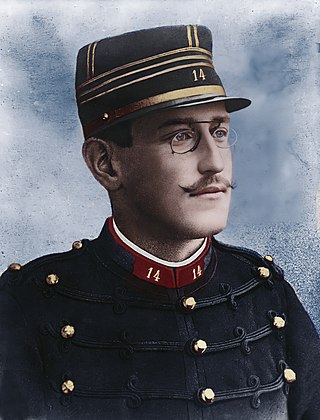
The Dreyfus affair was a political scandal that divided the French Third Republic from 1894 until its resolution in 1906. "L'Affaire", as it is known in French, has come to symbolise modern injustice in the Francophone world, and it remains one of the most notable examples of a complex miscarriage of justice and antisemitism. The role played by the press and public opinion proved influential in the conflict.
A Christmas Carol (illustration pictured), a novella by Charles Dickens about the miser Ebenezer Scrooge and his transformation after being visited by ghosts, was first published.

A Christmas Carol. In Prose. Being a Ghost Story of Christmas, commonly known as A Christmas Carol, is a novella by Charles Dickens, first published in London by Chapman & Hall in 1843 and illustrated by John Leech. A Christmas Carol recounts the story of Ebenezer Scrooge, an elderly miser who is visited by the ghost of his former business partner Jacob Marley and the spirits of Christmas Past, Present and Yet to Come. After their visits, Scrooge is transformed into a kinder, gentler man.

Charles John Huffam Dickens was an English writer and social critic. He created some of the world's best-known fictional characters and is regarded by many as the greatest novelist of the Victorian era. His works enjoyed unprecedented popularity during his lifetime and, by the 20th century, critics and scholars had recognised him as a literary genius. His novels and short stories are widely read today.
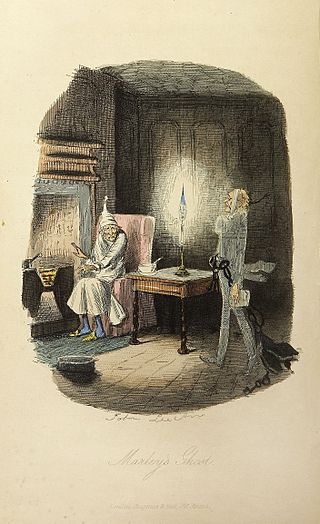
Ebenezer Scrooge is the protagonist of Charles Dickens's 1843 novella A Christmas Carol. At the beginning of the novella, Scrooge is a cold-hearted miser who despises Christmas. The tale of his redemption by three spirits has become a defining tale of the Christmas holiday in the English-speaking world.
Nullification crisis: American vice president John C. Calhoun's South Carolina Exposition and Protest, written to protest the Tariff of 1828, was presented to the South Carolina House of Representatives.
The nullification crisis was a United States sectional political crisis in 1832–33, during the presidency of Andrew Jackson, which involved a confrontation between the state of South Carolina and the federal government. It ensued after South Carolina declared the federal Tariffs of 1828 and 1832 unconstitutional and therefore null and void within the sovereign boundaries of the state. However, courts at the state and federal level, including the U.S. Supreme Court, repeatedly have rejected the theory of nullification by states.
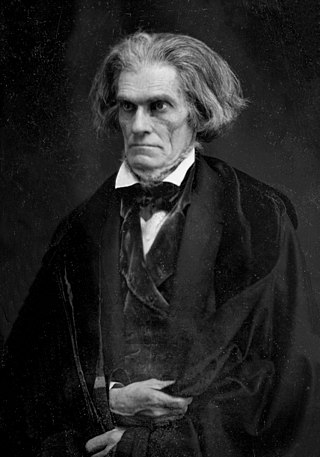
John Caldwell Calhoun was an American statesman and political theorist from South Carolina who held many important positions including being the seventh vice president of the United States from 1825 to 1832. He adamantly defended slavery and sought to protect the interests of the white South. He began his political career as a nationalist, modernizer, and proponent of a strong national government and protective tariffs. In the late 1820s, his views changed radically, and he became a leading proponent of states' rights, limited government, nullification, and opposition to high tariffs. He saw Northern acceptance of those policies as a condition of the South remaining in the Union. His beliefs and warnings heavily influenced the South's secession from the Union in 1860–1861.
The South Carolina Exposition and Protest, also known as Calhoun's Exposition, was written in December 1828 by John C. Calhoun, then Vice President of the United States under John Quincy Adams and later under Andrew Jackson. Calhoun did not formally state his authorship at the time, though it was widely suspected and later confirmed.
The Tariff of 1828 was a very high protective tariff that became law in the United States in May 1828. It was a bill designed to not pass Congress because it was seen by free trade supporters as hurting both industry and farming, but surprisingly, it passed. The bill was vehemently denounced in the South and escalated to a threat of civil war in the Nullification crisis of 1832–1833. The tariff was replaced in 1833, and the crisis ended. It was called the "Tariff of Abominations" by its Southern detractors because of the effects it had on the Southern economy. It set a 38% tax on some imported goods and a 45% tax on certain imported raw materials.

The South Carolina House of Representatives is the lower house of the South Carolina General Assembly. It consists of 124 representatives elected to two-year terms at the same time as U.S. congressional elections.
Vice President of the United States John C. Calhoun sparks the Nullification Crisis when he anonymously publishes the South Carolina Exposition and Protest, protesting the Tariff of 1828.

The vice president of the United States (VPOTUS) is the second-highest officer in the executive branch of the U.S. federal government, after the president of the United States, and ranks first in the presidential line of succession. The vice president is also an officer in the legislative branch, as the president of the Senate. In this capacity, the vice president is empowered to preside over Senate deliberations at any time, but may not vote except to cast a tie-breaking vote. The vice president is indirectly elected together with the president to a four-year term of office by the people of the United States through the Electoral College.

John Caldwell Calhoun was an American statesman and political theorist from South Carolina who held many important positions including being the seventh vice president of the United States from 1825 to 1832. He adamantly defended slavery and sought to protect the interests of the white South. He began his political career as a nationalist, modernizer, and proponent of a strong national government and protective tariffs. In the late 1820s, his views changed radically, and he became a leading proponent of states' rights, limited government, nullification, and opposition to high tariffs. He saw Northern acceptance of those policies as a condition of the South remaining in the Union. His beliefs and warnings heavily influenced the South's secession from the Union in 1860–1861.
The nullification crisis was a United States sectional political crisis in 1832–33, during the presidency of Andrew Jackson, which involved a confrontation between the state of South Carolina and the federal government. It ensued after South Carolina declared the federal Tariffs of 1828 and 1832 unconstitutional and therefore null and void within the sovereign boundaries of the state. However, courts at the state and federal level, including the U.S. Supreme Court, repeatedly have rejected the theory of nullification by states.
The South Carolina Exposition and Protest, also known as Calhoun's Exposition, was written in December 1828 by John C. Calhoun, then Vice President of the United States under John Quincy Adams and later under Andrew Jackson. Calhoun did not formally state his authorship at the time, though it was widely suspected and later confirmed.
The Tariff of 1828 was a very high protective tariff that became law in the United States in May 1828. It was a bill designed to not pass Congress because it was seen by free trade supporters as hurting both industry and farming, but surprisingly, it passed. The bill was vehemently denounced in the South and escalated to a threat of civil war in the Nullification crisis of 1832–1833. The tariff was replaced in 1833, and the crisis ended. It was called the "Tariff of Abominations" by its Southern detractors because of the effects it had on the Southern economy. It set a 38% tax on some imported goods and a 45% tax on certain imported raw materials.
French Revolutionary Wars: Two British frigates under Commodore Horatio Nelson and two Spanish frigates under Commodore Don Jacobo Stuart engage in battle off the coast of Murcia.

The French Revolutionary Wars were a series of sweeping military conflicts lasting from 1792 until 1802 and resulting from the French Revolution. They pitted France against Britain, Austria, Prussia, Russia, and several other monarchies. They are divided in two periods: the War of the First Coalition (1792–97) and the War of the Second Coalition (1798–1802). Initially confined to Europe, the fighting gradually assumed a global dimension. After a decade of constant warfare and aggressive diplomacy, France had conquered territories in the Italian Peninsula, the Low Countries and the Rhineland in Europe and abandoned Louisiana in North America. French success in these conflicts ensured the spread of revolutionary principles over much of Europe.
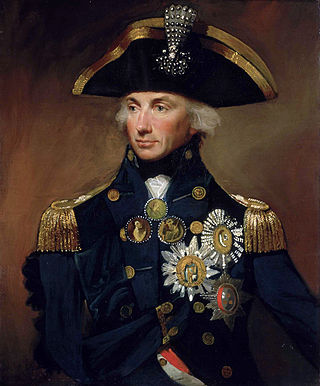
Vice-Admiral Horatio Nelson, 1st Viscount Nelson, 1st Duke of Bronte was a British flag officer in the Royal Navy. His inspirational leadership, grasp of strategy, and unconventional tactics brought about a number of decisive British naval victories during the French Revolutionary and Napoleonic Wars. He is widely regarded as one of the greatest naval commanders in history.
The action of 19 December 1796 was a minor naval engagement of the French Revolutionary Wars, fought in the last stages of the Mediterranean campaign between two British Royal Navy frigates and two Spanish Navy frigates off the coast of Murcia. The British squadron was the last remaining British naval force in the Mediterranean, sent to transport the British garrison of Elba to safety under the command of Commodore Horatio Nelson. The Spanish under Commodore Don Jacobo Stuart were the vanguard of a much larger squadron. One Spanish frigate was captured and another damaged before Spanish reinforcements drove the British off and recaptured the lost ship.

Murcia is a city in south-eastern Spain, the capital and most populous city of the autonomous community of the Region of Murcia, and the seventh largest city in the country. It has a population of 460,349 inhabitants in 2021. The total population of the metropolitan area is 672,773 in 2020, covering an urban area of 1,230.9 km2. It is located on the Segura River, in the southeast of the Iberian Peninsula. It has a climate with hot summers, mild winters, and relatively low precipitation.
American Revolutionary War: George Washington's Continental Army goes into winter quarters at Valley Forge, Pennsylvania.

The American Revolutionary War, also known as the Revolutionary War or American War of Independence, was a major war of the American Revolution. Widely considered as the war that secured the independence of the United States, fighting began on April 19, 1775, followed by the Lee Resolution on July 2, 1776, and the Declaration of Independence on July 4, 1776. The American Patriots were supported by the Kingdom of France and, to a lesser extent, the Dutch Republic and the Spanish Empire, in a conflict taking place in North America, the Caribbean, and the Atlantic Ocean.

George Washington was an American military officer, statesman, and Founding Father who served as the first president of the United States from 1789 to 1797. Appointed by the Continental Congress as commander of the Continental Army, Washington led the Patriot forces to victory in the American Revolutionary War and served as the president of the Constitutional Convention of 1787, which created the Constitution of the United States and the American federal government. Washington has been called the "Father of his Country" for his manifold leadership in the formative days of the country.

The Continental Army was the army of the United Colonies in the Revolutionary-era United States. It was formed by the Second Continental Congress after the outbreak of the American Revolutionary War, and was established by a resolution of Congress on June 14, 1775. The Continental Army was created to coordinate military efforts of the Colonies in their war for independence against the British, who sought to keep their American lands under control. General George Washington was the commander-in-chief of the army throughout the war.

Valley Forge functioned as the third of eight winter encampments for the Continental Army's main body, commanded by General George Washington, during the American Revolutionary War. In September 1777, Congress fled Philadelphia to escape the British capture of the city. After failing to retake Philadelphia, Washington led his 12,000-man army into winter quarters at Valley Forge, located approximately 18 miles (29 km) northwest of Philadelphia. They remained there for six months, from December 19, 1777 to June 19, 1778. At Valley Forge, the Continentals struggled to manage a disastrous supply crisis while retraining and reorganizing their units. About 1,700 to 2,000 soldiers died from disease, possibly exacerbated by malnutrition.
Thomas Paine published the first in a series of pamphlets entitled The American Crisis, opening with the line: "These are the times that try men's souls."
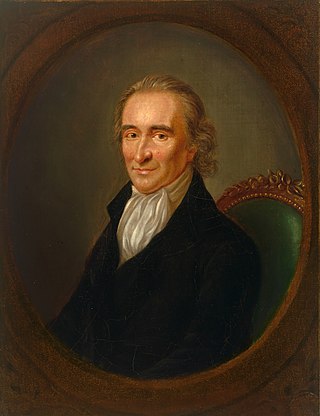
Thomas Paine was an English-born American political activist, philosopher, political theorist, and revolutionary. He authored Common Sense (1776) and The American Crisis (1776–1783), two of the most influential pamphlets at the start of the American Revolution, and helped inspire the Patriots in 1776 to declare independence from Great Britain, hitherto an unpopular cause. His ideas reflected Enlightenment-era ideals of transnational human rights.
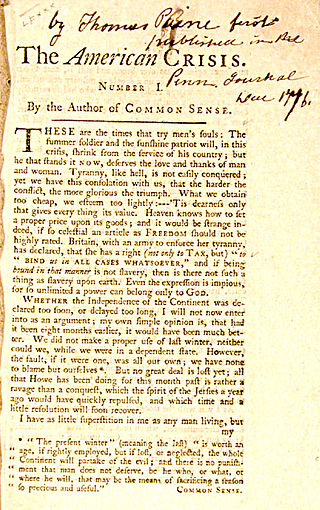
The American Crisis, or simply The Crisis, is a pamphlet series by eighteenth-century Enlightenment philosopher and author Thomas Paine, originally published from 1776 to 1783 during the American Revolution. Thirteen numbered pamphlets were published between 1776 and 1777, with three additional pamphlets released between 1777 and 1783. The first of the pamphlets was published in The Pennsylvania Journal on December 19, 1776. Paine signed the pamphlets with the pseudonym, "Common Sense".
Thomas Paine publishes one of a series of pamphlets in The Pennsylvania Journal entitled "The American Crisis".

Thomas Paine was an English-born American political activist, philosopher, political theorist, and revolutionary. He authored Common Sense (1776) and The American Crisis (1776–1783), two of the most influential pamphlets at the start of the American Revolution, and helped inspire the Patriots in 1776 to declare independence from Great Britain, hitherto an unpopular cause. His ideas reflected Enlightenment-era ideals of transnational human rights.

The Pennsylvania Journal was an American weekly newspaper published by William Bradford during the 18th century.

The American Crisis, or simply The Crisis, is a pamphlet series by eighteenth-century Enlightenment philosopher and author Thomas Paine, originally published from 1776 to 1783 during the American Revolution. Thirteen numbered pamphlets were published between 1776 and 1777, with three additional pamphlets released between 1777 and 1783. The first of the pamphlets was published in The Pennsylvania Journal on December 19, 1776. Paine signed the pamphlets with the pseudonym, "Common Sense".
King Philip's War: The colonial militia of New England and their Pequot allies attacked a Narragansett fort in Rhode Island, killing many warriors and hundreds of non-combatants.
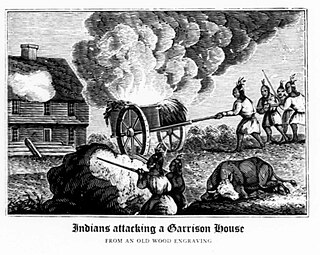
King Philip's War was an armed conflict in 1675–1676 between indigenous inhabitants of New England and New England colonists and their indigenous allies. The war is named for Metacom, the Wampanoag chief who adopted the name Philip because of the friendly relations between his father Massasoit and the Mayflower Pilgrims. The war continued in the most northern reaches of New England until the signing of the Treaty of Casco Bay on April 12, 1678.

The United Colonies of New England, commonly known as the New England Confederation, was a confederal alliance of the New England colonies of Massachusetts Bay, Plymouth, Saybrook (Connecticut), and New Haven formed in May 1643. Its primary purpose was to unite the Puritan colonies in support of the church, and for defense against the Native Americans and the Dutch colony of New Netherland. It was the first milestone on the long road to colonial unity and was established as a direct result of a war that started between the Mohegan and Narragansett Indian tribes. Its charter provided for the return of fugitive criminals and indentured servants, and served as a forum for resolving inter-colonial disputes. In practice, none of the goals were accomplished.
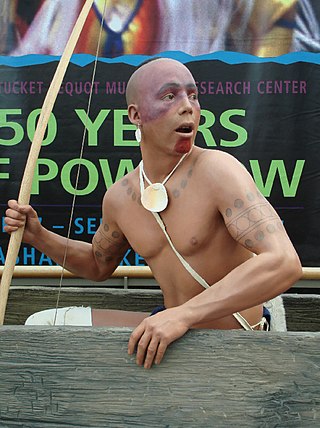
The Pequot are a Native American people of Connecticut. The modern Pequot are members of the federally recognized Mashantucket Pequot Tribe, four other state-recognized groups in Connecticut including the Eastern Pequot Tribal Nation, or the Brothertown Indians of Wisconsin. They historically spoke Pequot, a dialect of the Mohegan-Pequot language, which became extinct by the early 20th century. Some tribal members are undertaking revival efforts.

The Great Swamp Fight or the Great Swamp Massacre was a crucial battle fought during King Philip's War between the colonial militia of New England and the Narragansett people in December 1675. It was fought near the villages of Kingston and West Kingston in the Colony of Rhode Island and Providence Plantations. The combined force of the New England militia included 150 Pequots, and they inflicted a huge number of Narragansett casualties, including many hundred women and children. The battle has been described as "one of the most brutal and lopsided military encounters in all of New England's history." Since the 1930s, Narragansett and Wampanoag people commemorate the battle annually in a ceremony initiated by Narragansett-Wampanoag scholar Princess Red Wing.

The Narragansett people are an Algonquian American Indian tribe from Rhode Island. Today, Narragansett people are enrolled in the federally recognized Narragansett Indian Tribe. They gained federal recognition in 1983.
The Great Swamp Fight, a pivotal battle in King Philip's War, gives the English settlers a bitterly won victory.

The Great Swamp Fight or the Great Swamp Massacre was a crucial battle fought during King Philip's War between the colonial militia of New England and the Narragansett people in December 1675. It was fought near the villages of Kingston and West Kingston in the Colony of Rhode Island and Providence Plantations. The combined force of the New England militia included 150 Pequots, and they inflicted a huge number of Narragansett casualties, including many hundred women and children. The battle has been described as "one of the most brutal and lopsided military encounters in all of New England's history." Since the 1930s, Narragansett and Wampanoag people commemorate the battle annually in a ceremony initiated by Narragansett-Wampanoag scholar Princess Red Wing.

King Philip's War was an armed conflict in 1675–1676 between indigenous inhabitants of New England and New England colonists and their indigenous allies. The war is named for Metacom, the Wampanoag chief who adopted the name Philip because of the friendly relations between his father Massasoit and the Mayflower Pilgrims. The war continued in the most northern reaches of New England until the signing of the Treaty of Casco Bay on April 12, 1678.
The ships Susan Constant, Godspeed, and Discovery depart England carrying settlers who founded, at Jamestown, Virginia, the first of the thirteen colonies that became the United States.

Susan Constant, possibly Sarah Constant, captained by Christopher Newport, was the largest of three ships of the English Virginia Company on the 1606–1607 voyage that resulted in the founding of Jamestown in the new Colony of Virginia.

Godspeed, under Captain Bartholomew Gosnold, was one of the three ships on the 1606–1607 voyage to the New World for the English Virginia Company of London. The journey resulted in the founding of Jamestown in the new Colony of Virginia.

Discovery or Discoverie was a small 20-ton, 38-foot (12 m) long "fly-boat" of the British East India Company, launched before 1602. It was one of the three ships on the 1606–1607 voyage to the New World for the English Virginia Company of London. The journey resulted in the founding of Jamestown in the new Colony of Virginia.

The Jamestown settlement in the Colony of Virginia was the first permanent English settlement in the Americas. It was located on the northeast bank of the James (Powhatan) River about 2.5 mi (4 km) southwest of the center of modern Williamsburg. It was established by the Virginia Company of London as "James Fort" on May 4, 1607 O.S., and was considered permanent after a brief abandonment in 1610. It followed several failed attempts, including the Lost Colony of Roanoke, established in 1585 on Roanoke Island, later part of North Carolina. Jamestown served as the colonial capital from 1616 until 1699. Despite the dispatch of more settlers and supplies, including the 1608 arrival of eight Polish and German colonists and the first two European women, more than 80 percent of the colonists died in 1609–10, mostly from starvation and disease. In mid-1610, the survivors abandoned Jamestown, though they returned after meeting a resupply convoy in the James River.

The Thirteen Colonies, also known as the Thirteen British Colonies, the Thirteen American Colonies, or later as the United Colonies, were a group of British colonies on the Atlantic coast of North America. Founded in the 17th and 18th centuries, they began fighting the American Revolutionary War in April 1775 and formed the United States of America by declaring full independence in July 1776. Just prior to declaring independence, the Thirteen Colonies in their traditional groupings were: New England ; Middle ; Southern. The Thirteen Colonies came to have very similar political, constitutional, and legal systems, dominated by Protestant English-speakers. The first of these colonies was Virginia Colony in 1607, a Southern colony. While all these colonies needed to become economically viable, the founding of the New England colonies, as well as the colonies of Maryland and Pennsylvania, were substantially motivated by their founders' concerns related to the practice of religion. The other colonies were founded for business and economic expansion. The Middle Colonies were established on an earlier Dutch colony, New Netherland. All the Thirteen Colonies were part of Britain's possessions in the New World, which also included territory in Canada, Florida, and the Caribbean.
The Battle of Dreux takes place during the French Wars of Religion.
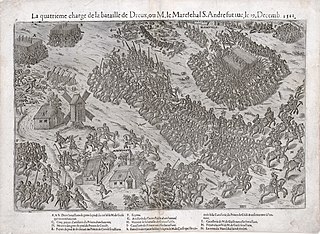
The Battle of Dreux was fought on 19 December 1562 between Catholics and Huguenots. The Catholics were led by Anne de Montmorency while Louis I, Prince of Condé, led the Huguenots. Though commanders from both sides were captured, the French Catholics won the battle which would constitute the first major engagement of the French Wars of Religion.

The French Wars of Religion is the term which is used in reference to a period of civil war between French Catholics and Protestants, commonly called Huguenots, which lasted from 1562 to 1598. According to estimates, between two and four million people died from violence, famine or diseases which were directly caused by the conflict; additionally, the conflict severely damaged the power of the French monarchy. The fighting ended in 1598 when Henry of Navarre, who had converted to Catholicism in 1593, was proclaimed Henry IV of France and issued the Edict of Nantes, which granted substantial rights and freedoms to the Huguenots. However, the Catholics continued to have a hostile opinion of Protestants in general and they also continued to have a hostile opinion of him as a person, and his assassination in 1610 triggered a fresh round of Huguenot rebellions in the 1620s.
Anne, Duchess of Brittany, is married to Maximilian I, Holy Roman Emperor by proxy.
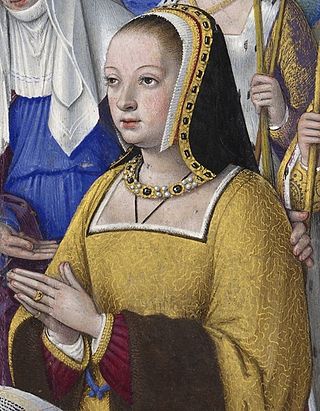
Anne of Brittany was reigning Duchess of Brittany from 1488 until her death, and Queen of France from 1491 to 1498 and from 1499 to her death. She is the only woman to have been queen consort of France twice. During the Italian Wars, Anne also became Queen of Naples, from 1501 to 1504, and Duchess of Milan, in 1499–1500 and from 1500 to 1512.
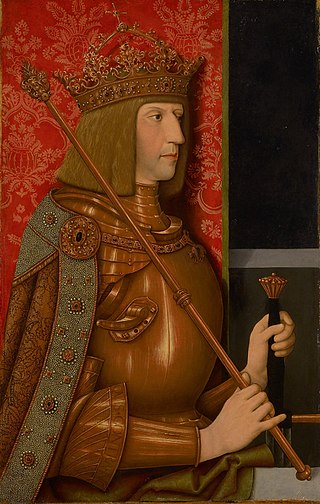
Maximilian I was King of the Romans from 1486 and Holy Roman Emperor from 1508 until his death. He was never crowned by the pope, as the journey to Rome was blocked by the Venetians. He proclaimed himself Elected Emperor in 1508 at Trent, thus breaking the long tradition of requiring a Papal coronation for the adoption of the Imperial title. Maximilian was the son of Frederick III, Holy Roman Emperor, and Eleanor of Portugal. Since his coronation as King of the Romans in 1486, he ran a double government, or Doppelregierung, with his father until Frederick's death in 1493.
A proxy wedding or proxy marriage is a wedding in which one or both of the individuals being united are not physically present, usually being represented instead by other persons. If both partners are absent a double proxy wedding occurs.
Pope Clement III is elected.
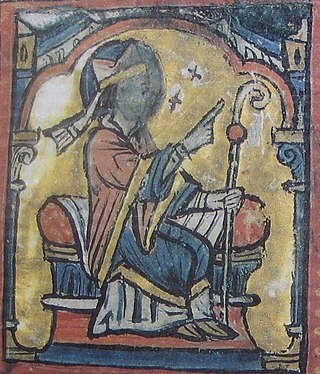
Pope Clement III, was the head of the Catholic Church and ruler of the Papal States from 19 December 1187 to his death in 1191. He ended the conflict between the Papacy and the city of Rome, by allowing the election of magistrates, which reinstalled the Papacy back in the city after a six year exile. Clement, faced with a deplete college of cardinals, created thirty-one cardinals over three years, the most since Hadrian IV. He died 20 March 1191 and was quickly replaced by Celestine III.
Henry II was crowned king of England in Westminster Abbey, London.

Henry II, also known as Henry Curtmantle, Henry FitzEmpress, or Henry Plantagenet, was King of England from 1154 until his death in 1189. He was the first king of the House of Plantagenet. King Louis VII of France made him Duke of Normandy in 1150. Henry became Count of Anjou and Maine upon the death of his father, Count Geoffrey V, in 1151. His marriage in 1152 to Eleanor of Aquitaine, whose marriage to Louis VII had recently been annulled, made him Duke of Aquitaine. He became Count of Nantes by treaty in 1158. Before he was 40 he controlled England, large parts of Wales, the eastern half of Ireland and the western half of France; an area that was later called the Angevin Empire. At various times, Henry also partially controlled Scotland and the Duchy of Brittany.
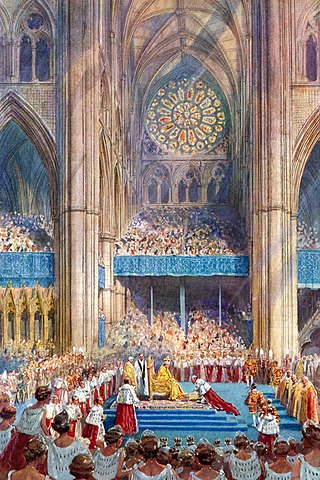
The coronation of the monarch of the United Kingdom is a ceremony in which they are formally invested with regalia and crowned at Westminster Abbey. It corresponds to the coronations that formerly took place in other European monarchies, all of which have abandoned coronations in favour of inauguration or enthronement ceremonies. A coronation is a symbolic formality and does not signify the official beginning of the monarch's reign; de jure and de facto their reign commences from the moment the preceding monarch dies, maintaining the legal continuity of the monarchy.
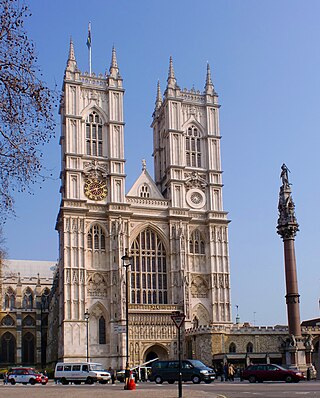
Westminster Abbey, formally titled the Collegiate Church of Saint Peter at Westminster, is a large, mainly Gothic abbey church in the City of Westminster, London, England, just to the west of the Palace of Westminster. It is one of the United Kingdom's most notable religious buildings and a burial site for English and, later, British monarchs. Since the coronation of William the Conqueror in 1066, all coronations of English and British monarchs have occurred in Westminster Abbey. Sixteen royal weddings have occurred at the abbey since 1100.
Henry II of England is crowned at Westminster Abbey.

Henry II, also known as Henry Curtmantle, Henry FitzEmpress, or Henry Plantagenet, was King of England from 1154 until his death in 1189. He was the first king of the House of Plantagenet. King Louis VII of France made him Duke of Normandy in 1150. Henry became Count of Anjou and Maine upon the death of his father, Count Geoffrey V, in 1151. His marriage in 1152 to Eleanor of Aquitaine, whose marriage to Louis VII had recently been annulled, made him Duke of Aquitaine. He became Count of Nantes by treaty in 1158. Before he was 40 he controlled England, large parts of Wales, the eastern half of Ireland and the western half of France; an area that was later called the Angevin Empire. At various times, Henry also partially controlled Scotland and the Duchy of Brittany.

Westminster Abbey, formally titled the Collegiate Church of Saint Peter at Westminster, is a large, mainly Gothic abbey church in the City of Westminster, London, England, just to the west of the Palace of Westminster. It is one of the United Kingdom's most notable religious buildings and a burial site for English and, later, British monarchs. Since the coronation of William the Conqueror in 1066, all coronations of English and British monarchs have occurred in Westminster Abbey. Sixteen royal weddings have occurred at the abbey since 1100.
Sally Ann Howes, English-American singer and actress (b. 1930) deaths

Sally Ann Howes was an English actress and singer. Her career on screen, stage and television spanned six decades. She is best known for the role of Truly Scrumptious in the 1968 musical film Chitty Chitty Bang Bang. In 1963, she was nominated for a Tony Award for Best Lead Actress in a Musical for her performance in Brigadoon.
Johnny Isakson, American politician (b. 1944) deaths

John Hardy Isakson was an American businessman and politician who served as a United States senator from Georgia from 2005 to 2019 as a member of the Republican Party. He represented Georgia's 6th congressional district in the United States House of Representatives from 1999 to 2005.
Rosalind Knight, English actress (b. 1933) deaths
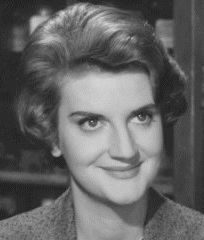
Rosalind Marie Knight was an English actress. Her career spanned 70 years on stage, screen, and television. Her film appearances include Blue Murder at St Trinian's (1957), Carry On Nurse (1959), Carry On Teacher (1959), Tom Jones (1963), and About a Boy (2002). Among her TV roles were playing Beryl in the BBC sitcom Gimme Gimme Gimme (1999–2001) and Cynthia Goodman aka "Horrible Grandma" in Friday Night Dinner.
Andrei Karlov, Russian diplomat, Ambassador to Turkey (b. 1954) deaths

Andrei Gennadyevich Karlov was a Russian diplomat who served as the Russian ambassador to Turkey and earlier as the Russian ambassador to North Korea.
Jimmy Hill, English footballer, manager, and sportscaster (b. 1928) deaths

James William Thomas Hill, OBE was an English footballer and later a television personality. His career included almost every role in the sport, including player, trade union leader, coach, manager, director, chairman, television executive, presenter, pundit, analyst and assistant referee.
Greville Janner, Baron Janner of Braunstone, Welsh-English lawyer and politician (b. 1928) deaths

Greville Ewan Janner, Baron Janner of Braunstone, was a British politician, barrister and writer. He became a Labour Party Member of Parliament for Leicester in the 1970 general election as a last-minute candidate, succeeding his father. He was an MP until 1997, and then elevated to the House of Lords. Never a frontbencher, Janner was particularly known for his work on Select Committees; he chaired the Select Committee on Employment for a time. He was associated with a number of Jewish organisations including the Board of Deputies of British Jews, of which he was chairman from 1978 to 1984, and was later prominent in the field of education about the Holocaust.
Karin Söder, Swedish educator and politician, 33rd Swedish Minister for Foreign Affairs (b. 1928) deaths

Karin Ann-Marie Söder was a Swedish Centre politician. She was the first woman in Sweden to be elected the leader of a major political party. She headed the Swedish Centre Party from 1985 to 1987. She was also one of the first female foreign ministers in the world.

The Minister for Foreign Affairs is the foreign minister of Sweden and the head of the Ministry for Foreign Affairs.
S. Balasubramanian, Indian journalist and director (b. 1936) deaths
S. S. Balan was an Indian journalist, filmmaker, political analyst, and media personality as well as internationally famous aviculturalist and agriculturalist. He was a dominant force in Indian media over six decades having been at the helm of Ananda Vikatan magazine as editor and managing director as well as managing director of the erstwhile Gemini Studios since the 1950s. He was the son of media baron S. S. Vasan. He was chairman emeritus of the Vikatan Group having retired from active involvement at the helm of the media conglomerate.
Philip Bradbourn, English lawyer and politician (b. 1951) deaths
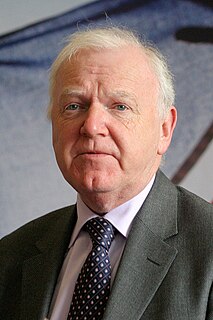
Philip Charles Bradbourn, was a British Conservative Party politician. He served as a Member of the European Parliament (MEP) for the West Midlands from 1999 to 2014.
Arthur Gardner, American actor and producer (b. 1910) deaths
Arthur Gardner was an American actor and film producer. He was known for his television western, The Rifleman. He was a voting member of the Academy of Motion Picture Arts and Sciences.
Igor Rodionov, Russian general and politician, 3rd Russian Minister of Defence (b. 1936) deaths
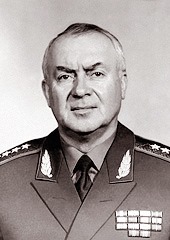
Igor Nikolayevich Rodionov was a Russian general and Duma deputy. He is best known as a hardline politician, and for his service heading the Defence Ministry of the Russian Federation.

The Ministry of Defence of the Russian Federation is the governing body of the Russian Armed Forces.
Dick Thornton, American-Canadian football player and coach (b. 1939) deaths
Richard Quincy "Tricky Dick" Thornton was an American gridiron football player and coach. He played professionally in the Canadian Football League (CFL) as a defensive back and wide receiver for the Winnipeg Blue Bombers and Toronto Argonauts from 1961 to 1972.
Roberta Leigh (Rita Shulman Lewin), British writer, artist and TV producer (b. 1926). deaths
Roberta Leigh was an assumed name for Rita Lewin who was a British author, artist, composer and television producer. She wrote romance fiction and children's stories under the pseudonyms Roberta Leigh, Rachel Lindsay, Janey Scott and Rozella Lake.
Winton Dean, English musicologist and author (b. 1916) deaths
Winton Basil Dean was an English musicologist of the 20th century, most famous for his research on the life and works—in particular the operas and oratorios—of George Frideric Handel, as detailed in his book Handel's Dramatic Oratorios and Masques (1959).
Al Goldstein, American publisher and pornographer (b. 1936) deaths

Alvin "Al" Goldstein was an American pornographer. He is known for helping normalize hardcore pornography in the United States.
Ned Vizzini, American author and screenwriter (b. 1981) deaths
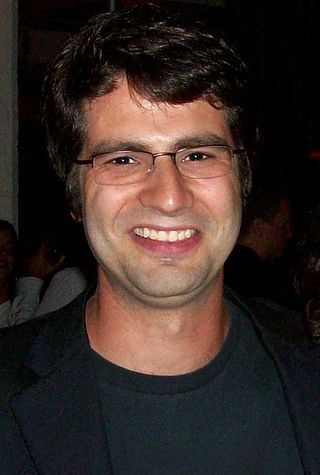
Edison Price Vizzini was an American writer. He was the author of four books for young adults including It's Kind of a Funny Story, which NPR named #56 of the "100 Best-Ever Teen Novels" and which is the basis of the film of the same name.
Robert Bork, American lawyer, judge, and scholar, United States Attorney General (b. 1927) deaths
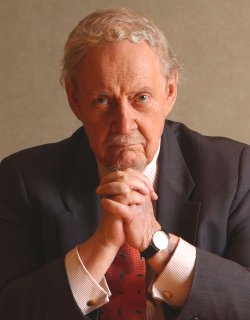
Robert Heron Bork was an American jurist who served as the Solicitor General of the United States from 1973 to 1977. A professor at Yale Law School by occupation, he later served as a judge on the U.S. Court of Appeals for the D.C. Circuit from 1982 to 1988. In 1987, President Ronald Reagan nominated Bork to the U.S. Supreme Court, but the U.S. Senate rejected his nomination after a highly publicized confirmation hearing.

The United States attorney general (AG) is the head of the United States Department of Justice, and is the chief law enforcement officer of the federal government of the United States. The attorney general serves as the principal advisor to the president of the United States on all legal matters. The attorney general is a statutory member of the Cabinet of the United States.
Amnon Lipkin-Shahak, Israeli general and politician, 22nd Transportation Minister of Israel (b. 1944) deaths

Amnon Lipkin-Shahak was an Israeli military officer and politician. He served as Chief of Staff of the Israel Defense Forces, as a Member of the Knesset, and as Minister of Transportation and Minister of Tourism.
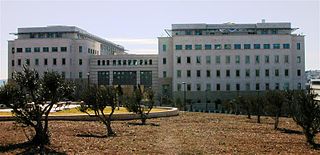
The Ministry of Transport, National Infrastructure and Road Safety (MOT) is a government agency that handles transportation and road safety issues in Israel. The ministry headquarters are in Givat Ram, Jerusalem.
Larry Morris, American football player (b. 1933) deaths

Larry Cleo Morris was an American football linebacker. The 1950 graduate of Decatur High School became an All-American at Georgia Tech before his career in the NFL. "The Brahma Bull" was named one of the linebackers on the NFL 1960s All-Decade Team. He was sentenced to probation for his role in the Savings and loan crisis.
Peter Struck, German lawyer and politician, 13th German Federal Minister of Defence (b. 1943) deaths

Peter Struck was the German Minister of Defence under chancellor Gerhard Schröder from 2002 to 2005. A lawyer, Struck was a member of the Social Democratic Party.

The Federal Minister of Defence is the head of the Federal Ministry of Defence and a member of the Federal Cabinet.
Anthony Howard, English journalist and author (b. 1934) deaths

Anthony Michell Howard, CBE was a British journalist, broadcaster and writer. He was the editor of the New Statesman and The Listener and the deputy editor of The Observer. He selected the passages used in The Crossman Diaries, a book of entries taken from Richard Crossman's The Diaries of a Cabinet Minister.
Kim Peek, American megasavant (b. 1951) deaths
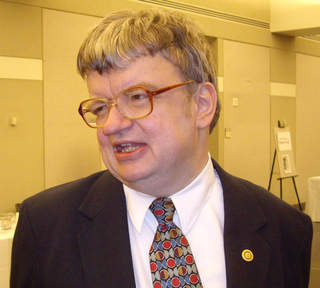
Laurence Kim Peek was an American savant. Known as a "megasavant", he had an exceptional memory, but he also experienced social difficulties, possibly resulting from a developmental disability related to congenital brain abnormalities. He was the inspiration for the character Raymond Babbitt in the 1988 movie Rain Man. Although Peek was previously diagnosed with autism, he is now thought to have had FG syndrome. The Utah Film Center's Peek Award honors his legacy.
James Bevel, American minister and activist (b. 1936) deaths
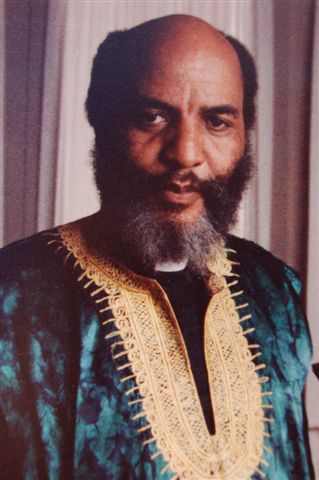
James Luther Bevel was a minister and leader of the 1960s Civil Rights Movement in the United States. As a member of the Southern Christian Leadership Conference (SCLC), and then as its Director of Direct Action and Nonviolent Education, Bevel initiated, strategized, and developed SCLC's three major successes of the era: the 1963 Birmingham Children's Crusade, the 1965 Selma voting rights movement, and the 1966 Chicago open housing movement. He suggested that SCLC call for and join a March on Washington in 1963. Bevel strategized the 1965 Selma to Montgomery marches, which contributed to Congressional passage of the 1965 Voting Rights Act.
Carol Chomsky, American linguist and educator (b. 1930) deaths

Carol Doris Chomsky was an American linguist and education specialist who studied language acquisition in children.
Michael Connell, American political consultant (b. 1963) deaths
Michael Louis Connell was a high-level Republican consultant who was subpoenaed in a case regarding alleged tampering with the 2004 U.S. Presidential election and a case involving thousands of missing emails pertaining to the political firing of U.S. Attorneys. Connell was killed when the plane he was flying crashed on December 19, 2008.
Dock Ellis, American baseball player and coach (b. 1945) deaths
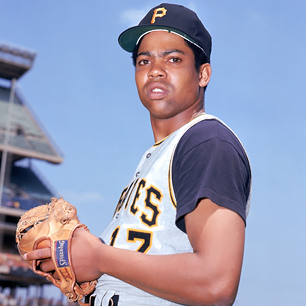
Dock Phillip Ellis Jr. was an American professional baseball player. He played in Major League Baseball as a right-handed pitcher from 1968 through 1979, most notably as a member of the Pittsburgh Pirates teams that won five National League Eastern Division titles in six years between 1970 and 1975 and won the World Series in 1971. Ellis also played for the New York Yankees, Oakland Athletics, Texas Rangers and New York Mets. In his MLB career, Ellis accumulated a 138–119 (.537) record, a 3.46 earned run average, and 1,136 strikeouts.
Vincent Gigante, American mobster (b. 1927) deaths

Vincent Louis Gigante, also known as "The Chin", was an American mobster who was boss of the Genovese crime family in New York City from 1981 to 2005. Gigante started out as a professional boxer who fought in 25 matches between 1944 and 1947. He then started working as a Mafia enforcer for what was then the Luciano crime family, forerunner of the Genovese family. Gigante was one of five brothers; three of them, Mario, Pasquale, and Ralph, followed him into the Mafia. Only one brother, Louis, stayed out of the crime family, instead becoming a priest. Gigante was the shooter in the failed assassination of longtime Luciano boss Frank Costello in 1957. In 1959, he was sentenced to seven years in prison for drug trafficking, and after sharing a prison cell with Costello's rival, Vito Genovese, Gigante became a caporegime overseeing his own crew of Genovese soldiers and associates who operated out of Greenwich Village.
Herbert C. Brown, English-American chemist and academic, Nobel Prize laureate (b. 1912) deaths

Herbert Charles Brown was an American chemist and recipient of the 1979 Nobel Prize in Chemistry for his work with organoboranes.

The Nobel Prize in Chemistry is awarded annually by the Royal Swedish Academy of Sciences to scientists in the various fields of chemistry. It is one of the five Nobel Prizes established by the will of Alfred Nobel in 1895, awarded for outstanding contributions in chemistry, physics, literature, peace, and physiology or medicine. This award is administered by the Nobel Foundation, and awarded by the Royal Swedish Academy of Sciences on proposal of the Nobel Committee for Chemistry which consists of five members elected by the Academy. The award is presented in Stockholm at an annual ceremony on 10 December, the anniversary of Nobel's death.
Renata Tebaldi, Italian soprano and actress (b. 1922) deaths
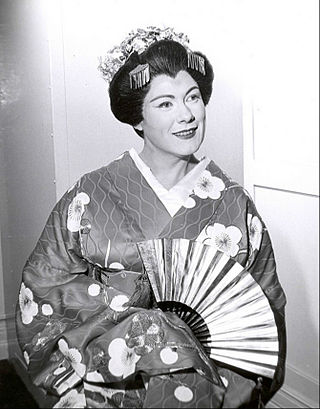
Renata Tebaldi was an Italian lirico-spinto soprano popular in the post-war period, and especially prominent as one of the stars of La Scala, San Carlo and, especially, the Metropolitan Opera. Often considered among the great opera singers of the 20th century, she focused primarily on the verismo roles of the lyric and dramatic repertoires. Italian conductor Arturo Toscanini called her voice "la voce d'angelo", and La Scala music director Riccardo Muti called her "one of the greatest performers with one of the most extraordinary voices in the field of opera."
Peter Carter-Ruck, English lawyer, founded Carter-Ruck (b. 1914) deaths

Peter Frederick Carter-Ruck was an English solicitor, specialising in libel cases. The firm he founded, Carter-Ruck, is still practising.
Carter-Ruck is a British law firm founded by Peter Carter-Ruck. The firm specialises in libel, privacy, international law and commercial disputes. The leading legal directories rank Carter-Ruck in the top tier of media, defamation and privacy lawyers in the UK.
Hope Lange, American actress (b. 1933) deaths
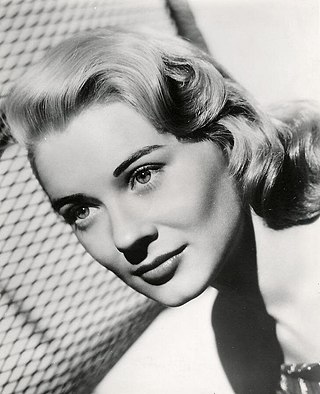
Hope Elise Ross Lange was an American film, stage, and television actress. She was nominated for the Golden Globe Award for Best Supporting Actress and the Academy Award for Best Supporting Actress for her portrayal of Selena Cross in the 1957 film Peyton Place. In 1969 and 1970, she won the Primetime Emmy Award for Outstanding Lead Actress in a Comedy Series for her role as Carolyn Muir in the sitcom The Ghost & Mrs. Muir.
Will Hoy, English race car driver (b. 1952) deaths
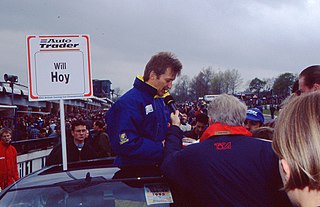
William Ewing Hoy was an English racing driver and the 1991 British Touring Car Champion, the highlight of a 20-year career in motor racing.
Arthur Rowley, English footballer and manager (b. 1926) deaths
George Arthur Rowley Jr., nicknamed "The Gunner" because of his explosive left-foot shot, was an English football player and cricketer. He holds the record for the most goals in the history of English league football, scoring 434 from 619 league games. He was the younger brother of Manchester United footballer Jack Rowley. He was shortlisted for inclusion into the English Football Hall of Fame in 2008.
George Weller, American author, playwright, and journalist (b. 1907) deaths
George Anthony Weller was an American novelist, playwright, and journalist for The New York Times and Chicago Daily News. He won a 1943 Pulitzer Prize as a Daily News war correspondent.
Nicolas Checa, American chess player births
Nicolas de T. Checa is an American chess player who holds the FIDE title of Grandmaster (GM). He is from Dobbs Ferry, New York. A chess prodigy, he began playing competitive chess at age 7. He is the recipient of the 2020 and 2021 Samford Fellowships, an award granted to the top American chess players under 25 years old. He is the 2021 and 2022 Connecticut State Champion and an undergraduate student at Yale University.
Rob Buck, American guitarist and songwriter (b. 1958) deaths
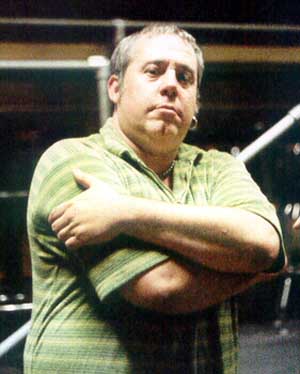
Robert Norman Buck was an American guitarist and founding member of the alternative rock band 10,000 Maniacs. Some of his compositions with Natalie Merchant are among the most popular songs recorded by 10,000 Maniacs, including "What's the Matter Here", "Hey Jack Kerouac", "You Happy Puppet" and "These Are Days".
Milt Hinton, American bassist and photographer (b. 1910) deaths
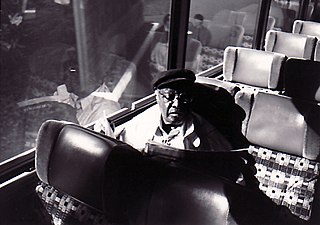
Milton John Hinton was an American double bassist and photographer.
John Lindsay, American lawyer and politician, 103rd Mayor of New York City (b. 1921) deaths

John Vliet Lindsay was an American politician and lawyer. During his political career, Lindsay was a U.S. congressman, mayor of New York City, and candidate for U.S. president. He was also a regular guest host of Good Morning America. Lindsay served as a member of the United States House of Representatives from January 1959 to December 1965 and as mayor of New York City from January 1966 to December 1973.

The mayor of New York City, officially Mayor of the City of New York, is head of the executive branch of the government of New York City and the chief executive of New York City. The mayor's office administers all city services, public property, police and fire protection, most public agencies, and enforces all city and state laws within New York City.
Desmond Llewelyn, Welsh soldier and actor (b. 1914) deaths

Desmond Wilkinson Llewelyn was a Welsh actor. He was best known for his role as Q in 17 of the James Bond films between 1963 and 1999.
Mel Fisher, American treasure hunter (b. 1922) deaths
Mel Fisher was an American treasure hunter best known for finding the 1622 wreck of the Nuestra Señora de Atocha in Florida waters.
Sara Northrup Hollister, American occultist (b. 1924) deaths
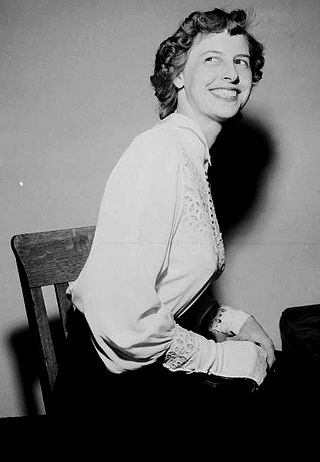
Sara Elizabeth Bruce Northrup Hollister was an occultist and second wife of Scientologist founder L. Ron Hubbard. She played a major role in the creation of Dianetics, which evolved into the religious movement Scientology. Hubbard would evolve into the leader of the Church of Scientology.
Masaru Ibuka, Japanese businessman, co-founded Sony (b. 1908) deaths
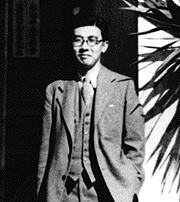
Masaru Ibuka was a Japanese electronics industrialist and co-founder of Sony, along with Akio Morita.
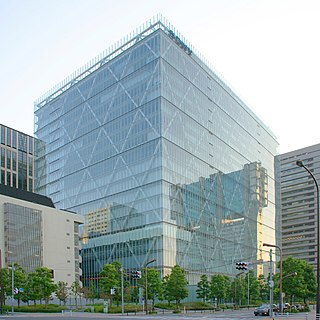
Sony Group Corporation , commonly stylized as SONY, is a Japanese multinational conglomerate corporation headquartered in Minato, Tokyo, Japan. As a major technology company, it operates as one of the world's largest manufacturers of consumer and professional electronic products, the largest video game console company and the largest video game publisher. Through Sony Entertainment Inc, it is one of the largest music companies and the third largest film studio, making it one of the most comprehensive media companies. It is the largest technology and media conglomerate in Japan. It is also recognized as the most cash-rich Japanese company, with net cash reserves of ¥2 trillion.
Jimmy Rogers, American singer-songwriter and guitarist (b. 1924) deaths

Jimmy Rogers was an American Chicago blues singer, guitarist and harmonica player, best known for his work as a member of Muddy Waters's band in the early 1950s. He also had a solo career and recorded several popular blues songs, including "That's All Right", "Chicago Bound", "Walking by Myself", and "Rock This House". He withdrew from the music industry at the end of the 1950s, but returned to recording and touring in the 1970s.
Franck Kessié, Ivorian footballer births
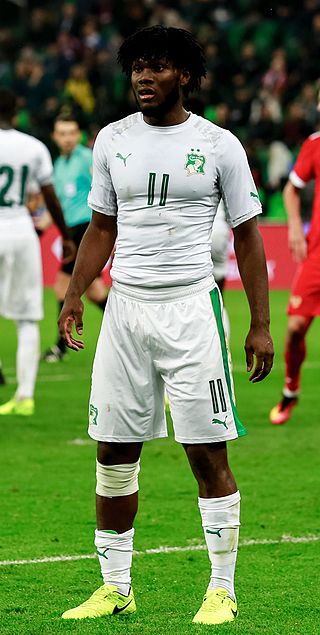
Franck Yannick Kessié is an Ivorian professional footballer who plays as a midfielder for Spanish La Liga club Barcelona and the Ivory Coast national team.
Marcello Mastroianni, Italian-French actor and singer (b. 1924) deaths

Marcello Vincenzo Domenico Mastroianni was an Italian film actor, regarded as one of his country's most iconic male performers of the 20th century. He played leading roles for many of Italy's top directors in a career spanning 147 films between 1939 and 1997, and garnered many international honors including 2 BAFTA Awards, 2 Best Actor awards at the Venice and Cannes film festivals, 2 Golden Globes, and 3 Academy Award nominations.
Maudy Ayunda, Indonesian actress and singer-songwriter births

Ayunda Faza Maudya, known as Maudy Ayunda, is an Indonesian pop singer and actress.
M'Baye Niang, French footballer births

M'Baye Hamady Niang is a professional footballer who plays as a forward for Ligue 1 club Auxerre. Born in France, he plays for the Senegal national team.
Colin Sinclair, North Mariana Islander tennis player births
Colin Sinclair is a Northern Mariana Islander tennis player.
Isiah Koech, Kenyan runner births

Isiah Kiplangat Koech is a Kenyan long-distance runner who specialises in the 5000 metres.
Young K, South Korean singer-songwriter births

Kang Young-hyun, known professionally as Young K, is a Korean musician, singer, songwriter and rapper. He is best known as the bassist, vocalist and rapper of South Korean rock band Day6.
Michael Clarke, American drummer (b. 1946) deaths

Michael Clarke was an American musician, best known as the drummer for the 1960s rock group the Byrds from 1964 to 1967. He died in 1993, at age 47, from liver failure, a direct result of more than three decades of heavy alcohol consumption.
Iker Muniain, Spanish footballer births

Iker Muniain Goñi is a Spanish footballer who plays for Athletic Bilbao, where he is captain, mainly as a left winger.
Raphael Spiegel, Swiss footballer births

Raphael Simon Spiegel is a Swiss professional footballer who plays as a goalkeeper for Lausanne-Sport.
Steven Berghuis, Dutch footballer births

Steven Berghuis is a Dutch professional footballer who plays for Eredivisie club Ajax and the Netherlands national team. He can play as either a winger or attacking midfielder.
Declan Galbraith, English singer-songwriter births
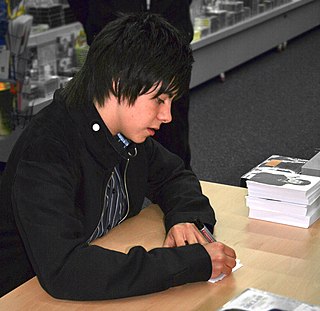
Declan John Galbraith is a British musician. He is best known for his 2002 hit single, "Tell Me Why", which peaked at #29 in the UK Singles Chart.
Sumire Uesaka, Japanese voice actress and singer births

Sumire Uesaka is a Japanese voice actress and singer associated with Voice Kit. She won the Best Rookie Actress at the 10th Seiyu Awards. She made her singing debut in April 2013 under King Records.
Torrey Craig, American basketball player births

Torrey Craig is an American professional basketball player for the Phoenix Suns of the National Basketball Association (NBA). He played college basketball for the USC Upstate Spartans, where he was named an honorable mention All-American and Atlantic Sun Conference Player of the Year in 2012. After graduating from USC Upstate in 2014, Craig spent his first three professional seasons in Australia and New Zealand. He was named New Zealand NBL MVP and won a New Zealand NBL championship with the Wellington Saints, and earned NBL Best Defensive Player honors with the Brisbane Bullets. In 2017, he began his NBA career with the Denver Nuggets.
Greg Bretz, American snowboarder births
Gregory Bretz is an American snowboarder who has competed since 2004. His first and to date only World Cup victory was in Canada in the halfpipe event in 2008.
Yong Jun-hyung, South Korean singer-songwriter, rapper and producer births

Yong Jun-hyung, commonly known as Junhyung, is a South Korean singer-songwriter, rapper, record producer and actor. Junhyung rose to fame as a member of South Korean boy band Highlight, formed in 2009. He departed from Highlight in 2019, amidst the controversy of admitting to watch illegal videos, although the police stated that Junhyung was only considered as a witness at that point in time in the Burning Sun scandal.
Michał Masłowski, Polish footballer births

Michał Masłowski is a Polish professional footballer who plays as a midfielder for Polish I liga club Zagłębie Sosnowiec. On 18 January 2014 he made his debut for Poland national football team in a friendly match against Norway.
Kousei Miura, Japanese jockey births

Kousei Miura is a Japanese jockey who is represented by the Japan Racing Association. He won the 2008 JRA Award for Newcomer Jockey with the Most Victories and the 2014 Hokkaido Horse Racing Press Club Award.
Hamza Riazuddin, English cricketer births

Hamza Riazuddin is a former English cricketer. He is a right-handed lower-order batsman and a right-arm medium-fast bowler who last played for Hampshire. He is a British Pakistani. He was born in Hendon and lived in Woodley, Berkshire for most of his childhood but now lives in Southampton, Hampshire, near to the club's training ground.
Stella Gibbons, English journalist, author, and poet (b. 1902) deaths

Stella Dorothea Gibbons was an English writer, journalist, and poet. She established her reputation with her first novel, Cold Comfort Farm (1932) which has been reprinted many times. Although she was active as a writer for half a century, none of her later 22 novels or other literary works—which included a sequel to Cold Comfort Farm—achieved the same critical or popular success. Much of her work was long out of print before a modest revival in the 21st century.
Kirill Mazurov, Belarusian Soviet politician (b. 1914) deaths

Kirill Trofimovich Mazurov was a Soviet partisan, politician, and one of the leaders of the Belarusian resistance during World War II who governed the Byelorussian Soviet Socialist Republic as First Secretary of the Communist Party of Byelorussia from 1956 until 1965, when he became a member of the Politburo of the CPSU.

The Soviet Union, officially the Union of Soviet Socialist Republics (USSR), was a transcontinental country that spanned much of Eurasia from 1922 to 1991. A flagship communist state, it was nominally a federal union of fifteen national republics; in practice, both its government and its economy were highly centralized until its final years. It was a one-party state governed by the Communist Party of the Soviet Union, with the city of Moscow serving as its capital as well as that of its largest and most populous republic: the Russian SFSR. Other major cities included Leningrad, Kiev, Minsk, Tashkent, Alma-Ata, and Novosibirsk. It was the largest country in the world, covering over 22,402,200 square kilometres (8,649,500 sq mi) and spanning eleven time zones.
Alexis Sánchez, Chilean footballer births

Alexis Alejandro Sánchez Sánchez, also known mononymously as Alexis, is a Chilean professional footballer who plays as a forward for Ligue 1 club Marseille and the Chile national team. He is often lauded as the greatest Chilean player of all time.
Peter Winn, English footballer births
Peter Harry Winn is an English semi-professional footballer who plays for Barton Town. He started his career at Scunthorpe United, making his first-team debut at the age of 16 whilst a second-year scholar. He was loaned out to Northwich Victoria and Barrow respectively towards the latter stages of the 2008–09 season. Winn joined Conference Premier club Gateshead the following season, initially on a two-month loan deal, before extending the agreement until the end of the season.
Casey Burgess, Australian television personality births

Casey Anne Burgess is an Australian television personality and singer. Burgess is a former member of the Australian children's musical group Hi-5. She was born in Sydney, the daughter of Ray Burgess, who also pursued a musical career and was a presenter on Countdown.
Robert Bernstein, American author and playwright (b. 1919) deaths
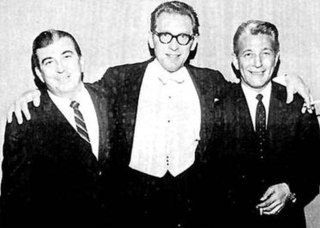
Robert Bernstein, sometimes credited as R. Berns, was an American comic book writer, playwright and concert impresario, notable as the founder of the Island Concert Hall recital series which ran for 15 years on Long Island.
Cédric Baseya, French-Congolese footballer births
Cédric Baseya is a former professional footballer who played as a forward. Born in France, he made one appearance for the DR Congo U20 national team.
Karim Benzema, French footballer births

Karim Mostafa Benzema is a French professional footballer who plays as a striker for and captains La Liga club Real Madrid, and the France national team. A creative and prolific forward, Benzema is regarded as one of the best strikers of all time. He is Real Madrid's all-time second-highest goalscorer and top assist provider. Benzema has won 23 trophies with Real Madrid, including four La Liga, two Copa del Rey and five UEFA Champions League titles.
Ronan Farrow, American activist, journalist, and lawyer births

Satchel Ronan O'Sullivan Farrow is an American journalist. The son of actress Mia Farrow and filmmaker Woody Allen, he is best known for his investigative reporting of allegations of sexual abuse against film producer Harvey Weinstein, which was published in The New Yorker magazine. The magazine won the 2018 Pulitzer Prize for Public Service for this reporting, sharing the award with The New York Times.
August Mälk, Estonian author, playwright, and politician (b. 1900) deaths
August Mälk was an Estonian writer and politician.
Calvin Andrew, English footballer births

Calvin Hyden Andrew is an English professional footballer who plays as a striker.
Ryan Babel, Dutch footballer births

Ryan Guno Babel is a Dutch professional footballer who plays for TFF First League club Eyüpspor and the Netherlands national team. He can play as a striker or left winger.
Ingrid Burley, American rapper and songwriter births
Ingrid Burley, known professionally as Ingrid, is an American singer, rapper and songwriter. Born and raised in Houston, Texas, Burley's mother was close to Tina Knowles and Mathew Knowles, who signed Burley to his record label, Music World, when she was an upcoming rap artist. She began her career at age 11, as part of Trio, which was managed by Knowles.
Lazaros Christodoulopoulos, Greek footballer births

Lazaros Christodoulopoulos is a Greek professional footballer who plays for Cypriot club Anorthosis Famagusta. He plays as a winger, a second striker or a attacking midfielder.
Zuzana Hejnová, Czech hurdler births

Zuzana Hejnová is a Czech athlete. She competes in the 100 metres, the 100 metres hurdles, the 400 metres and the 400 metres hurdles, and also the heptathlon. She is a two-time World Champion in the 400 metres hurdles, winning in 2013 and 2015.
Miguel Lopes, Portuguese footballer births

Hugo Miguel Almeida Costa Lopes is a Portuguese professional footballer who plays as a right-back for C.F. Estrela da Amadora.
V. C. Andrews, American author (b. 1923) deaths
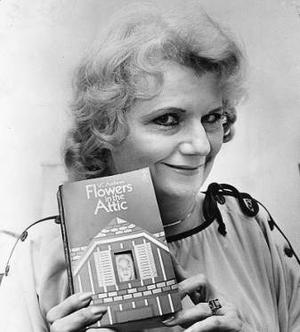
Cleo Virginia Andrews, better known as V. C. Andrews or Virginia C. Andrews, was an American novelist.
Werner Dankwort, Russian-German colonel and diplomat (b. 1895) deaths
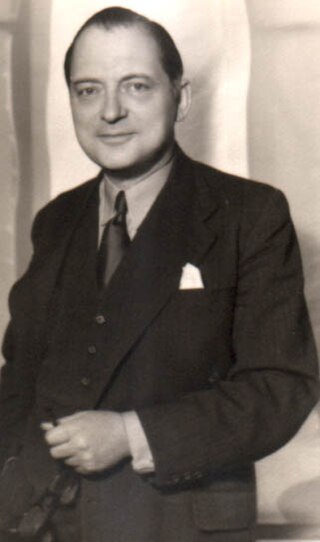
Carl Werner Dankwort born in Gumbinnen, East Prussia, was a German diplomat who served a major role in bringing Germany into the League of Nations in 1926 prior to representing the German contingent in the Organisation for European Economic Co-operation, the post-World War II effort known as the Marshall Plan.
Gary Cahill, English footballer births
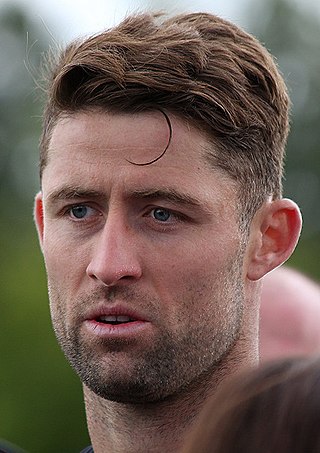
Gary James Cahill is an English former professional footballer who played as a centre-back.
Andrea Baldini, Italian fencer births

Andrea Baldini is an Italian foil fencer, several time European and World champion and team Olympic champion in 2012. He is the only foil fencer in history to have obtained four golds and the final victory in the World Cup in the same season.
Neil Kilkenny, English-Australian footballer births
Neil Martin Kilkenny is a professional footballer who plays for Australian club Western United. A midfielder, he began his career in the youth system at Arsenal, and went on to play league football for Oldham Athletic, Birmingham City, Leeds United, Bristol City, Preston North End, Melbourne City and Perth Glory before joining Western United in 2021.
Sally Kipyego, Kenyan runner births

Sally Jepkosgei Kipyego is a Kenyan-born American long- and middle-distance runner. She was the silver medalist in the 10,000 metres at the 2011 World Championships in Athletics and the silver medalist in the same race at the 2012 Summer Olympics in London. She has a personal record of 30:38.35 minutes for that event and her 5000 metres best of 14:30.42 minutes makes her the second fastest Kenyan woman for the distance.
Dan Logan, English bass player births
Dan Logan is an English musician. Formerly the bassist of Cat the Dog, he also briefly toured with The Kooks and played double bass for Brighton alt/blues band Sweet Sweet Lies as well as singing and playing all instruments in rock-a-billy side band Logan And The Faithfuls collaborating with various musicians. After a brief spell with The Lyrebirds he was briefly bassist for a reformed The Ordinary Boys, and drum tech for The Maccabees. Since 2014, Logan has played bass and sung backing vocals for Chrissie Hynde.
Lady Sovereign, English rapper births

Louise Amanda Harman, better known by the stage name Lady Sovereign, is a British rapper, best known for the songs "9 to 5" and "Love Me or Hate Me".
Ian Kennedy, American baseball player births

Ian Patrick Kennedy is an American professional baseball pitcher who is a free agent. He has played in Major League Baseball (MLB) for the New York Yankees, Arizona Diamondbacks, San Diego Padres, Kansas City Royals, Texas Rangers and Philadelphia Phillies.
Joy Ridderhof, American missionary (b. 1903) deaths
Joy Fanny Ridderhof was an American missionary.
Nektarios Alexandrou, Cypriot footballer births
Nektarios Alexandrou is a Greek Cypriot former professional footballer. He was a left flank specialist, but he primarily played as the left winger.
Casey Crescenzo, American singer-songwriter and guitarist births

Casey Crescenzo is a singer, songwriter, and multi-instrumentalist most notable for being the singer for the bands The Dear Hunter and The Receiving End of Sirens. He is also a producer who has worked with many other bands.
Bridget Phillipson, English politician births

Bridget Maeve Phillipson is a British politician serving as Shadow Secretary of State for Education since 2021. A member of the Labour Party, she has been Member of Parliament for Houghton and Sunderland South since 2010. She served as Shadow Chief Secretary to the Treasury from 2020 to 2021.
Laura Pomeroy, Canadian swimmer births
Laura Pomeroy is a Canadian swimmer.
Matt Stajan, Canadian ice hockey player births

Matthew Stajan is a Canadian former professional ice hockey centre. He was a second round selection, 57th overall, of the Toronto Maple Leafs at the 2002 NHL Entry Draft. Stajan made his NHL debut in 2004 and was a member of the Maple Leafs until he was traded to the Calgary Flames in 2010. Stajan played his final professional season with EHC Red Bull München of the Deutsche Eishockey Liga (DEL)
Mo Williams, American basketball player births
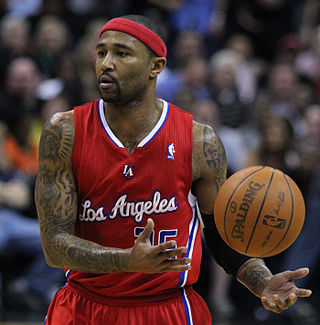
Maurice Williams is the head men's basketball coach at Jackson State University and a former professional basketball player who played 13 seasons in the National Basketball Association (NBA). After a successful high school career at Murrah High School in Jackson, Mississippi, Williams attended college at the University of Alabama, where he led his team as a freshman to a 27–8 record, and also shared an SEC regular-season championship. After two seasons at Alabama, Williams entered the 2003 NBA draft where he was selected with the 47th overall pick by the Utah Jazz. Throughout his career, he has also played for the Milwaukee Bucks, Los Angeles Clippers, Portland Trail Blazers, Minnesota Timberwolves, Charlotte Hornets and Cleveland Cavaliers. In 2009, Williams was selected as an NBA All-Star. In 2016, he won his first NBA championship with the Cavaliers. He retired in 2017.
Dwight Macdonald, American philosopher, author, and critic (b. 1906) deaths
Dwight Macdonald was an American writer, editor, film critic, social critic, literary critic, philosopher, and activist. Macdonald was a member of the New York Intellectuals and editor of their leftist magazine Partisan Review for six years. He also contributed to other New York publications including Time, The New Yorker, The New York Review of Books, and Politics, a journal which he founded in 1944.
Grégory Dufer, Belgian footballer births

Grégory Dufer is a retired Belgian international footballer.
Jake Gyllenhaal, American actor and producer births

Jacob Benjamin Gyllenhaal is an American actor. Born into the Gyllenhaal family, he is the son of director Stephen Gyllenhaal and screenwriter Naomi Foner; his older sister is actress Maggie Gyllenhaal. He began acting as a child, making his acting debut in City Slickers (1991), followed by roles in his father's films A Dangerous Woman (1993) and Homegrown (1998). His breakthrough roles were as Homer Hickam in October Sky (1999) and as a psychologically troubled teenager in Donnie Darko (2001).
Marla Sokoloff, American actress and musician births

Marla Lynne Sokoloff is an American actress. She is known for playing Lucy Hatcher on the legal drama television series The Practice, and Gia Mahan on Full House and Fuller House. She has also appeared in films True Crime (1996), Dude, Where's My Car? (2000), Sugar & Spice (2001) and Love on the Side (2004).
Kevin Devine, American singer-songwriter and guitarist births

Kevin Devine is an American songwriter and musician from Staten Island, New York City, who is known for his introspective and political themes. He is a contemporary member of the underground indie rock and indie folk musical scenes, and his influences range from older indie artists such as Neutral Milk Hotel, Elliott Smith and Pavement to more mainstream and well known acts such as Nirvana and Bob Dylan. In 2013, Kevin Devine rejoined his previous band, Miracle of 86, for a series of reunion shows.
Rafael Soriano, Dominican baseball player births

Rafael Soriano is a Dominican former professional baseball pitcher. He played in Major League Baseball (MLB) for the Seattle Mariners, Atlanta Braves, Tampa Bay Rays, New York Yankees, Washington Nationals, and Chicago Cubs.
Patrick Casey, American actor, producer, and screenwriter births
Patrick Casey is an American writer, actor, director and author. He often collaborates with writer/director/actor Worm Miller. He is best known for his work on the Fox animated series Golan the Insatiable and the Sonic the Hedgehog feature films.
Jorge Garbajosa, Spanish basketball player births

Jorge Garbajosa Chaparro, also known as The Pornoplayer, is a Spanish former professional basketball player and the current president of the Spanish Basketball Federation. Standing at 2.07 m, he played both power forward and small forward. He was an All-EuroLeague first team selection in 2003, and an All-EuroLeague second team selection in 2006, while playing for Unicaja. During his stint in the NBA, he was named to the NBA All-Rookie First Team in 2007. A serious injury the following season cut his NBA career short, and he never truly recovered until his retirement.
LaTasha Jenkins, American sprinter births
LaTasha Jenkins is an American former track and field sprinter. Having won international medals in the 200 m, she won a silver medal at the 2001 World Indoor Championships and a silver medal at the 2001 Outdoor Championships. Other career highlights include 2001 U.S. Indoor 200m champion; 1999 and 2001 US Outdoor runner-up, 200m; 1999 NCAA 200m champion; four-time NCAA All-American; member of world record-holding 4 × 200 m relay team. She was born in Chicago and attended Oak Lawn Polaris High School.
Irina Voronina, Russian model births

Irina Vadimovna Voronina is a Russian stand-up comedian, actress, and model. As a model, she was also the Playboy Playmate for January 2001.
Giuseppe Caselli, Italian painter (b. 1893) deaths
Giuseppe Ugo Caselli was an Italian painter.
Makis Belevonis, Greek footballer births

Makis Belevonis is a Greek former professional footballer who played as a right back.
Brandon Sanderson, American author and academic births

Brandon Winn Sanderson is an American author of high fantasy and science fiction. He is best known for the Cosmere fictional universe, in which most of his fantasy novels, most notably the Mistborn series and The Stormlight Archive, are set. Outside of the Cosmere, he has written several young adult and juvenile series including The Reckoners, the Skyward series, and the Alcatraz series. He is also known for finishing Robert Jordan's high fantasy series The Wheel of Time and has created several graphic novel fantasy series including White Sand and Dark One.
Jeremy Soule, Canadian composer births

Jeremy Soule is an American composer of soundtracks for film, television, and video games. He has composed soundtracks for over 60 games and over a dozen other works during his career, including The Elder Scrolls, Guild Wars, Icewind Dale, and the Harry Potter series.
Olivier Tébily, Ivorian-French footballer births

Olivier Tébily is a former professional footballer who played as a defender. A French citizen, he won 18 full international caps for his native Ivory Coast national team. He played in the top level league in four countries: for Châteauroux in Ligue 1, for Celtic in the Scottish Premier League, for Birmingham City in the English Premier League, and for Toronto FC in Major League Soccer.
Dean Treister, Australian rugby league player births
Dean Treister is an Australian former rugby league footballer who played in the 1990s, and 2000s. A member of the Cronulla-Sutherland Sharks team, Treister played many games for the club from 1993 to 2003, including the 1997 Super League Grand Final. His position of choice was hooker. Throughout his time at the Cronulla-Sutherland Sharks he was a favourite amongst the fans. Treister was known for his creative ability in attack and his ability to control the game.
Eduard Ivakdalam, Indonesian footballer births
Eduard Ivakdalam is an Indonesian retired professional footballer. Ivakdalam normally plays as a midfielder and he is a former player for Indonesia national football team.
Joe Jurevicius, American football player births

Joseph Michael Jurevicius is a retired American football wide receiver. He was drafted by the New York Giants in the second round of the 1998 NFL Draft. He played college football at Penn State.
Felipe Lopez, Dominican-American basketball player births
Luis Felipe López is a Dominican former professional basketball player. He starred as a high school player and for the St. John's Red Storm in college basketball. López played for four seasons in the National Basketball Association (NBA). He has played for teams in a half dozen countries, as well as in the Continental Basketball Association (CBA) in the U.S. Most recently, he has been a broadcaster with Spanish-language networks. His life story was the subject of an ESPN 30 for 30 documentary entitled The Dominican Dream.
Jake Plummer, American football player and sportscaster births

Jason Steven "Jake" Plummer is a former professional American football player, a quarterback for ten seasons in the National Football League (NFL). He was selected by the Arizona Cardinals in the second round of the 1997 NFL Draft, and spent his first six seasons with the Cardinals and the last four with the Denver Broncos. Plummer played college football at Arizona State University. Since retiring from the field, he made a career transition to mushroom farmer at MyCOLove Farm in Fort Lupton, Colorado. In addition, he launched UMBO, a functional mushroom supplement company alongside Former UFC Champion Rashad Evans.
Ricky Ponting, Australian cricketer and sportscaster births
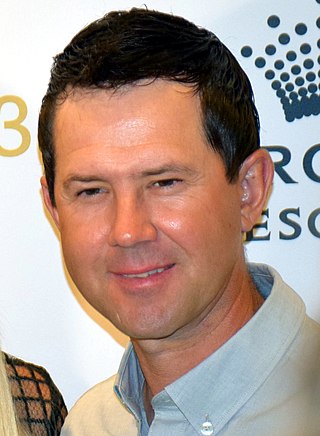
Ricky Thomas Ponting is an Australian cricket coach, commentator, and former cricketer. Ponting was captain of the Australian national team during its "golden era", between 2004 and 2011 in Test cricket and 2002 and 2011 in One Day Internationals (ODIs) and is the most successful captain in international cricket history, with 220 victories in 324 matches with a winning rate of 67.91%. He is widely considered to be one of the greatest batsmen of all time and in December 2006 reached the highest rating achieved by a Test batsman for 50 years, although this was surpassed by Steve Smith in December 2017. He stands third in the list of cricketers by number of international centuries scored, behind Sachin Tendulkar and Virat Kohli.
Michalis Grigoriou, Greek footballer and coach births

Michalis Grigoriou is a Greek professional football manager.
Erick Wainaina, Kenyan runner births
Erick Wainaina is a Kenyan marathon runner, who won an Olympic bronze medal in 1996 and a silver medal in 2000. He finished seventh in the 2004 Summer Olympics marathon in Athens, making him one of the few athletes in Olympic history to finish in the top 10 at three separate marathons.
Zulfiya Zabirova, Russian cyclist births

Zulfiya Khasanovna Zabirova is a Russian professional cycle racer who won the gold medal in the time trial event in the 1996 Olympics and later, in 2002, won the World Time Trial Championship.
Alyssa Milano, American actress and television personality births

Alyssa Jayne Milano is an American actress. She has played Samantha Micelli in Who's the Boss?, Jennifer Mancini in Melrose Place, Phoebe Halliwell in Charmed, Billie Cunningham in My Name Is Earl, Savannah "Savi" Davis in Mistresses, Renata Murphy in Wet Hot American Summer: 10 Years Later, and Coralee Armstrong in Netflix's Insatiable.
Ahmet Emin Yalman, Turkish journalist, author, and academic (b. 1888) deaths

Ahmet Emin Yalman was a Turkish journalist, author and professor. He was a liberal and opposed the spread of the Nazi ideology in his home country.
Karen Pickering, English swimmer births
Karen Denise Pickering, MBE is a former freestyle swimmer from Great Britain.
Tyson Beckford, American model and actor births

Tyson Beckford is an American model and actor best known as a Ralph Lauren Polo model. He was also the host of both seasons of the Bravo program Make Me a Supermodel. Beckford has been described as one of the most successful black male supermodels of all time, achieving fame and huge contracts similar to the female models that had huge success in the 1990s.
Michael Bates, American sprinter and football player births
Michael Dion Bates is an American former two-sport athlete who gained fame as a sprinter who won an Olympic bronze medal in the 200-meter dash in 1992. He also played football as a kick returner in the National Football League (NFL), where he was a five-time Pro Bowl selection. He played college football for the Arizona Wildcats.
Tom Gugliotta, American basketball player births
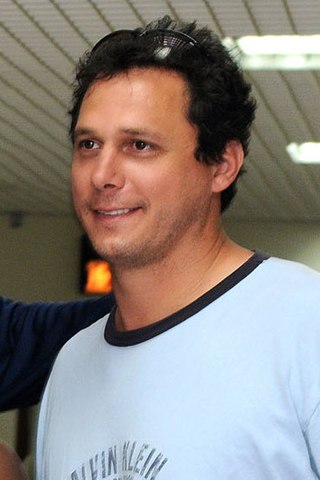
Thomas James Gugliotta is an American former professional basketball player who played thirteen seasons in the National Basketball Association (NBA).
Richard Hammond, English journalist and producer births
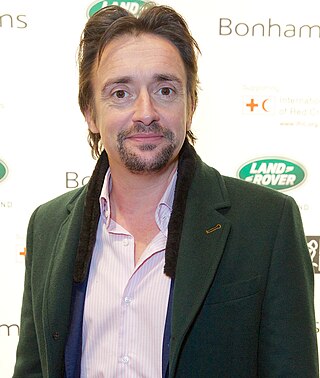
Richard Mark Hammond is an English journalist, television presenter, mechanic, and writer. He is best known for co-hosting the BBC Two motoring programme Top Gear from 2002 until 2015 with Jeremy Clarkson and James May. Since 2016, the trio have presented Amazon Studios' The Grand Tour.
Nayan Mongia, Indian cricketer births
Nayan Ramlal Mongia pronunciation (help·info) is a former Indian cricketer and cricket coach. He was a right-handed batsman and a wicketkeeper.
Aziza Mustafa Zadeh, Azerbaijani composer, pianist, and singer births
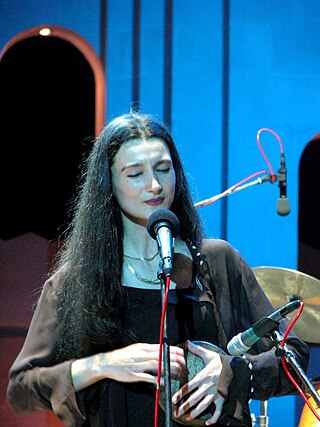
Aziza Mustafa Zadeh is an Azerbaijani singer, pianist, and composer who plays a fusion of jazz and mugham with classical and avant-garde influences.
Kristina Keneally, American-Australian politician, 42nd Premier of New South Wales births

Kristina Marie Kerscher Keneally is an American-born Australian politician who was a Labor Senator for New South Wales from February 2018 until April 2022, when she resigned to unsuccessfully contest the House of Representatives seat of Fowler. From 2019 to 2022 she served as Deputy Leader of the Opposition in the Senate, Shadow Minister for Home Affairs, and Shadow Minister for Immigration and Citizenship. She previously served as the first female Premier of New South Wales from 2009 to 2011.

The premier of New South Wales is the head of government in the state of New South Wales, Australia. The Government of New South Wales follows the Westminster Parliamentary System, with a Parliament of New South Wales acting as the legislature. The premier is appointed by the governor of New South Wales, and by modern convention holds office by his or her ability to command the support of a majority of members of the lower house of Parliament, the Legislative Assembly.
Ken Marino, American actor, director, producer, and screenwriter births

Kenneth Joseph Marino is an American actor, comedian, director, and screenwriter. He was a cast member on MTV's The State and has starred in shows such as Party Down, Marry Me, Burning Love, and Childrens Hospital. He played the Lehman brothers on the Showtime series Black Monday.
Norman Thomas, American minister and politician (b. 1884) deaths

Norman Mattoon Thomas was an American Presbyterian minister who achieved fame as a socialist, pacifist, and six-time presidential candidate for the Socialist Party of America.
Criss Angel, American magician births

Christopher Nicholas Sarantakos, known professionally as Criss Angel, is an American magician, illusionist and musician. Angel began his career in New York City, before moving his base of operations to the Las Vegas Valley. He is known for starring in the television and stage show Criss Angel Mindfreak and his previous live performance illusion show Criss Angel Believe in collaboration with Cirque du Soleil at the Luxor casino in Las Vegas. The show generated $150 million in tourist revenue to Las Vegas in 2010, but has since been replaced by Mindfreak LIVE! in 2016. He also starred in the television series Criss Angel BeLIEve on Spike TV, the reality-competition television show Phenomenon on NBC, and the 2014 stage show Criss Angel Magicjam.
Charles Austin, American high jumper births
Charles Allen Austin is an American athlete who won the gold medal in the men's high jump at the 1996 Summer Olympics in Atlanta. He was inducted into the United States Track & Field Hall of Fame in 2012. Currently, Charles and Javier Sotomayor are the only two high jumpers that have won gold medals in the Olympics, Outdoor World Championships, Indoor World Championships and World Cup Championships. Hennadiy Avdyeyenko, who won the inaugural 1983 Outdoor World Championship setting the championship high jump record with a jump of 2.32m, and Charles are the only two high jumpers to win and establish the championship record in both the Outdoor World Championship and Olympics Games. Also, Charles has the highest combined average height for the two championships.
Chuckii Booker, American singer-songwriter and producer births
Eugene Allen Booker, Jr., known professionally as Chuckii Booker, is an American producer, singer, songwriter, multi-instrumentalist and bandleader.
Rajesh Chauhan, Indian cricketer births
Rajesh Chauhan is a former Indian cricketer who played in 21 Tests and 35 One Day Internationals from 1993 to 1998. He was part of the Indian spin trio of Kumble -Raju -Chauhan, in the 1990s.
Alberto Tomba, Italian skier births

Alberto Tomba is a former World Cup alpine ski racer from Italy. He was the dominant technical skier in the late 1980s and 1990s. At 182 cm and 90 kg, his powerful build was a contrast to the lighter, more traditional technical skiers who prioritised agility over muscle. Tomba was able to take advantage of the introduction of spring-loaded ski gates which replaced the older, solid gates in the early 1980s by using his power to maintain a faster, more direct line through courses. Tomba won three Olympic gold medals, two World Championships, and nine World Cup season titles: four in slalom, four in giant slalom, and one overall title. He was popularly called Tomba la Bomba.
Eric Weinrich, American ice hockey player and coach births

Eric John Weinrich is an American former professional ice hockey defenseman who played 17 seasons in the National Hockey League (NHL) with the New Jersey Devils, Hartford Whalers, Chicago Blackhawks, Montreal Canadiens, Boston Bruins, Philadelphia Flyers, St. Louis Blues, and Vancouver Canucks. He played 1,157 career NHL games, scoring 70 goals and 318 assists for 388 points.
Chito Martínez, Belizean-American baseball player births

Reyenaldo Ignacio "Chito" Martínez, is a former Major League Baseball player and the first in MLB history to be born in the country of Belize. Born in Belize City, he spent parts of three seasons with the Baltimore Orioles, hitting 13 home runs in his rookie season and posting a slugging percentage of .514 in 216 at bats. He was also the first Orioles player to record a hit in each of his first six MLB games. It would be the high point of his career. After his power dropped dramatically in 1992, Martínez quickly faded away. He appeared in eight games in 1993 before disappearing from the major leagues.
Béatrice Dalle, French actress births

Béatrice Dalle is a French actress.
Lorie Kane, Canadian golfer births
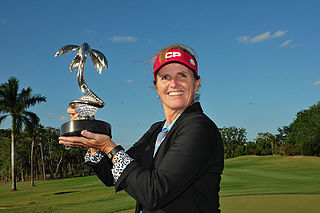
Lorie Kane, is a professional golfer on the LPGA Tour. She began her career on the LPGA Tour in 1996 and has four career victories and 99 top-10 finishes on the tour. She won the Bobbie Rosenfeld Award in 2000 and became a member of the Order of Canada at a ceremony in December 2006. Kane was the second Canadian to have multiple wins on the LPGA circuit in one season, in 2000, after Sandra Post performed the feat twice, in 1978 and 1979. The next person to do so was Brooke Henderson, in 2016. In 2015, she was inducted into the Canadian Golf Hall of Fame. In May 2020 it was announced that she would be inducted into Canada's Sports Hall of Fame as part of the class of 2020-2021.
Arvydas Sabonis, Lithuanian basketball player births
Arvydas Romas Sabonis is a Lithuanian former professional basketball player and businessman. Recognized as one of the best European players of all time, he won the Euroscar six times and the Mr. Europa Award twice. He played in a variety of leagues, including the Spanish ACB League, and spent seven seasons in the National Basketball Association (NBA). Playing the center position, Sabonis won a gold medal at the 1988 Summer Olympics, in South Korea, for the Soviet Union, and later earned bronze medals at the 1992 Olympic Games and 1996 Olympic Games representing Lithuania. He retired from professional basketball in 2005. Sabonis was selected by the Portland Trail Blazers in the first round of the 1986 NBA draft, but he did not play his first NBA game until 1995, at the age of 30.
Jennifer Beals, American model and actress births

Jennifer Beals is an American actress and former teen model. She made her film debut in My Bodyguard (1980), before receiving critical acclaim for her role in Flashdance (1983), for which she won NAACP Image Award for Outstanding Actress in a Motion Picture and was nominated for a Golden Globe Award for Best Actress – Motion Picture Comedy or Musical.
Til Schweiger, German actor, director, and producer births
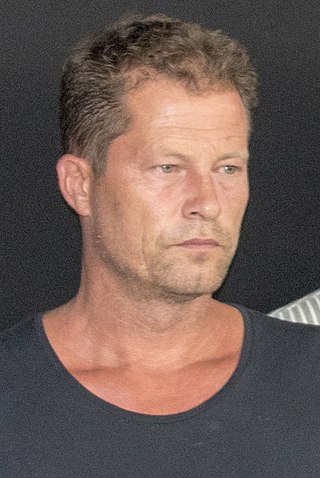
Tilman Valentin Schweiger is a German actor, voice actor and filmmaker. He runs his own production company, Barefoot Films, in Berlin.
Gary Fleder, American director, producer, and screenwriter births
Gary Fleder is an American film director, screenwriter, and producer. His most recently completed film, Homefront, was released by Open Road Films and Millennium Films in November 2013. In recent years he has been a prolific director of television pilots.
Eric Allin Cornell, American physicist and academic, Nobel Prize laureate births

Eric Allin Cornell is an American physicist who, along with Carl E. Wieman, was able to synthesize the first Bose–Einstein condensate in 1995. For their efforts, Cornell, Wieman, and Wolfgang Ketterle shared the Nobel Prize in Physics in 2001.

The Nobel Prize in Physics is a yearly award given by the Royal Swedish Academy of Sciences for those who have made the most outstanding contributions for humankind in the field of physics. It is one of the five Nobel Prizes established by the will of Alfred Nobel in 1895 and awarded since 1901, the others being the Nobel Prize in Chemistry, Nobel Prize in Literature, Nobel Peace Prize, and Nobel Prize in Physiology or Medicine. Physics is traditionally the first award presented in the Nobel Prize ceremony.
Matthew Waterhouse, English actor and author births
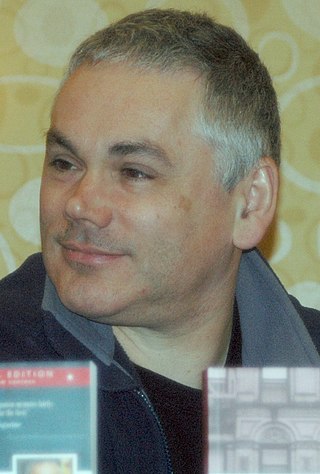
Matthew Waterhouse is an English actor and writer. From 1980 to 1982 he played the role of Adric in the BBC science fiction television series Doctor Who.
Reggie White, American football player and wrestler (d. 2004) births

Reginald Howard White was an American professional football player who played defensive end in the National Football League (NFL) for 15 seasons during the 1980s and 1990s. He played college football for the University of Tennessee, and was recognized as an All-American. After playing two professional seasons for the Memphis Showboats of the United States Football League (USFL), he was selected in the first round of the 1984 Supplemental Draft, and then played for the NFL's Philadelphia Eagles, Green Bay Packers, and Carolina Panthers, becoming one of the most awarded defensive players in NFL history.
Derrick Jensen, American author and activist births

Derrick Jensen is an American ecophilosopher, writer, author, teacher and environmentalist in the anarcho-primitivist tradition, though he rejects the label "anarchist". Utne Reader named Jensen among "50 Visionaries Who Are Changing the World" in 2008, and Democracy Now! says that he "has been called the poet-philosopher of the ecology movement".
Michelangelo Signorile, American journalist and author births

Michelangelo Signorile is an American journalist, author and talk radio host. His radio program is aired each weekday across the United States and Canada on Sirius XM Radio and globally online. Signorile was editor-at-large for HuffPost from 2011 until 2019. Signorile is a political liberal, and covers a wide variety of political and cultural issues.
Iván Vallejo, Ecuadorian mountaineer births
Iván Vallejo Ricaurte is a high-altitude mountaineer from Ecuador. On 1 May 2008, he became the 14th person to reach the summit of all 14 mountains above 8,000 meters, and the 7th without use of supplemental oxygen. He is the first, and still the only, Southern Hemisphere climber to complete all 14 eight-thousanders, without supplemental oxygen.
Lisa Wilkinson, Australian television host and journalist births

Lisa Wilkinson is an Australian television presenter and journalist.
Steven Isserlis, English cellist and author births
Steven Isserlis is a British cellist. He has led a distinguished career as a soloist, chamber musician, educator, author and broadcaster. Acclaimed for his profound musicianship, he is also noted for his diverse repertoire, command of phrasing, and distinctive sound which is deployed with his use of gut strings.
Limahl, English pop singer births

Christopher Hamill, known professionally as Limahl, is an English pop singer. He was the lead singer of the pop group Kajagoogoo beginning in 1981, before embarking on a brief solo career, garnering the 1984 hit "The NeverEnding Story", the theme song for the film of the same name.
Cyril Collard, French actor, director, and composer (d. 1993) births
Cyril Collard was a French author, filmmaker, composer, musician and actor. He is known for his unapologetic portrayals of bisexuality and HIV in art, particularly his autobiographical novel and film Les Nuits Fauves. Openly bisexual, Collard was also one of the first French artists to speak openly about his HIV-positive status.
Kevin McHale, American basketball player, coach, and manager births

Kevin Edward McHale is an American former professional basketball player, coach and analyst who played his entire professional career for the Boston Celtics. He is a Basketball Hall of Fame inductee and is regarded as one of the greatest power forwards of all time.
Phil Harris, American captain and fisherman (d. 2010) births

Phillip Charles Harris was an American captain and part owner of the crab fishing vessel F/V Cornelia Marie, which is featured on Discovery Channel's documentary reality TV series Deadliest Catch. He suffered a stroke while offloading C. opilio crab in port at Saint Paul Island, Alaska, on January 29, 2010. Despite improvements in his condition, Harris died on February 9, 2010, at the age of 53, while suffering an intracranial hemorrhage in the hospital.
Tom Lawless, American baseball player and manager births

Thomas James Lawless is a former Major League Baseball player who played between 1982 and 1990, appearing with the Cincinnati Reds, Montreal Expos, St. Louis Cardinals, and Toronto Blue Jays.
Shane McEntee, Irish farmer and politician, Minister of State at the Department of Agriculture, Food and the Marine (d. 2012) births
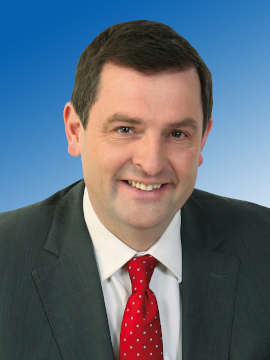
Shane Alan McEntee was an Irish Fine Gael politician who served as Minister of State at the Department of Agriculture, Food and the Marine from 2011 to 2012. He served as a Teachta Dála (TD) from 2005 to 2012.
The Minister of State at the Department of Agriculture, Food and the Marine is a junior ministerial post in the Department of Agriculture, Food and the Marine of the Government of Ireland and assists the Minister for Agriculture, Food and the Marine. A Minister of State does not hold cabinet rank.
Lincoln Hall, Australian mountaineer and author (d. 2012) births
Lincoln Ross Hall OAM was a veteran Australian mountain climber, adventurer, author and philanthropist. Lincoln was part of the first Australian expedition to climb Mount Everest in 1984, which successfully forged a new route. He reached the summit of the mountain on his second attempt in 2006, miraculously surviving the night at 8,700 m (28,543 ft) on descent, after his family was told he had died.
Rob Portman, American lawyer and politician births
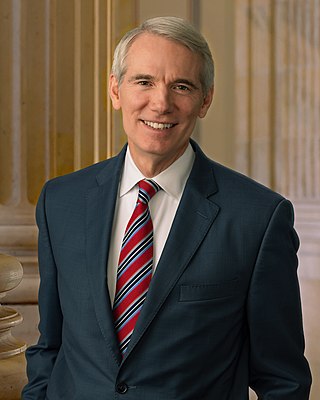
Robert Jones Portman is an American attorney and politician serving as the junior United States senator from Ohio since 2011. A member of the Republican Party, Portman was the 35th director of the Office of Management and Budget (OMB) from 2006 to 2007, the 14th United States trade representative from 2005 to 2006, and a U.S. representative from 1993 to 2005, representing Ohio's 2nd district.
Jeff Allam, English race car driver births

Jeff Allam, is a former British racing driver who made his name in Saloon Car racing. He now works as Head of Business for Allam Motor Services in Epsom which are a Skoda sales and service and Vauxhall servicing dealership.
Tim Parks, English author and translator births
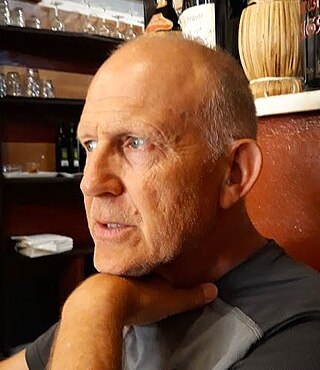
Timothy Harold Parks is a British novelist, translator, author and professor of literature.
Robert Andrews Millikan, American physicist and eugenicist, Nobel Prize laureate (b. 1868) deaths

Robert Andrews Millikan was an American experimental physicist honored with the Nobel Prize for Physics in 1923 for the measurement of the elementary electric charge and for his work on the photoelectric effect.

The Nobel Prize in Physics is a yearly award given by the Royal Swedish Academy of Sciences for those who have made the most outstanding contributions for humankind in the field of physics. It is one of the five Nobel Prizes established by the will of Alfred Nobel in 1895 and awarded since 1901, the others being the Nobel Prize in Chemistry, Nobel Prize in Literature, Nobel Peace Prize, and Nobel Prize in Physiology or Medicine. Physics is traditionally the first award presented in the Nobel Prize ceremony.
Walter Murphy, American pianist and composer births
Walter Anthony Murphy Jr. is an American composer, keyboardist, songwriter, and record producer. He is best known for the instrumental "A Fifth of Beethoven", a disco adaptation of Beethoven's Fifth Symphony which topped the charts in 1976 and was featured on the Saturday Night Fever soundtrack in 1977. Further classical–disco fusions followed, such as "Flight '76", "Rhapsody in Blue", "Toccata and Funk in 'D' Minor", "Bolero", and "Mostly Mozart", but were not as successful.
Mohammad Reza Aref, Iranian engineer and politician, 2nd Vice President of Iran births

Mohammad Reza Aref is an Iranian engineer, academic and reformist politician who was the parliamentary leader of reformists' Hope fraction in the Iranian Parliament, representing Tehran, Rey, Shemiranat and Eslamshahr. Aref has also been heading the Reformists' Supreme Council for Policymaking since its establishment in 2015.He is currently member of the Expediency Discernment Council.
The vice president of Iran is defined by article 124 of the Constitution of Iran, as anyone appointed by the president of Iran to lead an organization related to presidential affairs. As of August 2019, there are 12 vice presidents in Iran. The first vice president leads cabinet meetings in the absence of the president.
Alan Rouse, English mountaineer and author (d. 1986) births
Alan Paul Rouse was the first British climber to reach the summit of the second highest mountain in the world, K2, but died on the descent.
Eleanor J. Hill, American lawyer and diplomat births

Eleanor Jean Hill served as Inspector General for the United States Department of Defense under President Bill Clinton. Hill was the head of the Office of the Inspector General of the Department of Defense from 1995–1999.
Orna Berry, Israeli computer scientist and businesswoman births

Orna Berry, is an Israeli computer scientist, high-tech entrepreneur, and senior executive in the Israeli science and technology industries. In 1996, Berry became the first woman to serve as chief scientist and head of the industrial R&D operation of the Israeli Ministry of Industry, Trade and Labour. She was awarded the "Yekirat Hanegev" award from Ben-Gurion University of the Negev in 2012.
Claudia Kolb, American swimmer births

Claudia Anne Kolb, also known by her married name Claudia Thomas, is an American former competition swimmer, two-time Olympic champion, and former world record-holder in four events.
Sebastian, Danish singer-songwriter and guitarist births

Knud Torben Christensen, better known by his stage name Sebastian, is a Danish singer, guitarist and composer. Starting as a musician in the late 1960s he is still active and very popular. So far his career has spanned four decades. Having worked in the folk genre, he has become one of the most prominent pop/rock musicians in Denmark and has scored numerous films and plays. Since the 1990s he has primarily worked with Danish musicals, with great success.
Ken Brown, Canadian ice hockey player and sportscaster births
Kenneth Murray Brown was a Canadian professional ice hockey goaltender.
Jimmy Bain, Scottish bass player and songwriter (d. 2016) births

James Stewart Bain was a Scottish musician, best known for playing bass guitar in the bands Rainbow and Dio. He also worked with Kate Bush and Thin Lizzy frontman Phil Lynott, co-writing on his solo albums.
Rosemary Conley, English businesswoman, author, and broadcaster births
Rosemary Jean Neil Conley CBE, DL is an English businesswoman, author and broadcaster on exercise and health. Conley authored a low-fat diet and exercise programme, The Hip & Thigh Diet in 1988, which sold more than two million copies. However, her spot theory of fat reduction which claims people can lose fat specifically from the hips and thighs has no scientific basis.
Robert Urich, American actor and producer (d. 2002) births
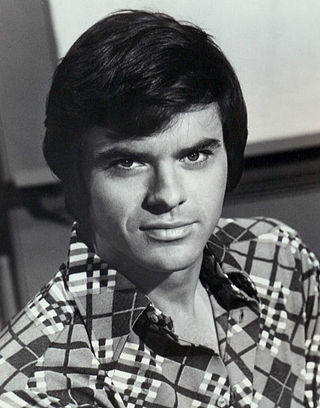
Robert Michael Urich was an American film, television, and stage actor, and television producer. Over the course of his 30-year career, he starred in a record 15 television series.
Paul Langevin, French physicist and academic (b. 1872) deaths
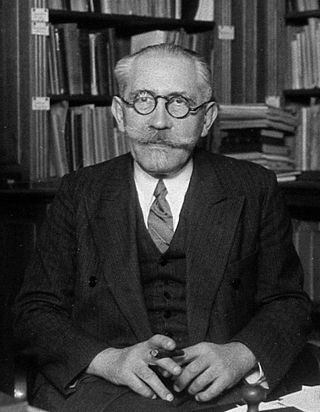
Paul Langevin was a French physicist who developed Langevin dynamics and the Langevin equation. He was one of the founders of the Comité de vigilance des intellectuels antifascistes, an anti-fascist organization created after the 6 February 1934 far right riots. Being a public opponent of fascism in the 1930s resulted in his arrest and being held under house arrest by the Vichy government for most of World War II. Langevin was also president of the Human Rights League (LDH) from 1944 to 1946, having recently joined the French Communist Party.
Elaine Joyce, American actress, singer, and dancer births

Elaine Joyce is an American actress.
John McEuen, American singer-songwriter and guitarist births

John McEuen, born December 19, 1945 in Oakland, California, is an American folk musician and a founding member of the Nitty Gritty Dirt Band.
William Christie, American-French harpsichord player and conductor births
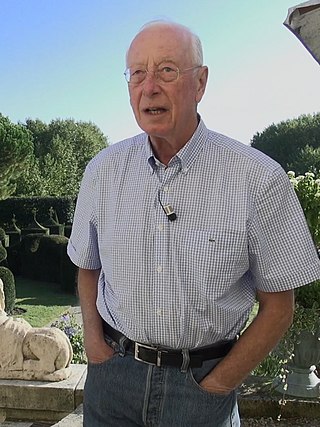
William Lincoln Christie is an American-born French conductor and harpsichordist. He is a specialist in baroque and classical repertoire and is the founder of the ensemble Les Arts Florissants.
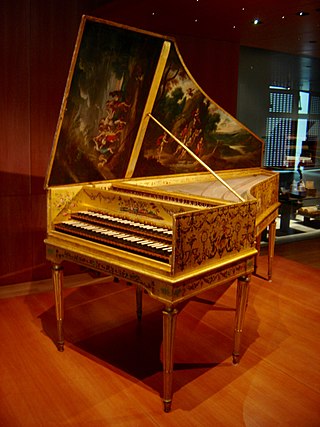
A harpsichord is a musical instrument played by means of a keyboard. This activates a row of levers that turn a trigger mechanism that plucks one or more strings with a small plectrum made from quill or plastic. The strings are under tension on a soundboard, which is mounted in a wooden case; the soundboard amplifies the vibrations from the strings so that the listeners can hear it. Like a pipe organ, a harpsichord may have more than one keyboard manual, and even a pedal board. Harpsichords may also have stop buttons which add or remove additional octaves. Some harpsichords may have a buff stop, which brings a strip of buff leather or other material in contact with the strings, muting their sound to simulate the sound of a plucked lute.
Mitchell Feigenbaum, American physicist and mathematician (d. 2019) births

Mitchell Jay Feigenbaum was an American mathematical physicist whose pioneering studies in chaos theory led to the discovery of the Feigenbaum constants.
Martin Hume Johnson, English physiologist and academic births

Martin Hume Johnson is emeritus professor of Reproductive Sciences in the Department of Physiology, Development and Neuroscience (PDN) at the University of Cambridge.
Richard Leakey, Kenyan paleontologist and politician (d. 2022) births

Richard Erskine Frere Leakey was a Kenyan paleoanthropologist, conservationist and politician. Leakey held a number of official positions in Kenya, mostly in institutions of archaeology and wildlife conservation. He was Director of the National Museum of Kenya, founded the NGO WildlifeDirect and was the chairman of the Kenya Wildlife Service.
Alvin Lee, English singer-songwriter and guitarist (d. 2013) births

Alvin Lee was an English singer, songwriter, and guitarist. He is best known as the lead vocalist and lead guitarist of the blues rock band Ten Years After.
Tim Reid, American actor and director births

Timothy Lee Reid is an American actor, comedian and film director best known for his roles in prime time American television programs, such as Venus Flytrap on WKRP in Cincinnati (1978–82), Marcel "Downtown" Brown on Simon & Simon (1983–87), Ray Campbell on Sister, Sister (1994–99) and William Barnett on That '70s Show (2004–06). Reid starred in a CBS series, Frank's Place, as a professor who inherits a Louisiana restaurant. Reid is the founder and president of Legacy Media Institute, a non-profit organization "dedicated to bringing together leading professionals in the film and television industry, outstanding actors, and young men and women who wish to pursue a career in the entertainment media".
Steve Tyrell, American singer-songwriter and producer births
Steve Tyrell is an American singer and record producer. He won a 2004 Grammy Award as the producer of the Rod Stewart studio album Stardust: The Great American Songbook, Volume III. He also hosts a jazz radio program on KKJZ at Cal State, Long Beach (California).
Zal Yanovsky, Canadian singer-songwriter and guitarist (d. 2002) births

Zalman Yanovsky was a Canadian folk-rock musician. Born in Toronto, he was the son of political cartoonist Avrom Yanovsky and teacher Nechama Yanovsky, who died in 1958. He played lead guitar and sang for the Lovin' Spoonful, a rock band which he founded with John Sebastian in 1964. He was inducted into the Canadian Music Hall of Fame in 1996. He was also inducted into the Rock and Roll Hall of Fame in 2000 as a member of the Lovin’ Spoonful. He was married to actress Jackie Burroughs, with whom he had one daughter, Zoe.
Abbas II of Egypt (b. 1874) deaths
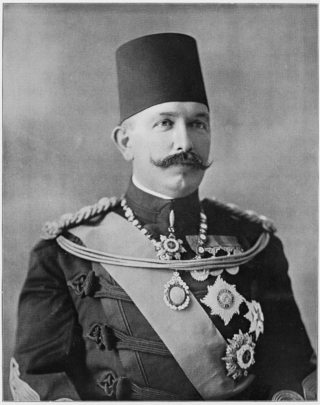
Abbas II Helmy Bey was the last Khedive of Egypt and Sudan, ruling from 8 January 1892 to 19 December 1914. In 1914, after the Ottoman Empire joined the Central Powers in World War I, the nationalist Khedive was removed by the British, then ruling Egypt, in favour of his more pro-British uncle, Hussein Kamel, marking the de jure end of Egypt's four-century era as a province of the Ottoman Empire, which had begun in 1517.
Rudolph Karstadt, German businessman (b. 1856) deaths

Rudolph Karstadt was a German entrepreneur.
Ross M. Lence, American political scientist and academic (d. 2006) births

Ross Marlo Anthony Lence, was a professor of Political Science at the University of Houston from 1971 to 2006, where he was John and Rebecca Moores Scholar and held the Ross M. Lence Distinguished Teaching Chair. He taught Political Philosophy, American Political Thought, and American Government as a member of the Political Science and Honors College faculties. His edited volume of the works of John C. Calhoun, Union and Liberty: The Political Philosophy of John C. Calhoun, is one of the foremost references on the statesman.
James L. Jones, American general and politician, 22nd United States National Security Advisor births

James Logan Jones Jr. is a retired United States Marine Corps four-star general and consultant who served as the 21st United States National Security Advisor from 2009 to 2010. During his military career, he served as the 32nd Commandant of the Marine Corps from July 1999 to January 2003, and Commander, United States European Command and Supreme Allied Commander Europe from 2003 to 2006. Jones retired from the Marine Corps on February 1, 2007, after 40 years of service.

The Assistant to the President for National Security Affairs (APNSA), commonly referred to as the National Security Advisor (NSA), is a senior aide in the Executive Office of the President, based at the West Wing of the White House. The National Security Advisor serves as the principal advisor to the President of the United States on all national security issues. The National Security Advisor is appointed by the President and does not require confirmation by the United States Senate. An appointment of a three- or four-star General to the role requires Senate confirmation to maintain that rank in the new position. The National Security Advisor participates in meetings of the National Security Council (NSC) and usually chairs meetings of the Principals Committee of the NSC with the Secretary of State and Secretary of Defense. The NSA also sits on the Homeland Security Council (HSC).The National Security Advisor is supported by NSC staff who produce classified research and briefings for the National Security Advisor to review and present, either to the National Security Council or directly to the President.
Cornell Dupree, American guitarist (d. 2011) births

Cornell Luther Dupree was an American jazz and R&B guitarist. He worked at various times with Aretha Franklin, Bill Withers, Donny Hathaway, King Curtis and Steve Gadd, appeared on David Letterman, and wrote a book on soul and blues guitar, Rhythm and Blues Guitar. He reportedly recorded on 2,500 sessions.
"Mean Gene" Okerlund, American sports announcer (d. 2019) births
Eugene Arthur Okerlund, better known by his ring name "Mean Gene" Okerlund, was an American professional wrestling interviewer, announcer and television host. He was best known for his work in the World Wrestling Federation and World Championship Wrestling. Okerlund was inducted into the WWE Hall of Fame in 2006 by Hulk Hogan. He was signed to a lifetime contract with WWE and later worked for promotional programs. He has been described by journalists as the best interviewer in the history of professional wrestling.
Lee Myung-bak, South Korean businessman and politician, 10th President of South Korea births

Lee Myung-bak is a South Korean businessman and politician who served as the 10th president of South Korea from 2008 to 2013. Before his presidency, he was the CEO of Hyundai Engineering and Construction, and the mayor of Seoul from 2002 to 2006.

The president of the Republic of Korea, also known as the president of South Korea, is the head of state and head of government of the Republic of Korea. The president leads the State Council, and is the chief of the executive branch of the national government as well as the commander-in-chief of the Republic of Korea Armed Forces.
Maurice White, American singer-songwriter and producer (d. 2016) births

Maurice White was an American singer, musician, songwriter, and record producer. He was best known as the founder, leader, main songwriter, and producer of the band Earth, Wind & Fire, and served as the band's co-lead singer with Philip Bailey.
Phil Ochs, American singer-songwriter and guitarist (d. 1976) births
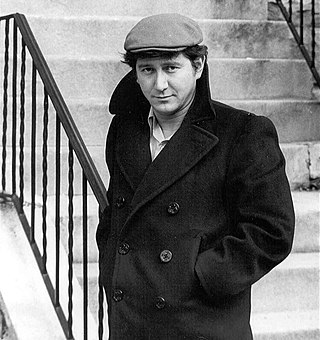
Philip David Ochs was an American songwriter and protest singer. Ochs was known for his sharp wit, sardonic humor, political activism, often alliterative lyrics, and distinctive voice. He wrote hundreds of songs in the 1960s and 1970s and released eight albums.
Kyösti Kallio, Finnish politician, the 4th President of Finland (b. 1873) deaths

Kyösti Kallio was a Finnish politician of the Agrarian League who served as the fourth president of Finland from 1937–1940; his presidency included leading the country through the Winter War. He was the first President of Finland to resign and the only president to die in office. Kallio was also the only president of Finland who did not have an academic or similar degree.

The president of the Republic of Finland is the head of state of Finland. Under the Constitution of Finland, executive power is vested in the Finnish Government and the president, with the latter possessing only residual powers. The president is directly elected by universal suffrage for a term of six years. Since 1994, no president may be elected for more than two consecutive terms. The president must be a natural-born Finnish citizen. The presidential office was established in the Constitution Act of 1919. The incumbent president is Sauli Niinistö. He was elected for the first time in 2012 and was re-elected in 2018.
Stephen Warfield Gambrill, American lawyer and politician (b. 1873) deaths

Stephen Warfield Gambrill was an American politician.
Bobby Timmons, American pianist and composer (d. 1974) births

Robert Henry Timmons was an American jazz pianist and composer. He was a sideman in Art Blakey's Jazz Messengers for two periods, between which he was part of Cannonball Adderley's band. Several of Timmons' compositions written when part of these bands – including "Moanin'", "Dat Dere", and "This Here" – enjoyed commercial success and brought him more attention. In the early and mid-1960s he led a series of piano trios that toured and recorded extensively.
Joanne Weaver, American baseball player (d. 2000) births
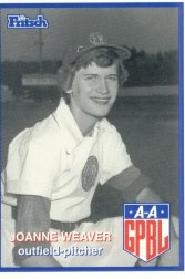
Joanne "Joltin' Jo" Weaver was a right fielder who played from 1951 through 1954 in the All-American Girls Professional Baseball League. Listed at 5 ft 11 in (1.80 m), 142 lb., she batted and threw right-handed.
Tony Taylor, Cuban baseball player (d. 2020) births
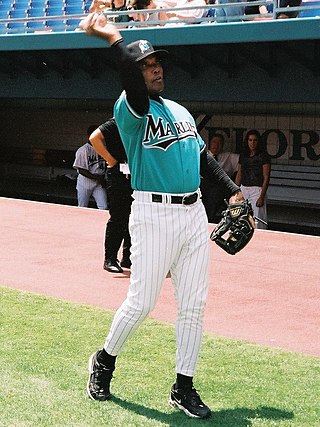
Antonio Nemesio Taylor Sánchez was a Cuban baseball second baseman who played 19 seasons in Major League Baseball (MLB). He played for the Chicago Cubs, Philadelphia Phillies, and Detroit Tigers from 1958 until 1976. He batted and threw right-handed and also played third base and first base.
Al Kaline, American baseball player and sportscaster (d. 2020) births
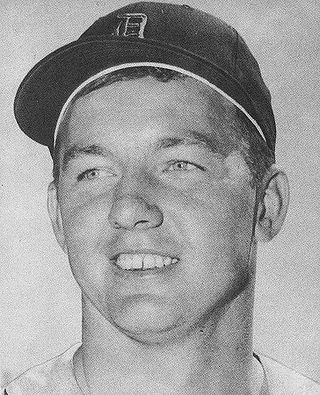
Albert William Kaline, nicknamed "Mr. Tiger", was an American professional baseball right fielder who played 22 seasons in Major League Baseball (MLB) for the Detroit Tigers. For most of his career, Kaline played in the outfield, mainly as a right fielder where he won ten Gold Glove Awards and was known for his strong throwing arm. He was selected to 18 All-Star Games, including selections each year between 1955 and 1967. He was elected to the Baseball Hall of Fame in 1980, his first time on the ballot.
Pratibha Patil, Indian lawyer and politician, 12th President of India births

Prathibha Devingish Patil is an Indian politician and lawyer who served as the 12th president of India spanning from 2007 to 2012. She is the first woman to become the president of India. A member of the Indian National Congress, she previously served as the Governor of Rajasthan from 2004 to 2007, and was a member of Lok Sabha from 1991 to 1996.

The president of India is the head of state of the Republic of India. The president is the nominal head of the executive, the first citizen of the country, as well as the commander-in-chief of the Indian Armed Forces. Droupadi Murmu is the 15th and current president, having taken office from 25 July 2022.
Casper R. Taylor, Jr., American lawyer and politician births
Casper R. Taylor Jr. served as Speaker of the Maryland House of Delegates from 1994–2003, among the longest Speaker's tenures in Maryland history.
Kevan Gosper, Australian runner and politician births
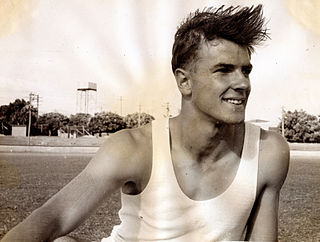
Richard Kevan Gosper, AO is an Australian former athlete who mainly competed in the 400 metres. He was formerly a Vice President of the International Olympic Committee, and combined Chairman and CEO of Shell Australia.
Christopher Smout, Scottish historian and academic births
Thomas Christopher Smout CBE, FBA, FRSE, FSA Scot, FRSGS is a Scottish academic, historian, author and Historiographer Royal in Scotland.
George Jackson Churchward, English engineer and businessman (b. 1857) deaths
George Jackson Churchward was an English railway engineer, and was chief mechanical engineer of the Great Western Railway (GWR) in the United Kingdom from 1902 to 1922.
Salvador Elizondo, Mexican author, poet, playwright, and critic (d. 2006) births
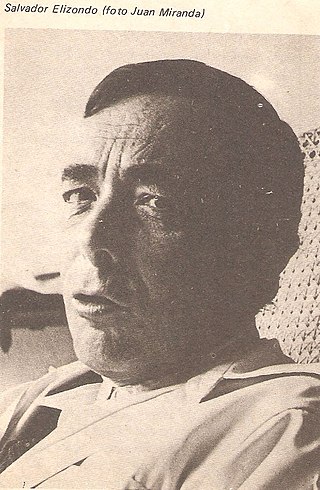
Salvador Elizondo Alcalde was a Mexican writer of the 60s Generation of Mexican literature.
Lola Hendricks, African American civil rights activist (d. 2013) births
Lola Mae Haynes Hendricks was corresponding secretary for Fred Shuttlesworth's Alabama Christian Movement for Human Rights from 1956 to 1963. She assisted Wyatt Walker in planning the early portions of the Southern Christian Leadership Conference's involvement in the 1963 Birmingham campaign during the Civil Rights Movement.
Wayne Tippit, American actor (d. 2009) births
Wayne Tippit was an American television and stage character actor. He was best known to television audiences for playing Ted Adamson on the 1970s and 1980s CBS soap opera, Search for Tomorrow, for five years. He later portrayed Palmer Woodward, the father of Heather Locklear's character, Amanda Woodward, on the Fox primetime soap opera, Melrose Place, during the 1990s.
Yun Bong-gil, South Korean activist (b. 1908) deaths
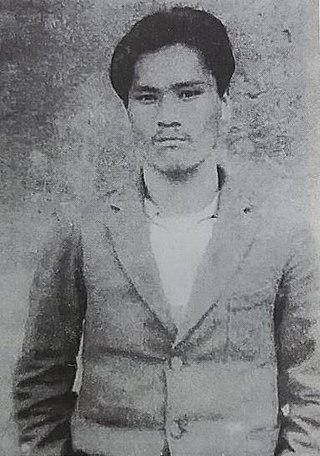
Yun Bong-gil was a Korean independence activist who set off a bomb that killed several Japanese dignitaries in Shanghai's Hongkew Park in 1932. He was posthumously awarded the Republic of Korea Medal of Order of Merit for National Foundation in 1962 by the South Korean government.
Ginger Stanley, American model, actress and stunt woman births

Ginger Stanley is an American model, actress and stunt woman.
Wally Olins, English businessman and academic (d. 2014) births
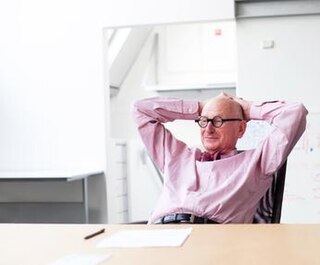
Wallace Olins CBE was a British practitioner of corporate identity and branding. He co-founded Wolff Olins and Saffron Brand Consultants and was the chairman of both. Olins advised many of the world's leading organisations on identity, branding, communication and related matters including 3i, Akzo Nobel, Repsol, Q8, The Portuguese Tourist Board, BT, Renault, Volkswagen, Tata and Lloyd's of London. He acted as advisor both to McKinsey and Bain. He pioneered the concept of the nation as a brand and has worked on branding projects for a number of cities and countries, including London, Mauritius, Northern Ireland, Poland, Portugal, and Lithuania.
Knut Helle, Norwegian historian and professor (d. 2015) births
Knut Helle was a Norwegian historian. A professor at the University of Bergen from 1973 to 2000, he specialized in the late medieval history of Norway. He has contributed to several large works.
Bob Brookmeyer, American trombonist, pianist, and composer (d. 2011) births

Robert Edward "Bob" Brookmeyer was an American jazz valve trombonist, pianist, arranger, and composer. Born in Kansas City, Missouri, Brookmeyer first gained widespread public attention as a member of Gerry Mulligan's quartet from 1954 to 1957. He later worked with Jimmy Giuffre, before rejoining Mulligan's Concert Jazz Band. He garnered 8 Grammy Award nominations during his lifetime.
David Douglas, 12th Marquess of Queensberry, Scottish potter births
David Harrington Angus Douglas, 12th Marquess of Queensberry is an Anglo-Scottish aristocrat and pottery designer. He is the elder son of Francis Douglas, 11th Marquess of Queensberry, and his only son by his second wife, artist Cathleen Sabine Mann. His maternal grandparents were an interior decorator, Dolly Mann and artist Harrington Mann. He succeeded his father in 1954.
Gregory Carroll, American singer-songwriter and producer (d. 2013) births
John Wayne Carroll, usually known as Gregory Carroll or Greg Carroll, was an American R&B singer, songwriter, and record producer. He was a member of several successful vocal harmony or "doo-wop" groups including The Four Buddies and The Orioles, and co-wrote and produced Doris Troy's 1963 hit "Just One Look".
Howard Sackler, American playwright and screenwriter (d. 1982) births
Howard Oliver Sackler was an American screenwriter and playwright who is best known for writing The Great White Hope. The Great White Hope enjoyed both a successful run on Broadway and, as a film adaptation, in movie theaters. James Earl Jones and Jane Alexander both starred in the original Arena Stage production of the play in Washington, DC, then brought their roles to Broadway and later to the film version. Both Jones and Alexander received Academy Award nominations for their work in the movie.
Eve Bunting, Irish-American author and academic births
Anne Evelyn Bunting , also known as Eve Bunting, is a Northern Ireland-born American writer of more than 250 books. Her work covers a broad array of subjects and includes fiction and non-fiction books. Her novels are primarily aimed at children and young adults, but she has also written the text for picture books. While many of her books are set in Northern Ireland, where she grew up, her topics and settings range from Thanksgiving to riots in Los Angeles. Bunting's first book, The Two Giants, was published in 1971. Due to the popularity of her books with children, she has been listed as one of the Educational Paperback Association's top 100 authors.
Nathan Oliveira, American painter and sculptor (d. 2010) births
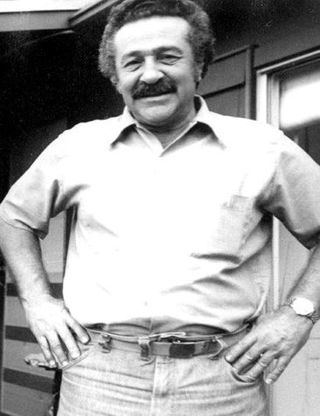
Nathan Oliveira was an American painter, printmaker, and sculptor, born in Oakland, California to immigrant Portuguese parents. Since the late 1950s, Oliveira has been the subject of nearly one hundred solo exhibitions, in addition to having been included in hundreds of group exhibitions in important museums and galleries worldwide. He taught studio art for several decades in California, beginning in the early 1950s, when he taught at the California College of Arts and Crafts in Oakland. After serving as a Visiting Artist at several universities, he became a Professor of Studio Art at Stanford University.
James Booth, English actor and screenwriter (d. 2005) births

James Booth was an English film, stage and television actor and screenwriter. Though considered handsome enough to play leading roles, and versatile enough to play a wide variety of character parts, Booth naturally projected a shifty, wolfish, or unpredictable quality that led inevitably to villainous roles and comedy, usually with a cockney flavour. He is best known for his role as Private Henry Hook in Zulu.
Ashfaqulla Khan, Indian activist (b. 1900) deaths

Ashfaqulla Khan was an Indian independence activist in the Indian independence movement and co-founder of the Hindustan Republican Association.
Ram Prasad Bismil, Indian poet and activist (b. 1897) deaths

Ram Prasad Bismil was an Indian poet, writer, revolutionary and an Indian freedom fighter who participated in the Mainpuri Conspiracy of 1918, and the Kakori Conspiracy of 1925, and fought against British Raj. He also had a good command over Urdu and the Hindi languages and was an accomplished poet, composing in these languages using the pen names Ram, Agyat and Bismil, the latter through which he became famously known by. He was also a multilingual translator and his Hindi poem "Manipuri ki Pratigya" became very famous. Bismil was hanged on 19 December 1927 by the British for his revolutionary activities. He was associated with Arya Samaj where he got inspiration from Satyarth Prakash, a book written by Swami Dayanand Saraswati. He also had a confidential connection with Lala Har Dayal through his guru Swami Somdev, a preacher of Arya Samaj. Bismil was one of the founding members of the revolutionary organization Hindustan Republican Association. Bhagat Singh praised him as a great poet-writer of Urdu and Hindi, who had also translated the books Catherine from English and Bolshevikon Ki Kartoot from Bengali.
Bobby Layne, American football player and coach (d. 1986) births

Robert Lawrence Layne was an American football quarterback who played for 15 seasons in the National Football League. He played for the Chicago Bears in 1948, the New York Bulldogs in 1949, the Detroit Lions from 1950–1958, and the Pittsburgh Steelers from 1958–1962.
Fikret Otyam, Turkish painter and journalist (d. 2015) births
Fikret Otyam was a Turkish painter and journalist.
Tankred Dorst, German author and playwright (d. 2017) births
Tankred Dorst was a German playwright and storyteller.
William Schutz, American psychologist and academic (d. 2002) births

William Schutz was an American psychologist.
Robert B. Sherman, American songwriter and screenwriter (d. 2012) births

Robert Bernard Sherman was an American songwriter, best known for his work in musical films with his brother, Richard M. Sherman. The Sherman brothers produced more motion picture song scores than any other songwriting team in film history. Some of their songs were incorporated into live action and animation musical films including Mary Poppins, The Happiest Millionaire, The Jungle Book, The Many Adventures of Winnie the Pooh, Chitty Chitty Bang Bang, The Slipper and the Rose, and Charlotte's Web. Their best-known work is "It's a Small World " possibly the most-performed song in history.
Carlo Chiti, Italian engineer (d. 1994) births

Carlo Chiti was an Italian racing car and engine designer best known for his long association with Alfa Romeo's racing department. He also worked for Ferrari and was involved in the design of the Ferrari 156 Sharknose car, with which Phil Hill won the 1961 championship.
Doug Harvey, Canadian ice hockey player and coach (d. 1989) births

Douglas Norman Harvey was a Canadian professional hockey defenceman and coach who played in the National Hockey League (NHL) from 1947 until 1964, and from 1966 until 1969. Best known for playing with the Montreal Canadiens, Harvey also played for the New York Rangers, Detroit Red Wings, and St. Louis Blues, as well as several teams in the minor leagues. He also served as the player-coach of the Rangers for one season, and served a similar role for the minor-league Kansas City Blues.
Gary Morton, American comedian and producer (d. 1999) births

Gary Morton was an American stand-up comedian whose primary venues were hotels and resorts of the Borscht Belt in upstate New York. He was born in New York City, the son of Morris Goldaper and Rose Greenfeder Goldaper, and had a sister, Helen. Later, he was a producer and studio executive, in association with his second wife, Lucille Ball.
Edmund Purdom, British-Italian actor (d. 2009) births
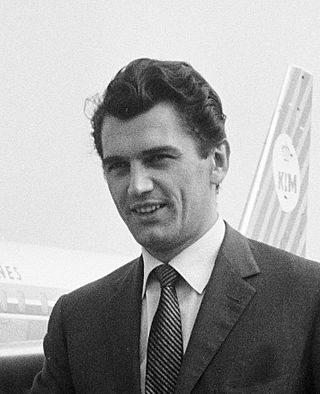
Edmund Anthony Cutlar Purdom was an English actor, voice artist, and director. He worked first on stage in Britain, performing various works by Shakespeare, then in America on Broadway and in Hollywood, and eventually in Italy. He is perhaps best known for his starring role in 1954's historical epic The Egyptian.
Michel Tournier, French journalist and author (d. 2016) births

Michel Tournier was a French writer. He won awards such as the Grand Prix du roman de l'Académie française in 1967 for Friday, or, The Other Island and the Prix Goncourt for The Erl-King in 1970. His inspirations included traditional German culture, Catholicism and the philosophies of Gaston Bachelard. He resided in Choisel and was a member of the Académie Goncourt. His autobiography has been translated and published as The Wind Spirit. He was on occasion in contention for the Nobel Prize in Literature.
Cicely Tyson, American actress (d. 2021) births
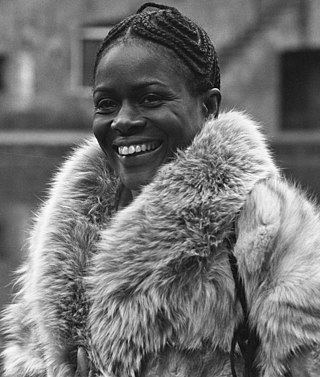
Cicely Louise Tyson was an American actress. In a career which spanned more than seven decades in film, television and theatre, she became known for her portrayal of strong African-American women. Tyson received various awards including three Emmy Awards, a Screen Actors Guild Award, a Tony Award, an Honorary Academy Award, and a Peabody Award.
Robert V. Bruce, American historian and author (d. 2008) births

Robert Vance Bruce was an American historian specializing in the American Civil War, who won the 1988 Pulitzer Prize for History for his book The Launching of Modern American Science, 1846–1876 (1987). After serving in the Army during World War II, Bruce graduated from the University of New Hampshire, where he earned his Bachelor of Science in mechanical engineering. He received his Master of Arts in history and his Doctor of Philosophy from Boston University, where he was later a professor. He also taught at the University of Bridgeport, Lawrence Academy at Groton, and the University of Wisconsin. Bruce was also a lecturer at the Fortenbaugh Lecture at Gettysburg College.
Gordon Jackson, Scottish-English actor and singer (d. 1990) births

Gordon Cameron Jackson, was a Scottish actor best remembered for his roles as the butler Angus Hudson in Upstairs, Downstairs and as George Cowley, the head of CI5, in The Professionals. He also portrayed Capt Jimmy Cairns in Tunes of Glory, and Flt. Lt. Andrew MacDonald, "Intelligence", in The Great Escape.
Eamonn Andrews, Irish radio and television host (d. 1987) births

Eamonn Andrews, was an Irish radio and television presenter, employed primarily in the United Kingdom from the 1950s to the 1980s. From 1960 to 1964 he chaired the Radio Éireann Authority, which oversaw the introduction of a state television service in the Republic of Ireland.
Little Jimmy Dickens, American singer-songwriter and guitarist (d. 2015) births

James Cecil Dickens, better known by his stage name Little Jimmy Dickens, was an American country music singer and songwriter famous for his humorous novelty songs, his small size, and his rhinestone-studded outfits. He started as a member of the Grand Ole Opry in 1948 and was inducted into the Country Music Hall of Fame in 1983. Before his death he was the oldest living member of the Grand Ole Opry.
David Susskind, American talk show host and producer (d. 1987) births
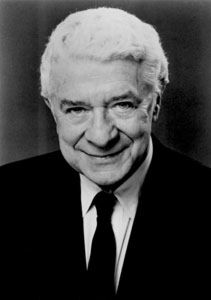
David Howard Susskind was an American producer of TV, movies, and stage plays and also a TV talk show host. His talk shows were innovative in the genre and addressed timely, controversial topics beyond the scope of others of the day.
Professor Longhair, American singer-songwriter and pianist (d. 1980) births
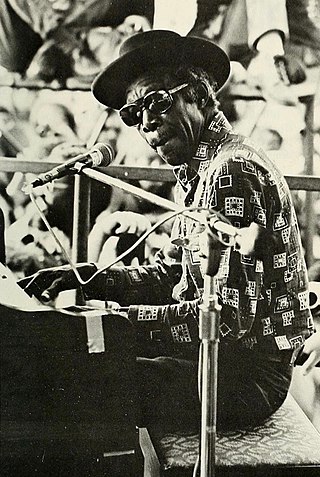
Henry Roeland "Roy" Byrd, better known as Professor Longhair or "Fess" for short, was an American singer and pianist who performed New Orleans blues. He was active in two distinct periods, first in the heyday of early rhythm and blues and later in the resurgence of interest in traditional jazz after the founding of the New Orleans Jazz and Heritage Festival in 1970. His piano style has been described as "instantly recognizable, combining rumba, mambo, and calypso".
Lee Rich, American producer and production manager (d. 2012) births

Lee Rich was an American film and television producer, who won the 1973 Outstanding Drama Series Emmy award for The Waltons as the producer. He is also known as the co-founder and former chairman of Lorimar Television.
Roy Ward Baker, English director and producer (d. 2010) births

Roy Ward Baker was an English film director. His best known film is A Night to Remember (1958) which won a Golden Globe for Best English-Language Foreign Film in 1959. His later career included many horror films and television shows.
Elisabeth Noelle-Neumann, German political scientist, journalist, and academic (d. 2010) births

Elisabeth Noelle-Neumann was a German political scientist. Her most famous contribution is the model of the spiral of silence, detailed in The Spiral of Silence: Public Opinion – Our Social Skin. The model is an explanation of how perceived public opinion can influence individual opinions or actions.
Thibaw Min, Burmese king (b. 1859) deaths

Thibaw Min, also Thebaw or Theebaw was the last king of the Konbaung dynasty of Burma (Myanmar) and also the last Burmese monarch in the country's history. His reign ended when the forces of the Burmese Empire were defeated by the forces of the British Empire in the Third Anglo-Burmese War, on 29 November 1885, prior to its official annexation on 1 January 1886.
Édith Piaf, French singer-songwriter and actress (d. 1963) births

Édith Piaf was a French singer, lyricist and actress. Noted as France's national chanteuse, she was one of the country's most widely known international stars.
Claudia Testoni, Italian hurdler, sprinter, and long jumper (d. 1998) births
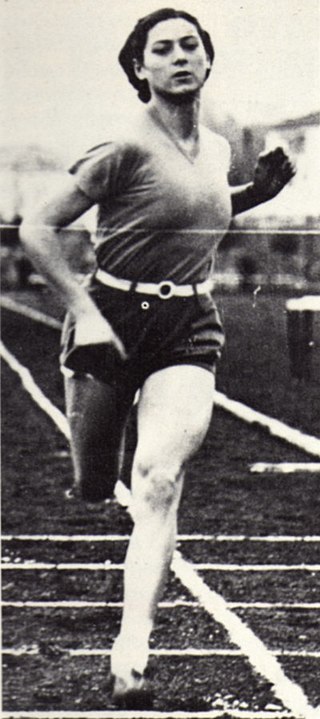
Claudia Testoni, was an Italian hurdler, sprinter and long jumper. She was European champion, in 1938, on 80 metres hurdles. She was born in Bologna and died in Cagliari.
Alois Alzheimer, German psychiatrist and neuropathologist (b. 1864) deaths

Alois Alzheimer was a German psychiatrist and neuropathologist and a colleague of Emil Kraepelin. Alzheimer is credited with identifying the first published case of "presenile dementia", which Kraepelin would later identify as Alzheimer's disease.
Mel Shaw, American animator and screenwriter (d. 2012) births
Mel Shaw was an American animator, design artist, writer, and artist. Shaw was involved in the animation, story design, and visual development of numerous Disney animated films, beginning with Bambi, which was released in 1942. His other animated film credits, usually involving animation design or the story, included The Rescuers in 1977, The Fox and the Hound in 1981, The Black Cauldron in 1985, The Great Mouse Detective in 1986, Beauty and the Beast in 1991, and The Lion King in 1994. He was named a Disney Legend in 2004 for his contributions to the Walt Disney Company.
Jean Genet, French novelist, playwright, and poet (d. 1986) births

Jean Genet was a French novelist, playwright, poet, essayist, and political activist. In his early life he was a vagabond and petty criminal, but he later became a writer and playwright. His major works include the novels The Thief's Journal and Our Lady of the Flowers and the plays The Balcony, The Maids and The Screens.
W. A. Criswell, American pastor and author (d. 2002) births

Wallie Amos Criswell, was an American pastor, author, and a two-term elected president of the Southern Baptist Convention from 1968 to 1970. As senior pastor of the First Baptist Church of Dallas for five decades he became widely known for expository biblical preaching at a popular level, and is regarded as a key figure in the late 1970s "Conservative Resurgence" within the Southern Baptist Convention.
Jimmy McLarnin, Irish-American boxer, actor, and golfer (d. 2004) births

James Archibald McLarnin was an Irish professional boxer who became a two-time welterweight world champion and an International Boxing Hall of Fame inductee.
Leonid Brezhnev, Ukrainian-Russian marshal, engineer, and politician, 4th Head of State of the Soviet Union (d. 1982) births

Leonid Ilyich Brezhnev was a Soviet politician who served as General Secretary of the Communist Party of the Soviet Union between 1964 and 1982 and Chairman of the Presidium of the Supreme Soviet between 1960 and 1964 and again between 1977 and 1982. His 18-year term as General Secretary was second only to Joseph Stalin's in duration. Brezhnev's tenure as General Secretary remains debated by historians; while his rule was characterised by political stability and significant foreign policy successes, it was also marked by corruption, inefficiency, economic stagnation, and rapidly growing technological gaps with the West.
The Constitution of the Soviet Union recognised the Presidium of the Supreme Soviet and the earlier Central Executive Committee (CEC) of the Congress of Soviets as the highest organs of state authority in the Union of Soviet Socialist Republics (USSR) between legislative sessions. Under the 1924, 1936 and 1977 Soviet Constitutions these bodies served as the collective head of state of the Soviet Union. The Chairman of these bodies personally performed the largely ceremonial functions assigned to a single head of state but was provided little real power by the constitution.
Irving Kahn, American businessman (d. 2015) births

Irving Kahn was an American investor and philanthropist. He was the oldest living active investor. He was an early disciple of Benjamin Graham, who popularized the value investing methodology. Kahn began his career in 1928 and continued to work until his death. He was chairman of Kahn Brothers Group, Inc., the privately owned investment advisory and broker-dealer firm that he founded with his sons, Thomas and Alan, in 1978.
Giovanni Lurani, Italian race car driver, engineer, and journalist (d. 1995) births

Giovanni “Johnny” Lurani Cernuschi, VIII Count of Calvenzano was an Italian automobile engineer, racing car driver and journalist.
George Davis Snell, American geneticist and immunologist, Nobel Prize laureate (d. 1996) births
George Davis Snell NAS was an American mouse geneticist and basic transplant immunologist.

The Nobel Prize in Physiology or Medicine is awarded yearly by the Nobel Assembly at the Karolinska Institute for outstanding discoveries in physiology or medicine. The Nobel Prize is not a single prize, but five separate prizes that, according to Alfred Nobel's 1895 will, are awarded "to those who, during the preceding year, have conferred the greatest benefit to humankind". Nobel Prizes are awarded in the fields of Physics, Chemistry, Physiology or Medicine, Literature, and Peace.
Ralph Richardson, English actor (d. 1983) births
Sir Ralph David Richardson was an English actor who, with John Gielgud and Laurence Olivier, was one of the trinity of male actors who dominated the British stage for much of the 20th century. He worked in films throughout most of his career, and played more than sixty cinema roles. From an artistic but not theatrical background, Richardson had no thought of a stage career until a production of Hamlet in Brighton inspired him to become an actor. He learned his craft in the 1920s with a touring company and later the Birmingham Repertory Theatre. In 1931 he joined the Old Vic, playing mostly Shakespearean roles. He led the company the following season, succeeding Gielgud, who had taught him much about stage technique. After he left the company, a series of leading roles took him to stardom in the West End and on Broadway.
Rudolf Hell, German engineer, invented the Hellschreiber (d. 2002) births

Rudolf Hell was a German inventor and engineer.
The Hellschreiber, Feldhellschreiber or Typenbildfeldfernschreiber is a facsimile-based teleprinter invented by Rudolf Hell. Compared to contemporary teleprinters that were based on typewriter systems and were mechanically complex and expensive, the Hellschreiber was much simpler and more robust, with far fewer moving parts. It has the added advantage of being capable of providing intelligible communication even over very poor quality radio or cable links, where voice or other teledata would be unintelligible.
Oliver La Farge, American anthropologist and author (d. 1963) births

Oliver Hazard Perry La Farge II was an American writer and anthropologist. In 1925 he explored early Olmec sites in Mexico, and later studied additional sites in Central America and the American Southwest. In addition to more than 15 scholarly works, mostly about Native Americans, he wrote several novels, including the Pulitzer Prize-winning, Laughing Boy (1929). La Farge also wrote and published short stories, in such leading magazines as The New Yorker and Esquire.
Fritz Mauruschat, German footballer and manager (d. 1974) births
Fritz Mauruschat (1901–1974) was a German football player and manager.
Martin Luther King Sr., American pastor, missionary, and activist (d. 1984) births

Martin Luther King Sr. was an African-American Baptist pastor, missionary, and an early figure in the Civil Rights Movement. He was the father and namesake of the civil rights leader Martin Luther King Jr.
Henry Ware Lawton, American general (b. 1843) deaths

Henry Ware Lawton was a U.S. Army officer who served with distinction in the Civil War, the Apache Wars, and the Spanish–American War. He was the only U.S. general officer to be killed during the Philippine–American War and the first general officer of the United States killed in overseas action. The city of Lawton, Oklahoma, takes its name from General Lawton, as does a borough in the city of Havana, Cuba. Liwasang Bonifacio in downtown Manila was formerly named Plaza Lawton in his honor.
Ingeborg Refling Hagen, Norwegian author and educator (d. 1989) births

Ingeborg Refling Hagen was a Norwegian author, poet, and artistic director. Her writings and activities in support of the arts made her a significant cultural figure in Norway during much of the 20th century.
Ford Frick, American journalist and businessman (d. 1978) births

Ford Christopher Frick was an American sportswriter and baseball executive. After working as a teacher and as a sportswriter for the New York American, he served as public relations director of the National League (NL), then as the league's president from 1934 to 1951. He was the third Commissioner of Major League Baseball (MLB) from 1951 to 1965.
Edward Bernard Raczyński, Polish politician and diplomat, 4th President-in-exile of Poland (d. 1993) births

Count Edward Bernard Raczyński was a Polish diplomat, writer, politician, President of Poland-in-exile.

The Polish government-in-exile, officially known as the Government of the Republic of Poland in exile, was the government in exile of Poland formed in the aftermath of the Invasion of Poland of September 1939, and the subsequent occupation of Poland by Germany and the Soviet Union, which brought to an end the Second Polish Republic.
Fritz Reiner, Hungarian-American conductor (d. 1963) births

Frederick Martin "Fritz" Reiner was a prominent conductor of opera and symphonic music in the twentieth century. Hungarian born and trained, he emigrated to the United States in 1922, where he rose to prominence as a conductor with several orchestras. He reached the pinnacle of his career while music director of the Chicago Symphony Orchestra in the 1950s and early 1960s.
Antonín Zápotocký, Czech politician, President of the Czechoslovak Socialist Republic (d. 1957) births
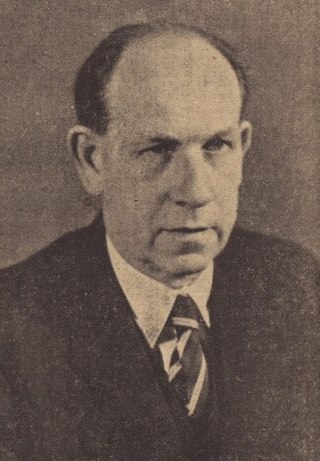
Antonín Zápotocký was a Czech communist politician and statesman who served as the prime minister of Czechoslovakia from 1948 to 1953 and the president of Czechoslovakia from 1953 to 1957.

The president of Czechoslovakia was the head of state of Czechoslovakia, from the creation of the First Czechoslovak Republic in 1918 until the dissolution of the Czech and Slovak Federative Republic on 1 January 1993.

The Czechoslovak Socialist Republic, formerly known from 1948 to 1960 as the Czechoslovak Republic or Fourth Czechoslovak Republic, was the official name of Czechoslovakia from 1960 to 29 March 1990, when it was renamed the Czechoslovak Federative Republic. On 23 April 1990, it became the Czech and Slovak Federative Republic. From 1948 until the end of November 1989, the country was under Communist rule and was regarded as a satellite state in the Soviet sphere of interest.
Bayard Taylor, American author and poet (b. 1825) deaths

Bayard Taylor was an American poet, literary critic, translator, travel author, and diplomat. As a poet, he was very popular, with a crowd of more than 4,000 attending a poetry reading once, which was a record that stood for 85 years. His travelogues were popular in both the United States and Great Britain. He served in diplomatic posts in Russia and Prussia.
Bernard Friedberg, Austrian-Israeli scholar and author (d. 1961) births
Bernard Friedberg was an Austrian Hebraist, scholar and bibliographer.
Mileva Marić, Serbian physicist (d. 1948) births

Mileva Marić, sometimes called Mileva Marić-Einstein, was a Serbian physicist and mathematician and the first wife of Albert Einstein from 1903 to 1919. She was the only woman among Einstein's fellow students at Zürich Polytechnic and was the second woman to finish a full program of study at the Department of Mathematics and Physics. Marić and Einstein were collaborators and lovers and had a daughter Lieserl in 1902, whose fate is unknown. They later had two sons, Hans Albert and Eduard.
Carter G. Woodson, American historian and author, founded Black History Month (d. 1950) births

Carter Godwin Woodson was an American historian, author, journalist, and the founder of the Association for the Study of African American Life and History (ASALH). He was one of the first scholars to study the history of the African diaspora, including African-American history. A founder of The Journal of Negro History in 1916, Woodson has been called the "father of black history". In February 1926 he launched the celebration of "Negro History Week", the precursor of Black History Month. Woodson was an important figure to the movement of Afrocentrism, due to his perspective of placing people of African descent at the center of the study of history and the human experience.
Black History Month is an annual observance originating in the United States, where it is also known as African-American History Month. It has received official recognition from governments in the United States and Canada, and more recently has been observed in Ireland, and the United Kingdom. It began as a way of remembering important people and events in the history of the African diaspora. It is celebrated in February in the United States and Canada, while in Ireland, and the United Kingdom it is observed in October.
Grace Marie Bareis, American mathematician (d. 1962) births
Grace Marie Bareis was an American mathematician and educator who became the first person to receive a doctorate degree in mathematics from Ohio State University. Bareis was an assistant professor at Ohio State University where she taught for 40 years until her eventual retirement in 1946.
Alphonse Kirchhoffer, French fencer (d. 1913) births

Simon Alphonse Kirchhoffer was a French fencer who competed in the late 19th century and early 20th century.
Minnie Maddern Fiske, American actress and playwright (d. 1932) births
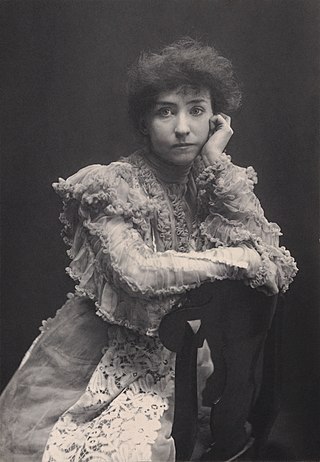
Minnie Maddern Fiske, but often billed simply as Mrs. Fiske, was one of the leading American actresses of the late 19th and early 20th century. She also spearheaded the fight against the Theatrical Syndicate for the sake of artistic freedom. She was widely considered the most important actress on the American stage in the first quarter of the 20th century. Her performances in several Henrik Ibsen plays helped introduced American audiences to the Norwegian playwright.
Wallace Bryant, American archer (d. 1953) births

Wallace Bryant was an American archer who competed in the 1904 Summer Olympics. He won the bronze medal in the team competition. In the Double York round he finished fourth and in the Double American round he finished eighth. Bryant was also a famous portrait artist.
Italo Svevo, Italian author and playwright (d. 1928) births

Aron Hector Schmitz, better known by the pseudonym Italo Svevo, was an Italian writer, businessman, novelist, playwright, and short story writer.
Charles Fitzpatrick, Canadian lawyer and politician, 12th Lieutenant-Governor of Quebec (d. 1942) births

Sir Charles Fitzpatrick was a Canadian lawyer and politician, who served as the fifth Chief Justice of Canada. He was born in Quebec City, Canada East, to John Fitzpatrick and Mary Connolly.
The following is a list of the lieutenant governors of Quebec. Though the present day office of the lieutenant governor in Quebec came into being only upon the province's entry into Canadian Confederation in 1867, the post is a continuation from the first governorship of New France in 1627, through the governor generalcy of New France, and the governorship of the Province of Quebec. From 1786 to 1841, the Governors General of The Canadas simultaneously acted as the direct governor of Lower Canada, only occasionally appointing a lieutenant to act in their stead.
Albert Abraham Michelson, Prussian-American physicist, chemist, and academic, Nobel Prize laureate (d. 1931) births

Albert Abraham Michelson FFRS HFRSE was a German-born American physicist of Polish/Jewish origin, known for his work on measuring the speed of light and especially for the Michelson–Morley experiment. In 1907 he received the Nobel Prize in Physics, becoming the first American to win the Nobel Prize in a science. He was the founder and the first head of the physics departments of Case School of Applied Science and the University of Chicago.

The Nobel Prize in Physics is a yearly award given by the Royal Swedish Academy of Sciences for those who have made the most outstanding contributions for humankind in the field of physics. It is one of the five Nobel Prizes established by the will of Alfred Nobel in 1895 and awarded since 1901, the others being the Nobel Prize in Chemistry, Nobel Prize in Literature, Nobel Peace Prize, and Nobel Prize in Physiology or Medicine. Physics is traditionally the first award presented in the Nobel Prize ceremony.
Joseph Mallord William Turner, English painter (b. 1775) deaths

Joseph Mallord William Turner, known in his time as William Turner, was an English Romantic painter, printmaker and watercolourist. He is known for his expressive colouring, imaginative landscapes and turbulent, often violent marine paintings. He left behind more than 550 oil paintings, 2,000 watercolours, and 30,000 works on paper. He was championed by the leading English art critic John Ruskin from 1840, and is today regarded as having elevated landscape painting to an eminence rivalling history painting.
Henry Clay Frick, American businessman and financier (d. 1919) births

Henry Clay Frick was an American industrialist, financier, and art patron. He founded the H. C. Frick & Company coke manufacturing company, was chairman of the Carnegie Steel Company, and played a major role in the formation of the giant U.S. Steel manufacturing concern. He also financed the construction of the Pennsylvania Railroad and the Reading Company, and had extensive real estate holdings in Pittsburgh and throughout the state of Pennsylvania. He later built the historic neoclassical Frick Mansion, and upon his death donated his extensive collection of old master paintings and fine furniture to create the celebrated Frick Collection and art museum. However, as a founding member of the South Fork Fishing and Hunting Club, he was also in large part responsible for the alterations to the South Fork Dam that caused its failure, leading to the catastrophic Johnstown Flood. His vehement opposition to unions also caused violent conflict, most notably in the Homestead Strike.
Emily Brontë, English novelist and poet (b. 1818) deaths

Emily Jane Brontë was an English novelist and poet who is best known for her only novel, Wuthering Heights, now considered a classic of English literature. She also published a book of poetry with her sisters Charlotte and Anne titled Poems by Currer, Ellis and Acton Bell with her own poems finding regard as poetic genius. Emily was the second-youngest of the four surviving Brontë siblings, between the youngest Anne and her brother Branwell. She published under the pen name Ellis Bell.
Bernice Pauahi Bishop, American philanthropist (d. 1884) births

Bernice Pauahi Bishop KGCOK RoK, born Bernice Pauahi Pākī, was an aliʻi (noble) of the Royal Family of the Kingdom of Hawaii and a well known philanthropist. At her death, her estate was the largest private landownership in the Hawaiian Islands, comprising approximately 9% of Hawaii's total area. The revenues from these lands are used to operate the Kamehameha Schools, which were established in 1887 according to Pauahi's will. Pauahi was married to businessman and philanthropist Charles Reed Bishop.
George Frederick Bristow, American violinist and composer (d. 1898) births
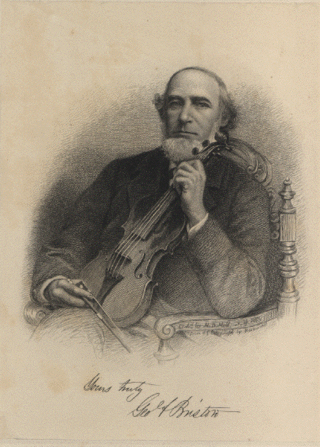
George Frederick Bristow was an American composer. He advocated American classical music, rather than favoring European pieces. He was famously involved in a related controversy involving William Henry Fry and the New York Philharmonic Society.
Mary Livermore, American journalist and activist (d. 1905) births

Mary Livermore was an American journalist, abolitionist, and advocate of women's rights. Her printed volumes included: Thirty Years Too Late, first published in 1847 as a prize temperance tale, and republished in 1878; Pen Pictures; or, Sketches from Domestic Life; What Shall We Do with Our Daughters? Superfluous Women, and Other Lectures; and My Story of the War. A Woman's Narrative of Four Years' Personal Experience as Nurse in the Union Army, and in Relief Work at Home, in Hospitals, Camps and at the Front during the War of the Rebellion. For Women of the Day, she wrote the sketch of the sculptress, Miss Anne Whitney; and for the Centennial Celebration of the First Settlement of the Northwestern States, at Marietta, Ohio, July 15, 1788, she delivered the historical address.
Thomas Fremantle, English admiral and politician (b. 1765) deaths

Vice-Admiral Sir Thomas Francis Fremantle, 1st Freiherr von Fremantle, was a British naval officer in the Royal Navy whose accolades include three separate fleet actions, a close friendship with Lord Nelson, and a barony in Austria. He was the father of Admiral Sir Charles Fremantle, after whom the city Fremantle, in Western Australia, is named.
James J. Archer, American lawyer and general (d. 1864) births
James Jay Archer was a lawyer and an officer in the United States Army during the Mexican–American War. He later served as a brigadier general in the Confederate States Army (CSA) during the American Civil War.
James McGill, Scottish-Canadian businessman and philanthropist, founded McGill University (b. 1744) deaths

James McGill was a Scottish Canadian businessman and philanthropist best known for being the founder of McGill University, Montreal. He was elected to the Legislative Assembly of Lower Canada for Montreal West in 1792 and was appointed to the Executive Council of Lower Canada in 1793. He was the honorary Lieutenant-Colonel of the 1st Battalion, Montreal Militia, a predecessor unit of The Canadian Grenadier Guards. He was also a prominent member of the Château Clique and one of the original founding members of the Beaver Club. His summer home stood within the Golden Square Mile.
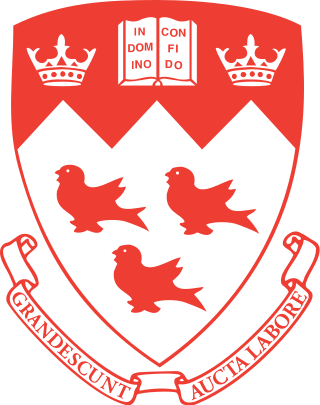
McGill University is an English-language public research university located in Montreal, Quebec, Canada. Founded in 1821 by royal charter granted by King George IV, the university bears the name of James McGill, a Scottish merchant whose bequest in 1813 formed the university's precursor, University of McGill College ; the name was officially changed to McGill University in 1885.
Friedrich Melchior, Baron von Grimm, German-French author and playwright (b. 1723) deaths

Friedrich Melchior, Baron von Grimm was a German-born French-language journalist, art critic, diplomat and contributor to the Encyclopédie ou Dictionnaire raisonné des sciences, des arts et des métiers. In 1765 Grimm wrote Poème lyrique, an influential article for the Encyclopédie on lyric and opera librettos. Like Christoph Willibald Gluck and Ranieri de' Calzabigi, Grimm became interested in opera reform. According to Martin Fontius, a German literary theorist, "sooner or later a book entitled The Aesthetic Ideas of Grimm will have to be written."
Antoine Louis Dugès, French obstetrician and naturalist (d. 1838) births

Antoine Louis Dugès was a French obstetrician and naturalist born in Charleville-Mézières, Ardennes. He was the father of zoologist Alfredo Dugès (1826–1910), and a nephew to midwife Marie-Louise Lachapelle (1769–1821).
Manuel Bretón de los Herreros, Spanish poet, playwright, and critic (d. 1873) births
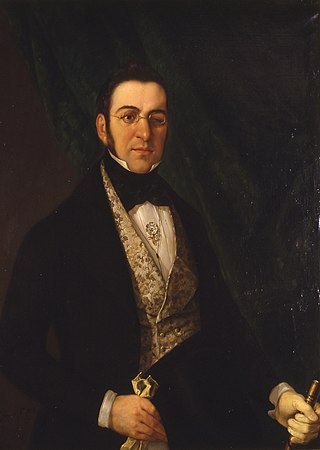
Manuel Bretón de los Herreros was a Spanish dramatist.
Marie Thérèse of France (d. 1851) births
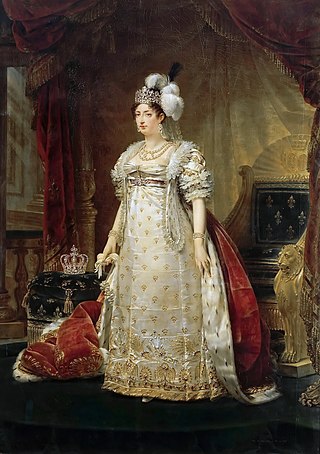
Marie-Thérèse Charlotte was the eldest child of King Louis XVI and Queen Marie Antoinette of France. In 1799 she married her cousin Louis Antoine, Duke of Angoulême, the eldest son of Charles, Count of Artois, henceforth becoming the Duchess of Angoulême. She was briefly disputed Queen of France in 1830. Marie-Thérése was the only child of her parents to reach adulthood.
Francesco Antonio Bonporti, Italian priest and composer (b. 1672) deaths

Francesco Antonio Bonporti was an Italian priest and amateur composer.
Jean-Baptiste van Loo, French painter (b. 1684) deaths

Jean-Baptiste van Loo was a French subject and portrait painter.
Vitus Bering, Dutch explorer (b. 1681) deaths

Vitus Jonassen Bering, also known as Ivan Ivanovich Bering, was a Danish cartographer and explorer in Russian service, and an officer in the Russian Navy. He is known as a leader of two Russian expeditions, namely the First Kamchatka Expedition and the Great Northern Expedition, exploring the north-eastern coast of the Asian continent and from there the western coast on the North American continent. The Bering Strait, the Bering Sea, Bering Island, the Bering Glacier, and Vitus Lake were all named in his honor.
John Winthrop, American astronomer and educator (d. 1779) births

John Winthrop was an American mathematician, physicist and astronomer. He was the 2nd Hollis Professor of Mathematics and Natural Philosophy in Harvard College.
William Bowyer, English printer (d. 1777) births

William Bowyer was an English printer known as "the learned printer".
Philip V of Spain (d. 1746) births
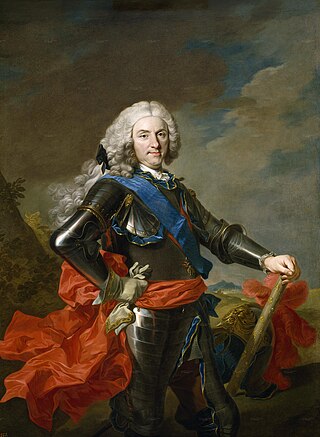
Philip V was King of Spain from 1 November 1700 to 14 January 1724, and again from 6 September 1724 to his death in 1746. His total reign of 45 years is the longest in the history of the Spanish monarchy. Philip instigated many important reforms in Spain, most especially the centralization of power of the monarchy and the suppression of regional privileges, via the Nueva Planta decrees, and restructuring of the administration of the Spanish Empire on the Iberian peninsula and its overseas regions.
Christina of Lorraine, Grand Duchess consort of Tuscany (b. 1565) deaths
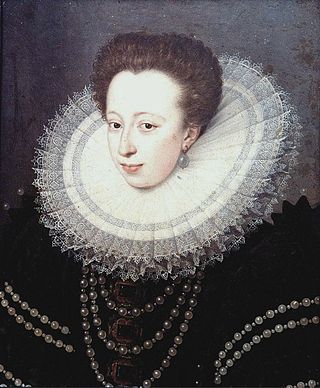
Christina of Lorraine or Christine de Lorraine was a member of the House of Lorraine and was the Grand Duchess of Tuscany by marriage. She served as Regent of Tuscany jointly with her daughter-in-law during the minority of her grandson from 1621 to 1628.
Dorothea Sophia, Abbess of Quedlinburg (d. 1645) births

Duchess Dorothea Sophia of Saxe-Altenburg was Princess-Abbess of Quedlinburg.
Cornelius Grapheus, Flemish writer (b. 1482) deaths

Cornelius Grapheus, Latinized from Cornelis De Schrijver, was a secretary to the city of Antwerp and writer.
Philip William, Prince of Orange (d. 1618) births

Philip William, Prince of Orange was the eldest son of William the Silent by his first wife Anna van Egmont. He became Prince of Orange in 1584 and Knight of the Golden Fleece in 1599.
Andreas Osiander, German Protestant theologian (d. 1552) births
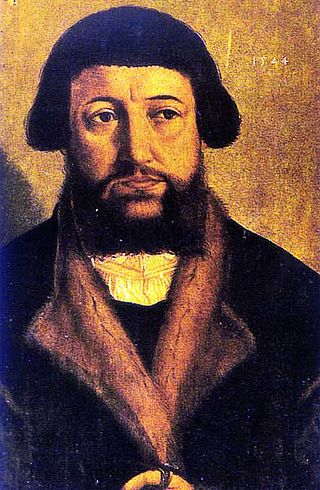
Andreas Osiander was a German Lutheran theologian and Protestant reformer.
Elizabeth of Luxembourg (b. 1409) deaths

Elizabeth of Luxembourg was queen consort of Germany, Hungary and Bohemia.
Bernabò Visconti, Lord of Milan (b. 1319) deaths

Bernabò or Barnabò Visconti was an Italian soldier and statesman who was Lord of Milan. Along with his brothers Matteo and Galeazzo II, he inherited the lordship of Milan from his uncle Giovanni. Later in 1355, he and Galeazzo II were rumoured to have murdered their brother Matteo since he endangered the regime. When Galeazzo II died, he shared Milan's lordship with his nephew Gian Galeazzo. Bernabò was a ruthless despot toward his subjects and did not hesitate to face emperors and popes including Pope Urban V. The conflict with the Church cost him several excommunications. On 6 May 1385, his nephew Gian Galeazzo deposed him. Imprisoned in his castle, Trezzo sull'Adda, he died a few months later, presumably from poisoning.

Milan is a city in northern Italy, capital of Lombardy, and the second-most populous city proper in Italy after Rome. The city proper has a population of about 1.4 million, while its metropolitan city has 3.26 million inhabitants. Its continuously built-up urban area is the fourth largest in the EU with 5.27 million inhabitants. According to national sources, the population within the wider Milan metropolitan area, is estimated between 8.2 million and 12.5 million making it by far the largest metropolitan area in Italy and one of the largest in the EU.
Pope Urban V (b. 1310) deaths
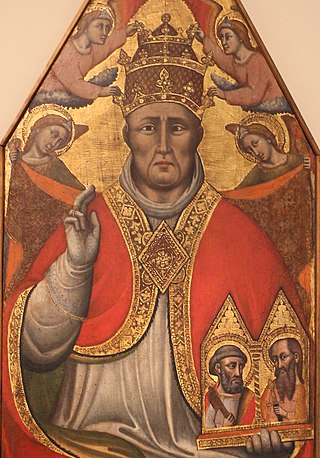
Pope Urban V, born Guillaume de Grimoard, was the head of the Catholic Church from 28 September 1362 until his death in December 1370 and was also a member of the Order of Saint Benedict. He was the only Avignon pope to be beatified.
William I, Margrave of Meissen (d. 1407) births
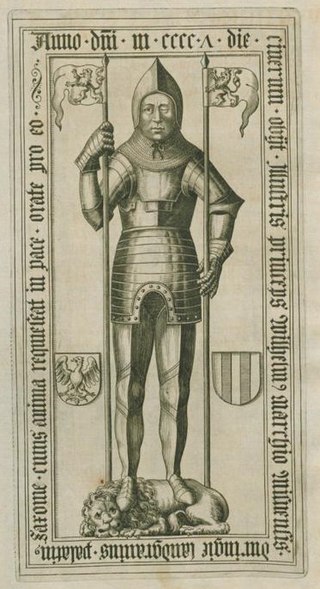
William I, the one-eyed, was Margrave of Meissen. His nickname is related to the legend that Saint Benno appeared to him because of his disputes with the Church in a dream and he had an eye gouged out.
Agnes of France, Duchess of Burgundy (b. 1260) deaths

Agnes of France was Duchess of Burgundy by marriage to Robert II, Duke of Burgundy. She served as regent of Burgundy during the minority of her son in 1306–1311.
Saint Berardo, Italian bishop and saint deaths
Berardo is an Italian saint, patron saint of the city and diocese of Teramo.
Al-Ghazali, Persian jurist, philosopher, theologian, and mystic (b. 1058) deaths

Al-Ghazali, full name Abū Ḥāmid Muḥammad ibn Muḥammad aṭ-Ṭūsiyy al-Ġazzālīy, and known in Persian-speaking countries as Imam Muhammad-i Ghazali or in Medieval Europe by the Latinized as Algazelus or Algazel, was a Persian polymath. He is known as one of the most prominent and influential philosophers, theologians, jurists, logicians and mystics of the Islamic Golden Age.
Adelaide of Susa, margravine of Turin deaths
Adelaide of Turin was the countess of part of the March of Ivrea and the marchioness of Turin in Northwestern Italy from 1034 to her death. She was the last of the Arduinici. She is sometimes compared to her second cousin, and close contemporary, Matilda of Tuscany.
Sancho I, king of León deaths
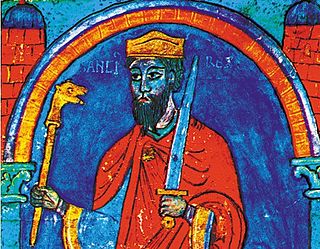
Sancho I of León, nicknamed Sancho the Fat was a king of León twice. He was succeeded in 958 by Ordoño IV and, on his death, by his son Ramiro.
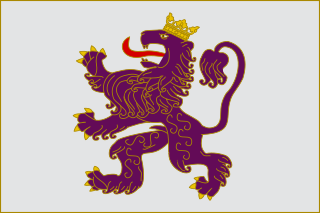
The Kingdom of León was an independent kingdom situated in the northwest region of the Iberian Peninsula. It was founded in 910 when the Christian princes of Asturias along the northern coast of the peninsula shifted their capital from Oviedo to the city of León. The kings of León fought civil wars, wars against neighbouring kingdoms, and campaigns to repel invasions by both the Moors and the Vikings, all in order to protect their kingdom's changing fortunes.
Pope Anastasius I deaths
Pope Anastasius I was the bishop of Rome from 27 November 399 to his death on 19 December 401.
Christian feast day: Lillian Trasher (Episcopal Church)

Lillian Hunt Trasher was an American Christian missionary to Asyut, Egypt, as well as the founder of the first orphanage in Egypt. She is famed as the "Nile Mother" of Egypt.
The veneration of saints in the Episcopal Church is a continuation of an ancient tradition from the early Church which honors important and influential people of the Christian faith. The usage of the term saint is similar to Roman Catholic and Orthodox traditions. Episcopalians believe in the communion of saints in prayer and as such the Episcopal liturgical calendar accommodates feasts for saints.
Christian feast day: O Radix

The O Antiphons are Magnificat antiphons used at vespers on the last seven days of Advent in Western Christian traditions. They likely date to sixth-century Italy, when Boethius refers to the text in The Consolation of Philosophy. They subsequently became one of the key musical features of the days leading up to Christmas.
Christian feast day: Pope Anastasius I
Pope Anastasius I was the bishop of Rome from 27 November 399 to his death on 19 December 401.
Christian feast day: Pope Urban V

Pope Urban V, born Guillaume de Grimoard, was the head of the Catholic Church from 28 September 1362 until his death in December 1370 and was also a member of the Order of Saint Benedict. He was the only Avignon pope to be beatified.
Christian feast day: December 19 (Eastern Orthodox liturgics)

December 18 - Eastern Orthodox liturgical calendar - December 20
Christian feast day: Saint Nicholas Day

Saint Nicholas Day, also called the Feast of Saint Nicholas, observed on 5 December or on 6 December in Western Christian countries, and on 19 December in Eastern Christian countries using the old church Calendar, is the feast day of Saint Nicholas of Myra; it falls within the season of Advent. It is celebrated as a Christian festival with particular regard to Saint Nicholas' reputation as a bringer of gifts, as well as through the attendance of church services.
Goa Liberation Day (Goa, India)

Goa, Daman and Diu Liberation Day is observed on December 19 every year in Goa, India. The Goa Liberation Day is celebrated in commemoration of the Indian armed forces annexing Portuguese-ruled Goa. Also, India was completely free from European rule on this day.

Goa is a state on the southwestern coast of India within the Konkan region, geographically separated from the Deccan highlands by the Western Ghats. It is located between the Indian states of Maharashtra to the north and Karnataka to the east and south, with the Arabian Sea forming its western coast. It is India's smallest state by area and its fourth-smallest by population. Goa has the highest GDP per capita among all Indian states, two and a half times as high as the GDP per capita of the country as a whole. The Eleventh Finance Commission of India named Goa the best-placed state because of its infrastructure, and India's National Commission on Population rated it as having the best quality of life in India. It is the third-highest ranking among Indian states in the human development index.

India, officially the Republic of India, is a country in South Asia. It is the seventh-largest country by area, the second-most populous country, and the most populous democracy in the world. Bounded by the Indian Ocean on the south, the Arabian Sea on the southwest, and the Bay of Bengal on the southeast, it shares land borders with Pakistan to the west; China, Nepal, and Bhutan to the north; and Bangladesh and Myanmar to the east. In the Indian Ocean, India is in the vicinity of Sri Lanka and the Maldives; its Andaman and Nicobar Islands share a maritime border with Thailand, Myanmar, and Indonesia.
National Heroes and Heroines Day (Anguilla)
Holidays in Anguilla are predominantly religious holidays, with a number of additional national holidays. The most important holiday in the Territory is Separation day, which celebrates the separation of the island from Saint Kitts and Nevis.

Anguilla is a British Overseas Territory in the Caribbean. It is one of the most northerly of the Leeward Islands in the Lesser Antilles, lying east of Puerto Rico and the Virgin Islands and directly north of Saint Martin. The territory consists of the main island of Anguilla, approximately 16 miles long by 3 miles (5 km) wide at its widest point, together with a number of much smaller islands and cays with no permanent population. The territory's capital is The Valley. The total land area of the territory is 35 square miles (91 km2), with a population of approximately 15,753 (2021).